Feed aggregator
Comment on A Beginner’s Guide to Drucraft #35: Introduction to Essentia Capacity by Benedict
In reply to Kevin.
Good spot on your part. Yes, and you’ll find out the details this autumn when Book #3 comes out.
Comment on A Beginner’s Guide to Drucraft #35: Introduction to Essentia Capacity by Benedict
In reply to Skeeve.
There are some methods, though they’re pretty esoteric and aren’t in common use.
Rapture
Emily Maguire’s new novel, Rapture, takes as its inspiration the legend of Pope Joan, reworking key elements of the myth to create a brilliant work of great power and beauty.
The story starts in 9th-century Mainz, Germany, where Agnes lives with her father, an English priest. Although his vows include celibacy, Agnes’s father has slept with a local Saxon woman, but her death in childbirth has left him with the responsibility of raising his daughter. Unusually for that time, Agnes is given an education, listening to the intellectual debates at her father’s dinner table. At one of these dinners, she meets Brother Randulf, a monk from Fulda Abbey, and thus begins their relationship. After her father’s untimely death, Randulf agrees to help Agnes disguise herself as a man to become a Benedictine monk. As Brother John, Agnes starts down the path that will lead her to becoming the head of the Roman Catholic church.
There is so much that is compelling about this novel. The writing is absolutely beautiful and often poetic in its intensity. Characterisation is intimate and believable, and Agnes’s perspective gives us a close insight into her views and feelings. The power of the novel lies in this range: Agnes is a person of huge intellect, but it is also her journey to womanhood, something that she initially represses, that becomes a key focus – with tragic consequences. The novel always bears its research lightly; we see the often-conflicted world of the monasteries, alongside the disintegration of the Carolingian dynasty after the death of Charlemagne and the terrible consequences of the ensuing civil war. Maguire depicts some horrific moments with artistic sensitivity and, as much as violence is a part of this world, its inclusion is never gratuitous.
This is a fabulous book for any serious reader of literary historical fiction. Very highly recommended.
The post Rapture appeared first on Historical Novel Society.
State of Emergency
Singapore, 1963. What can you say about a young woman, Siew Li, who walked away, without warning, from her twin children and husband? Jeremy Tiang says a lot as he weaves an always gripping and mostly grim story of people caught up in the long conflict between the forces of the right and left.
That the right won and steered Singapore through a rapid and rare transformation from third world to first is well-known. The story of the communist insurgence in Singapore and Malaysia has faded from public memory, despite works such as Anthony Burgess’s Malayan Trilogy and Yeng Pway Ngon’s Unrest. State of Emergency is a rich addition to this meagre literature.
Told from multiple viewpoints, linked stories connect small, human acts and place them against a larger narrative of ordinary people trapped in times when torture, murder, and massacre are condoned. From the opening scene, the historical MacDonald House bombing, to a fictional end in which Siew Li’s son gets as close to her as he ever will, this is a remarkable blend of the sweep of history and the minutiae of people’s lives.
There is a version of history which peddles the idea that the American invasion of Vietnam could have learned much from the more successful British-led intervention in Malaya. The survivors of Batang Kali (one of whom becomes a narrator for a while) would, of course, disagree. This novel gives them – and the dead – a voice.
I was left wanting to know much more about Siew Li than the author has revealed, even though she tells the story for some stints. There are surprising bloopers about the time zone in Thailand and a jungle being silent at night. On the balance, these are immaterial defects in this great work of historical fiction.
The post State of Emergency appeared first on Historical Novel Society.
Heir of Light preview chapter
Women in SF&F Month 2025: Thank You and Links
Thank you so very much to all of this year’s guests for the excellent essays that made April 2025 another amazing Women in SF&F Month! And thank you to everyone who shared their posts and helped spread the word about this year’s series. It is always very much appreciated! This year’s series has ended, but I wanted to make sure there was a way to find all of the guest posts from 2025. This was the fourteenth annual Women in […]
The post Women in SF&F Month 2025: Thank You and Links first appeared on Fantasy Cafe.Business Musings: Putting Yourself Out There
I do most of my business writing on Patreon these days, but roughly once per month, I’ll put a post for free on this website. This post initially went live on my Patreon page on March 30, 2025. If you go to Patreon, you’ll find other posts like this one.
Putting Yourself Out ThereI’m gearing back up to return to the university in the fall. After a heck of a couple of years, I’m resuming my very slow attempt to get a few extra college degrees. Mostly, it’s an excuse to listen to people much younger than myself learn cool stuff, and an excuse to listen to people somewhat younger than myself share their expertise.
I get inspired by all of that.
I’m searching class schedules and realizing that my Spanish has gotten rusty again, so there is probably a summertime online refresher in the complicated tenses on the horizon. Even though, really, using the proper tense is not my problem so much as finding the correct vocabulary word. As in any word that might suit in that circumstance. The vocabulary was the first thing to flee my brain in the hiatus.
The thing that fascinates me the most, though, is watching the theater kids, particularly those who are (at 18, 19, or 20) convinced they’re going to be Actors! (and yes, the exclamation point is there for a reason). Most won’t be, not because they’re not good enough, but because they don’t listen well and they already think they’re God’s gift to the profession.
Mostly, I watch the ones who are insecurely secure in their dreams. These kids know exactly what they want in their lives, but they’re not sure they’re good enough to get there, so they work extra hard to figure out where they should be.
Sometimes it is not where they expect to be. In the theater department in particular, they have to take courses in all aspects of theater, and they sometimes learn that they love a part of theater that they hadn’t expected to like at all.
Surprisingly enough to my younger self, the one who didn’t have the courage to follow her musical abilities into a music degree or to even walk into the theater department at the University of Wisconsin, there are a lot of introverts in theater. Some of those introverts are writers, yes, but many go onstage and perform. Most, in fact, because they like being someone else in front of a group. It’s safer for them.
I get safe. It makes sense. I also get the fear of doing something revealing in front of a crowd. Mostly, that fear is gone for me now. Years of public speaking and talking on panels at sf conventions eased my mind.
Still, I was pretty shocked when I learned that a lot of actors and musicians suffer severe stage fright—people you’ve all heard of. If they have to go onstage, they sit in the dressing room and shake, or, in some cases, puke, because they’re so scared.
Had I known that…well, I doubt I would have done it, because puking is not something I voluntarily do, even for art…but it certainly would have eased my mind about what for me is relatively minor stage fright (in comparison to what these folks have).
Really, though, it’s what they are willing to do for their dreams and their art. They put themselves out there. More importantly, they figure out how to put themselves out there.
Every year, I have a conversation with at least one of my writing students who is terrified for some reason I never probe of putting their work in front of an audience. It always boils down to the fact that they’re afraid of being seen.
Sidebar from a nearly 65-year-old person who has worked in the arts her entire life: You are never seen. Not in your entirety. You may reveal all of your secrets and no one will care. Or they’ll comment on the portrayal of something minor, like the cat, and kvetch about that. It’s disappointing…and freeing.
However, the fear of being seen is a real and crippling fear, stopping a lot of prose writers and poets from following their dreams. Writers, unlike actors and musicians, can hide from the world. You can use a pen name, set up a legal entity that doesn’t use your real name (in an obvious manner), and never let your picture out into the world.
You can hide and publish your work. That’s the great thing about being a writer.
Usually when a writer figures out their own personal workaround, they put their work on the market, whatever it means for them.
I had one of those discussions this past week with a couple of different writers, some in person, one online, and when I photo-bombed the Writers’ Block webinar on Wednesday.
After that moment on the webinar, I spent a few hours thinking about how universal that fear is among writers. I’ve been in this business almost fifty years now, and I’ve seen it every year.
Then Dean and I watched a little bit of The Voice. We often watch something to rest our poor brains, usually at dinner. We’ve moved away from news (since there’s no way that will relax anyone), and gone to documentaries and The Voice.
We usually watch a segment or two and then go back to whatever we were doing. It will take us days to watch an entire 2-hour episode.
So that Wednesday night, we watched two members of Michael Bublé’s team duet on a song he wrote, called “Home.” Most of you know it as a super hit for Blake Shelton, but Bublé wrote the song and released it first.
Before the battle, Bublé talked a bit about writing the song. I can’t find the clip for that (mostly because I’m lazy, but also because it’s not that relevant), but I did find the one that caught my attention.
It got me thinking, and I went up to my office and made a list.
Most people who work in the arts realize that their work has to be put out into the world.
- People who write music must perform that music to sell that song/sonata/whatever. They may be terrible singers. They might be shy as hell. But they need to make, at minimum, a demo tape.
Often they perform their own work, in some kind of concert, and it is that work that ends up catapulting them into whatever level of fame they will reach.
And then, partly because of the vagaries of the (exceedingly complex) music copyright laws, they may hear someone else cover their song. They might be like John Legend, who has said on The Voice that he cannot listen to a cover of one of his songs fairly. Or they might be like Bublé who not only assigned the song, but was honored by the way the singers performed it.
- People who write plays write them with production in mind. What is the point of writing a play if it’s just going to languish on your desk? The problem, though, with writing a play is that when it is performed, there will be an area that the performers cannot do or cannot say.
In early drafts of a play, the playwright will have to be nearby to do some kind of work to smooth out that section. Sometimes it’s because the star is a doofus and can’t say a word with more than two syllables, but mostly it’s because that section of the show, when performed in previews, did not work. Neil Simon deals with this a lot in his autobiography Rewrites.
- People who write screenplays know that they’re writing something that will be performed as well. I had a very famous writer friend who wrote the wordiest damn screenplays ever and had, in his contract, a clause that said not a word could be touched.
After his early years in Hollywood (when he didn’t have enough clout to have that stupid contract), he rarely sold a screenplay and when he did, it was a charity sale from a friend who would buy the screenplay so that the writer could retain his Writers Guild membership. (And then the charity friend would do a shooting script.)
- Artists know that their paintings or photographs will be displayed or used on covers or put on t-shirts and prints and everything else.
Even the lowest of the low, graffiti “artists,” the ones who deface buildings, understand that their art needs to be seen. (I’m grumpy about graffiti these days since Vegas has a lot of wall murals all over the city—and the freakin’ graffiti “artists” will deface them. Grrr. I hate people who deface other people’s art.)
- Even young poets these days understand that they might have to get up in front of a crowd at a poetry slam and declaim their poem.
- And let’s not talk about comedians, who are also writers, who get in front of a crowd, and risk bombing night after night after night. Dean and I saw one of George Carlin’s shows in his last years, and Carlin was testing material so new that he was holding paper torn from a notepad.
Some of it was funny. Much of it was not.
Fiction writers—people who write novels and short stories—are the only artists I know who expect someone else to publish their work. Fiction writers, particularly those who are traditionally published, believe that all they have to do is write it, and everyone will flock to their feet.
That’s an ingrained attitude, and a hard one to fight. Heck, a lot of these writers are worried when they decide to give a copy of their manuscript to an editor at a book publishing house or (worse) an agent.
Writers do not expect to have their work in the public view, and often fear it.
I’m not sure why this is. I think it’s just part of the culture.
There are movies that show writers at work, and someone else dragging that “brilliant” manuscript off the writer’s desk. Or the writer “gets discovered” in an English class (never happened when I was in school). Or someone else mailed off their manuscript.
That myth goes hand in hand with the idea that writing should be hard and writers should suffer while doing it. That myth also goes with the idea that anything written fast is terrible and anything labored over is brilliant. And that myth goes with the idea that being prolific is a sin. (Tell that to Charles Dickens and William Shakespeare.)
Indie writers have a similar problem, but it’s couched in other terms. I don’t want to learn how to publish. That’s going to be hard. It’ll take too much money or I can’t do covers or…or…
Okay, I want to reply, whatever roadblocks you want to set up for your work, go ahead.
But real artists—be they musicians or painters or (yes) writers—need to have their work seen. They need to figure out how to get on that stage despite their stage fright and put their art in front of an audience.
Otherwise the art will be destroyed when they die, tossed out with the trash or deleted off their computers.
Oh…and let’s talk “covers” for a minute. Blake Shelton’s version of “Home” is very different from Bublé’s version, which is different from the duet that aired on The Voice this past week.
If you’re lucky as a writer, and if you put yourself out there, at some point, someone will want to do make another piece of art using yours as inspiration. Maybe a movie, maybe a TV show, maybe a dramatic reading or an audio book.
That’s a “cover” for lack of a better term. (It really is a derivative work, and it does fall in a different place in the copyright law, but go with me on this for a minute.) Instead of being all protective and saying that you must control all things, say yes…if the contract terms are good.
That’s all.
A singer doesn’t have to get permission to cover a song. I can sing “Home” badly in front of an audience if I want to, but if I get paid for it, I need to let the songwriter know that I’m going to be covering the song. The songwriter cannot say no.
It gets complicated after that. (Okay, it’s already complicated.) But implied in all of this is that the music needs to get in front of an audience. The play will be performed. The screenplay will become the basis for a movie. The painting will hang on a gallery wall.
What makes writer-artists any different? Why should we fight so hard to create something and then be afraid to put it in front of an audience. Particularly since we’ll never see that audience. We don’t have to hear from them either, if we keep our email private and don’t go on social media and don’t read reviews.
What makes fiction writers so dang delicate? Every artist has fears. All of us do. If we want to make a living at our art, we learn to overcome the fear.
It may take a dozen workarounds. It might mean the writing equivalent of puking in the bathroom before stepping on the stage. But if you value your own work and your own dreams, you learn how to get past whatever is stopping you.
Just like other performers do.
“Putting Yourself Out There,” copyright © 2025 by Kristine Kathryn Rusch. Picture of Gavin is there because, despite appearances, he’s terrified of putting himself out there.
Horde Alone And Inheritance Quiz
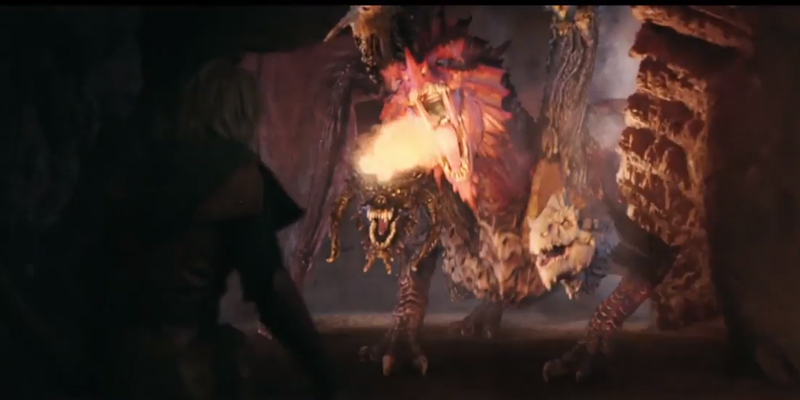
While House Andrews is away (hopefully somewhere gorgeous, where the only monsters are overloaded breakfast waffles), you’re left with me. Mwahahaha.
As always, the result is chaos! Fluffy, nerdy, deeply chalant chaos. Some of you are still trying to marry London though sheer force of headcanon – because would a guy with such good jawline really be capable of betrayal? And who among us hasn’t at one time suggested impromptu post-mortem thumb fingerprint extraction surgery in a toxic monster-infested cave trap? Long live Team Facts Be Damned, you’ve taught me all I know!
The comments have also been busy trying to figure out which Talent would serve us best beyond the gate.
I see you. I hear you. I have made you a thing: The Inheritance Talent Sorting Quiz.
Tried to write it as a ‘choose your own adventure’ story. That’s technically the tank-repairing grandma of LitRPG, so it should work. There are 6 possible results: assessor, tank, blade warden, scout, healer and mining foreman. Sorry chat, you can’t aim for the InBearitance. If we can’t all be Bear, no one can be Bear. It’s only fair.
Gentle note:This is just for fun. Every Talent plays a vital part in helping humanity survive. If you think getting a particular result might ruin your afternoon, it’s perfectly fine to skip the quiz. Bear still loves you.
Also: the newsletter doesn’t like the quiz plugin and sends it out in code. If you read this in email form and want to take the test, click here to come directly to the website.
Long may you survive the breach, BDH! Preferably with all your thumbs.
6668
The Inheritance Talent Quiz
When the first gate tore and monsters came out, everything went sideways. Humans freaked out. A few—not me, I’m a dog—woke up with powers no one could explain. Talents. Some became walking shields. Some turned into stabby-happy blade machines. Some just got very good at finding shinies.
The war is still going. It's time to find your place in the breach. Take the quiz. Get sorted. Don’t die. And bring dog biscuits.
— Bear, Winner of the "Best Girl" Guild Award, 3 years running
1 / 10
You step through the gate. The mist clings to your boots and the air smells like copper and rain. Ahead, alien darkness stretches, waiting.
Before you challenge it, you reach for your talisman. Every diver has one. Something to hold, remember, and ward off the worst. What do you carry?
 A dog tag from someone who didn’t make it. You wear it so no one forgets.
A coin you flip before each gate run. It doesn't matter what you call—it’s not about the outcome, it’s about the toss.
A nugget of rusty breach ore. Worth nothing. Kept it anyway. It hums sometimes.
A loop of thread, torn off from your oldest guild coveralls. It’s frayed. So are you. Still works.
A polished citrine crystal. Your mother said it brings prosperity. You mostly use it as a fidget spinner.
Just a ritual. You whisper your name once, then leave it behind. In the breach, no one can hold you, even by your shadow.
A dog tag from someone who didn’t make it. You wear it so no one forgets.
A coin you flip before each gate run. It doesn't matter what you call—it’s not about the outcome, it’s about the toss.
A nugget of rusty breach ore. Worth nothing. Kept it anyway. It hums sometimes.
A loop of thread, torn off from your oldest guild coveralls. It’s frayed. So are you. Still works.
A polished citrine crystal. Your mother said it brings prosperity. You mostly use it as a fidget spinner.
Just a ritual. You whisper your name once, then leave it behind. In the breach, no one can hold you, even by your shadow.
2 / 10
The first thing you encounter is a grove of bioluminescent fungi, stretching as far as the eye can see. Some pulse with variegated light; others twitch when the air moves. Do you…
 Immediately start cataloguing. Potential resource, possible danger—both matter.
Could it work as potential escape cover for later? Who knows what will be chasing you on your way out.
Clear a path through it—gently, if possible, forcefully if not.
Look for signs of medicinal properties. Even breach-nature heals if you know where to look.
Check whether it grows over something more valuable. You're in this for the income as much as the outcome.
Investigate the wider area while everyone is focused on the mushrooms. Someone has to.
Immediately start cataloguing. Potential resource, possible danger—both matter.
Could it work as potential escape cover for later? Who knows what will be chasing you on your way out.
Clear a path through it—gently, if possible, forcefully if not.
Look for signs of medicinal properties. Even breach-nature heals if you know where to look.
Check whether it grows over something more valuable. You're in this for the income as much as the outcome.
Investigate the wider area while everyone is focused on the mushrooms. Someone has to.
3 / 10
At the other end of the mushroom field, the ground starts to shake underfoot. Debris cascades down the cave walls. Ahead, a narrow tunnel splits left, and a spindly stone bridge stretches right across a deep chasm. Neither path looks safe. Make your choice.
 A "gut instinct" is your experience and perception telling you something before the brain has had the chance to formulate rational thought. You pick the path your intuition dictates.
Not all of you will be able to fit through the narrow tunnel. You test the bridge’s strength with your full weight. If it breaks, better it’s you than the others.
You guard the crossing until everyone else makes it through.
Survival is a priority, but resources are the whole reason the team is here. Which path leads to fewer regrets?
Bah. Rocks. You know rocks. Rocks fall, nobody died. They're overreacting.
Make sure everyone’s stable before committing to either direction.
A "gut instinct" is your experience and perception telling you something before the brain has had the chance to formulate rational thought. You pick the path your intuition dictates.
Not all of you will be able to fit through the narrow tunnel. You test the bridge’s strength with your full weight. If it breaks, better it’s you than the others.
You guard the crossing until everyone else makes it through.
Survival is a priority, but resources are the whole reason the team is here. Which path leads to fewer regrets?
Bah. Rocks. You know rocks. Rocks fall, nobody died. They're overreacting.
Make sure everyone’s stable before committing to either direction.
4 / 10
Good news: your whole team made it across the narrow stone bridge. Bad news: the air here crackles with static. Something hums in your teeth. Only one step into the eerie cold and your comm unit sputters and dies. HQ is gone. Radio silence. What do you do?
 Fall into leadership mode. Contact or no contact, someone needs to take responsibility for the team.
You have no authority here. You can only hope procedure will be maintained.
Mutter a curse and keep working. If it's important, they’ll find you.
Rally the team, keep panic from spreading.
Hold position and fortify your location until a new plan forms.
Double-time it to higher ground to assess the new area. Sooner or later, the order will be to move.
Fall into leadership mode. Contact or no contact, someone needs to take responsibility for the team.
You have no authority here. You can only hope procedure will be maintained.
Mutter a curse and keep working. If it's important, they’ll find you.
Rally the team, keep panic from spreading.
Hold position and fortify your location until a new plan forms.
Double-time it to higher ground to assess the new area. Sooner or later, the order will be to move.
5 / 10
You hear a faint tapping behind a collapsed wall in the new cavern. Comms are still down, so it could be someone from the assault team, trapped. How do you handle it?
 Leave the team to their work and go investigate from a side tunnel.
Clear the rubble with brute strength—there's no time to lose!
Weapon at the ready. Chances are it's foe, not friend.
Have your supplies at hand. You hope it's not too late for whoever's out there.
Use tools to clear rubble efficiently, like you were trained to do.
Evaluate the surroundings and probabilities before you even touch this new problem.
Leave the team to their work and go investigate from a side tunnel.
Clear the rubble with brute strength—there's no time to lose!
Weapon at the ready. Chances are it's foe, not friend.
Have your supplies at hand. You hope it's not too late for whoever's out there.
Use tools to clear rubble efficiently, like you were trained to do.
Evaluate the surroundings and probabilities before you even touch this new problem.
6 / 10
An ambush! There's monster fire as soon as you clear the suspicious tapping wall. Your instincts scream. You react with:
 Shield up, block as much of the damage as possible.
Fall back, analyzing the cavern for counterattack or escape options.
Find cover and prepare to deal with the inevitable.
Stealthily drop a grenade on the enemy from above. Play deadly games, win deadly prizes.
Rush the enemy, cutting your way out.
If it's heavy enough, it's a weapon. I'm not going down today.
Shield up, block as much of the damage as possible.
Fall back, analyzing the cavern for counterattack or escape options.
Find cover and prepare to deal with the inevitable.
Stealthily drop a grenade on the enemy from above. Play deadly games, win deadly prizes.
Rush the enemy, cutting your way out.
If it's heavy enough, it's a weapon. I'm not going down today.
7 / 10
You've escaped the monster ambush, but one of your teammates is down—bad leg wound, bleeding fast. What do you do?
 Assess the wound and try to stop the bleeding immediately.
Carry them without slowing down.
Clear a path for evacuation, with force if necessary.
Look around for that one lichen that acts as a painkiller. They must be in agony.
Find the fastest way back to the gate. Time matters.
Rig a makeshift stretcher out of whatever you have. You'll take turns getting them through this.
Assess the wound and try to stop the bleeding immediately.
Carry them without slowing down.
Clear a path for evacuation, with force if necessary.
Look around for that one lichen that acts as a painkiller. They must be in agony.
Find the fastest way back to the gate. Time matters.
Rig a makeshift stretcher out of whatever you have. You'll take turns getting them through this.
8 / 10
You've been in the breach for a day now and it's taking its toll. You find a mostly intact supply crate dropped by the assault team. What's the first thing you grab?
 The fresh pair of socks. Work conditions are hard and trench foot is harder!
A new can of high-vis spray paint. This breach is loaded!
Med supplies, the severe limb injury is draining ours.
Emergency rations. I need my strength.
Check for any weapons. Even with the safety protocols, we don't want them to fall in enemy hands.
The portable beacon. Escape routes matter more than loot.
The fresh pair of socks. Work conditions are hard and trench foot is harder!
A new can of high-vis spray paint. This breach is loaded!
Med supplies, the severe limb injury is draining ours.
Emergency rations. I need my strength.
Check for any weapons. Even with the safety protocols, we don't want them to fall in enemy hands.
The portable beacon. Escape routes matter more than loot.
9 / 10
You’ve reached the anchor chamber. It’s pulsing at critical mass. Once it ruptures, monsters will flood Earth. But this is also the first chamber you've come across any high-value ore. You have minutes. What do you do?
 Collapse the anchor. We'll find good ore in other breaches.
Slash at anything that comes from the anchor while others mine. We're in a blue threat-level breach, we can take these monsters.
Block the entrance. If creature wants to go through, it won't make it past you.
Get your team out alive. Nothing is worth dying for.
Move out. No looking back.
Secure the ore—fast. After all that, you’re not leaving empty-handed.
Collapse the anchor. We'll find good ore in other breaches.
Slash at anything that comes from the anchor while others mine. We're in a blue threat-level breach, we can take these monsters.
Block the entrance. If creature wants to go through, it won't make it past you.
Get your team out alive. Nothing is worth dying for.
Move out. No looking back.
Secure the ore—fast. After all that, you’re not leaving empty-handed.
10 / 10
As you stumble through the collapsing gate, bloodied and exhausted, one thought burns brightest in your mind. What was most important to you inside the breach?
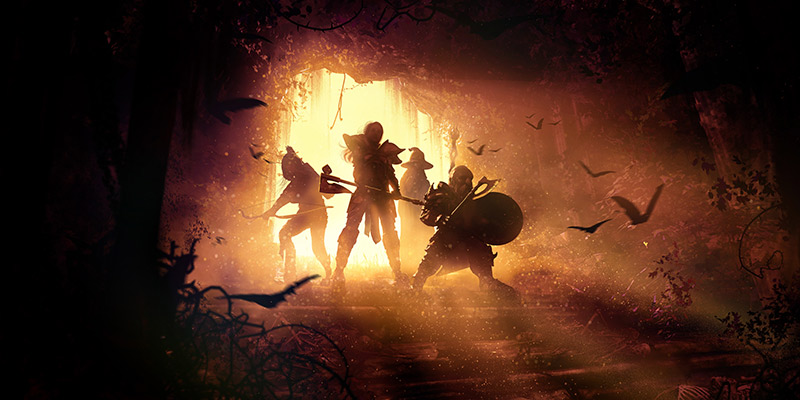 Giving the fight my all.
Understanding the breach so humanity can make the most out of it.
Protecting my team. Always.
Getting everyone out on their own feet.
Having something to show for it. Glory is good, but bonuses feed my kids better.
Outmaneuvering every threat the breach threw at me.
LinkedIn
Facebook
Twitter
VKontakte
div#ays-quiz-container-10 * { box-sizing: border-box; } /* Styles for Internet Explorer start */ #ays-quiz-container-10 #ays_finish_quiz_10 { } /* Styles for Quiz container */ #ays-quiz-container-10{ min-height: 350px; width:400px; background-color:#fff; background-position:center center;border-radius:0px 0px 0px 0px;box-shadow: 0px 0px 15px 1px rgba(0,0,0,0.4);border: none;} /* Styles for Navigation bar */ #ays-quiz-questions-nav-wrap-10 { width: 100%;border-radius:0px 0px 0px 0px;box-shadow: 0px 0px 15px 1px rgba(0,0,0,0.4);border: none;} #ays-quiz-questions-nav-wrap-10 .ays-quiz-questions-nav-content .ays-quiz-questions-nav-item a.ays_questions_nav_question { color: #000; border-color: #000; background-color: #fff; } #ays-quiz-questions-nav-wrap-10 .ays-quiz-questions-nav-content .ays-quiz-questions-nav-item.ays-quiz-questions-nav-item-active a.ays_questions_nav_question { box-shadow: inset 0 0 5px #000, 0 0 5px #000; } #ays-quiz-questions-nav-wrap-10 .ays-quiz-questions-nav-content .ays-quiz-questions-nav-item.ays-quiz-questions-nav-item-answered a.ays_questions_nav_question { color: #fff; border-color: #fff; background-color: #000; } #ays-quiz-questions-nav-wrap-10 .ays-quiz-questions-nav-content .ays-quiz-questions-nav-item a.ays_questions_nav_question.ays_quiz_correct_answer { color: rgba(39, 174, 96, 1); border-color: rgba(39, 174, 96, 1); background-color: rgba(39, 174, 96, 0.4); } #ays-quiz-questions-nav-wrap-10 .ays-quiz-questions-nav-content .ays-quiz-questions-nav-item a.ays_questions_nav_question.ays_quiz_wrong_answer { color: rgba(243, 134, 129, 1); border-color: rgba(243, 134, 129, 1); background-color: rgba(243, 134, 129, 0.4); } /* Styles for questions */ #ays-quiz-container-10 #ays_finish_quiz_10 div.step { min-height: 350px; } /* Styles for text inside quiz container */ #ays-quiz-container-10.ays-quiz-container .ays-questions-container .ays-start-page *:not(input), #ays-quiz-container-10.ays-quiz-container .ays-questions-container .ays_question_hint, #ays-quiz-container-10.ays-quiz-container .ays-questions-container label[for^="ays-answer-"], #ays-quiz-container-10.ays-quiz-container .ays-questions-container p, #ays-quiz-container-10.ays-quiz-container .ays-questions-container .ays-fs-title, #ays-quiz-container-10.ays-quiz-container .ays-questions-container .ays-fs-subtitle, #ays-quiz-container-10.ays-quiz-container .ays-questions-container .logged_in_message, #ays-quiz-container-10.ays-quiz-container .ays-questions-container .ays-quiz-limitation-count-of-takers, #ays-quiz-container-10.ays-quiz-container .ays-questions-container .ays-quiz-limitation-count-of-takers *, #ays-quiz-container-10.ays-quiz-container .ays-questions-container .ays_score_message, #ays-quiz-container-10.ays-quiz-container .ays-questions-container .ays_message{ color: #000; outline: none; } /* Quiz title / transformation */ #ays-quiz-container-10 .ays-fs-title{ text-transform: uppercase; font-size: 21px; text-align: center; text-shadow: none; } #ays-quiz-container-10 .ays-quiz-password-message-box, #ays-quiz-container-10 .ays-quiz-question-note-message-box, #ays-quiz-container-10 .ays_quiz_question, #ays-quiz-container-10 .ays_quiz_question *:not([class^='enlighter']) { color: #000; } #ays-quiz-container-10 textarea, #ays-quiz-container-10 input::first-letter, #ays-quiz-container-10 select::first-letter, #ays-quiz-container-10 option::first-letter { color: initial !important; } #ays-quiz-container-10 p::first-letter:not(.ays_no_questions_message) { color: #000 !important; background-color: transparent !important; font-size: inherit !important; font-weight: inherit !important; float: none !important; line-height: inherit !important; margin: 0 !important; padding: 0 !important; } #ays-quiz-container-10 .select2-container, #ays-quiz-container-10 .ays-field * { font-size: 15px !important; } #ays-quiz-container-10 .ays-fs-subtitle p { text-align: center ; } #ays-quiz-container-10 .ays_quiz_question p { font-size: 16px; text-align: center; } #ays-quiz-container-10 .ays_quiz_question { text-align: center ; margin-bottom: 10px; } #ays-quiz-container-10 .ays_quiz_question pre { max-width: 100%; white-space: break-spaces; } div#ays-quiz-container-10 .ays-questions-container .ays-field, div#ays-quiz-container-10 .ays-questions-container .ays-field input~label[for^='ays-answer-'], div#ays-quiz-container-10 .ays-questions-container .ays-modern-dark-question *, div#ays-quiz-container-10 .ays-questions-container .ays_quiz_question, div#ays-quiz-container-10 .ays-questions-container .ays_quiz_question *{ word-break: break-word; } #ays-quiz-container-10 .ays-quiz-timer p { font-size: 16px; } #ays-quiz-container-10 section.ays_quiz_redirection_timer_container hr, #ays-quiz-container-10 section.ays_quiz_timer_container hr { margin: 0; } #ays-quiz-container-10 section.ays_quiz_timer_container.ays_quiz_timer_red_warning .ays-quiz-timer { color: red; } #ays-quiz-container-10 .ays_thank_you_fs p { text-align: center; } #ays-quiz-container-10 .information_form input[type='text'], #ays-quiz-container-10 .information_form input[type='url'], #ays-quiz-container-10 .information_form input[type='number'], #ays-quiz-container-10 .information_form input[type='email'], #ays-quiz-container-10 .information_form input[type='tel'], #ays-quiz-container-10 .information_form textarea, #ays-quiz-container-10 .information_form select, #ays-quiz-container-10 .information_form option { color: initial !important; outline: none; margin-left: 0; background-image: unset; } #ays-quiz-container-10 .information_form input[type='checkbox'] { margin: 0 10px; outline: initial; -webkit-appearance: auto; -moz-appearance: auto; position: initial; width: initial; height: initial; border: initial; background: initial; } #ays-quiz-container-10 .information_form input[type='checkbox']::after { content: none; } #ays-quiz-container-10 .wrong_answer_text{ color:#ff4d4d; } #ays-quiz-container-10 .right_answer_text{ color:#33cc33; } #ays-quiz-container-10 .right_answer_text p { font-size:16px; } #ays-quiz-container-10 .wrong_answer_text p { font-size:16px; } #ays-quiz-container-10 .ays_questtion_explanation p { font-size:16px; } #ays-quiz-container-10 .ays_cb_and_a, #ays-quiz-container-10 .ays_cb_and_a * { color: rgb(0,0,0); text-align: center; } #ays-quiz-container-10 iframe { /*min-height: 350px;*/ } #ays-quiz-container-10 label.ays_for_checkbox, #ays-quiz-container-10 span.ays_checkbox_for_span { color: initial !important; display: block; } /* Quiz textarea height */ #ays-quiz-container-10 textarea { height: 100px; min-height: 100px; } /* Quiz rate and passed users count */ #ays-quiz-container-10 .ays_quizn_ancnoxneri_qanak, #ays-quiz-container-10 .ays_quiz_rete_avg{ color:#fff; background-color:#000; } #ays-quiz-container-10 .ays-questions-container > .ays_quizn_ancnoxneri_qanak { padding: 5px 20px; } #ays-quiz-container-10 div.for_quiz_rate.ui.star.rating .icon { color: rgba(0,0,0,0.35); } #ays-quiz-container-10 .ays_quiz_rete_avg div.for_quiz_rate_avg.ui.star.rating .icon { color: rgba(255,255,255,0.5); } #ays-quiz-container-10 .ays_quiz_rete .ays-quiz-rate-link-box .ays-quiz-rate-link { color: #000; } /* Loaders */ #ays-quiz-container-10 div.lds-spinner, #ays-quiz-container-10 div.lds-spinner2 { color: #000; } #ays-quiz-container-10 div.lds-spinner div:after, #ays-quiz-container-10 div.lds-spinner2 div:after { background-color: #000; } #ays-quiz-container-10 .lds-circle, #ays-quiz-container-10 .lds-facebook div, #ays-quiz-container-10 .lds-ellipsis div{ background: #000; } #ays-quiz-container-10 .lds-ripple div{ border-color: #000; } #ays-quiz-container-10 .lds-dual-ring::after, #ays-quiz-container-10 .lds-hourglass::after{ border-color: #000 transparent #000 transparent; } /* Stars */ #ays-quiz-container-10 .ui.rating .icon, #ays-quiz-container-10 .ui.rating .icon:before { font-family: Rating !important; } /* Progress bars */ #ays-quiz-container-10 #ays_finish_quiz_10 .ays-progress { border-color: rgba(0,0,0,0.8); } #ays-quiz-container-10 #ays_finish_quiz_10 .ays-progress-bg { background-color: rgba(0,0,0,0.3); } #ays-quiz-container-10 .ays-progress-value { color: #000; text-align: center; } #ays-quiz-container-10 .ays-progress-bar { background-color: #27AE60; } #ays-quiz-container-10 .ays-question-counter .ays-live-bar-wrap { direction:ltr !important; } #ays-quiz-container-10 .ays-live-bar-fill{ color: #000; border-bottom: 2px solid rgba(0,0,0,0.8); text-shadow: 0px 0px 5px #fff; } #ays-quiz-container-10 .ays-live-bar-fill.ays-live-fourth, #ays-quiz-container-10 .ays-live-bar-fill.ays-live-third, #ays-quiz-container-10 .ays-live-bar-fill.ays-live-second { text-shadow: unset; } #ays-quiz-container-10 .ays-live-bar-percent{ display:none; } /* Music, Sound */ #ays-quiz-container-10 .ays_music_sound { color:rgb(0,0,0); } /* Dropdown questions scroll bar */ #ays-quiz-container-10 blockquote { border-left-color: #000 !important; } /* Quiz Password */ #ays-quiz-container-10 .ays-start-page > input[id^='ays_quiz_password_val_'], #ays-quiz-container-10 .ays-quiz-password-toggle-visibility-box { width: 100%; margin: 0 auto; } /* Question hint */ #ays-quiz-container-10 .ays_question_hint_container .ays_question_hint_text { background-color:#fff; box-shadow: 0 0 15px 3px rgba(0,0,0,0.6); max-width: 270px; } #ays-quiz-container-10 .ays_question_hint_container .ays_question_hint_text p { max-width: unset; } #ays-quiz-container-10 .ays_questions_hint_max_width_class { max-width: 80%; } /* Information form */ #ays-quiz-container-10 .ays-form-title{ color:rgb(0,0,0); } /* Quiz timer */ #ays-quiz-container-10 div.ays-quiz-redirection-timer, #ays-quiz-container-10 div.ays-quiz-timer{ color: #000; text-align: center; } #ays-quiz-container-10 div.ays-quiz-timer.ays-quiz-message-before-timer:before { font-weight: 500; } /* Quiz buttons */ #ays-quiz-container-10 input#ays-submit, #ays-quiz-container-10 #ays_finish_quiz_10 .action-button, div#ays-quiz-container-10 #ays_finish_quiz_10 .action-button.ays_restart_button { background-color: #27AE60; color:#333; font-size: 17px; padding: 10px 20px; border-radius: 3px; white-space: nowrap; letter-spacing: 0; box-shadow: unset; white-space: normal; word-break: break-word; } #ays-quiz-container-10 input#ays-submit, #ays-quiz-container-10 #ays_finish_quiz_10 input.action-button { } #ays-quiz-container-10 #ays_finish_quiz_10 a[class~=ajax_add_to_cart]{ background-color: #fff; color:#333; padding: 10px 5px; font-size: 14px; border-radius: 3px; white-space: nowrap; border: 1px solid #333; } #ays-quiz-container-10 #ays_finish_quiz_10 .action-button.ays_check_answer { padding: 5px 10px; font-size: 17px !important; } #ays-quiz-container-10 #ays_finish_quiz_10 .action-button.ays_download_certificate { white-space: nowrap; padding: 5px 10px; } #ays-quiz-container-10 #ays_finish_quiz_10 .action-button.ays_arrow { color:#333!important; white-space: nowrap; padding: 5px 10px; } #ays-quiz-container-10 input#ays-submit:hover, #ays-quiz-container-10 input#ays-submit:focus, #ays-quiz-container-10 #ays_finish_quiz_10 .action-button:hover, #ays-quiz-container-10 #ays_finish_quiz_10 .action-button:focus { box-shadow: 0 0 0 2px #333; background-color: #27AE60; } #ays-quiz-container-10 .ays_restart_button { color: #333; } #ays-quiz-container-10 .ays_restart_button_p { display: flex; justify-content: center; flex-wrap: wrap; } #ays-quiz-container-10 .ays_buttons_div { justify-content: center; } #ays-quiz-container-10 .step:first-of-type .ays_buttons_div { justify-content: center !important; } #ays-quiz-container-10 input[type='button'], #ays-quiz-container-10 input[type='submit'] { color: #333 !important; outline: none; } #ays-quiz-container-10 #ays_finish_quiz_10 i.ays_early_finish.action-button[disabled]:hover, #ays-quiz-container-10 #ays_finish_quiz_10 i.ays_early_finish.action-button[disabled]:focus, #ays-quiz-container-10 #ays_finish_quiz_10 i.ays_early_finish.action-button[disabled], #ays-quiz-container-10 #ays_finish_quiz_10 i.ays_arrow.action-button[disabled]:hover, #ays-quiz-container-10 #ays_finish_quiz_10 i.ays_arrow.action-button[disabled]:focus, #ays-quiz-container-10 #ays_finish_quiz_10 i.ays_arrow.action-button[disabled] { color: #aaa !important; } #ays-quiz-container-10 .ays_finish.action-button{ margin: 10px 5px; } #ays-quiz-container-10 .ays-share-btn.ays-share-btn-branded { color: #fff; } /* Question answers */ #ays-quiz-container-10 .ays-field { border-color: #444; border-style: solid; border-width: 1px; box-shadow: none;flex-direction: row-reverse; } #ays-quiz-container-10 .ays-quiz-answers .ays-field:hover{ opacity: 1; } #ays-quiz-container-10 #ays_finish_quiz_10 .ays-field label.ays_answer_caption[for^='ays-answer-'] { z-index: 1; position:initial;bottom:0;} #ays-quiz-container-10 #ays_finish_quiz_10 .ays-field input~label[for^='ays-answer-'] { padding: 5px; } #ays-quiz-container-10 #ays_finish_quiz_10 .ays-field { margin-bottom: 10px; } #ays-quiz-container-10 #ays_finish_quiz_10 .ays-field.ays_grid_view_item { width: calc(50% - 5px); } #ays-quiz-container-10 #ays_finish_quiz_10 .ays-field.ays_grid_view_item:nth-child(odd) { margin-right: 5px; } #ays-quiz-container-10 #ays_finish_quiz_10 .ays-field input:checked+label:before { border-color: #27AE60; background: #27AE60; background-clip: content-box; } #ays-quiz-container-10 .ays-quiz-answers div.ays-text-right-answer { color: #000; } /* Answer maximum length of a text field */ #ays-quiz-container-10 .ays_quiz_question_text_message{ color: #000; text-align: left; font-size: 12px; } div#ays-quiz-container-10 div.ays_quiz_question_text_error_message { color: #ff0000; } /* Questions answer image */ #ays-quiz-container-10 .ays-answer-image { width:15em; height:150px; object-fit: cover; } /* Questions answer right/wrong icons */ #ays-quiz-container-10 .ays-field input~label.answered.correct:after{ content: url('http://ilona-andrews.com/wp-content/plugins/quiz-maker/public/images/correct.png'); } #ays-quiz-container-10 .ays-field input~label.answered.wrong:after{ content: url('http://ilona-andrews.com/wp-content/plugins/quiz-maker/public/images/wrong.png'); } #ays-quiz-container-10 .ays-field label.answered:last-of-type:after{ height: auto; left: 10px;top: 10px;} /* Dropdown questions */ #ays-quiz-container-10 .select2-container--default .select2-search--dropdown .select2-search__field:focus, #ays-quiz-container-10 .select2-container--default .select2-search--dropdown .select2-search__field { outline: unset; padding: 0.75rem; } #ays-quiz-container-10 #ays_finish_quiz_10 .ays-field .select2-container--default .select2-selection--single { border-bottom: 2px solid #27AE60; background-color: #27AE60; } #ays-quiz-container-10 .ays-field .select2-container--default .select2-selection--single .select2-selection__rendered, #ays-quiz-container-10 .ays-field .select2-container--default .select2-selection--single .select2-selection__placeholder, #ays-quiz-container-10 .ays-field .select2-container--default .select2-selection--single .select2-selection__arrow { color: #d8519f; } #ays-quiz-container-10 .ays-field .select2-container--default .select2-selection--single .select2-selection__rendered, #ays-quiz-container-10 .select2-container--default .select2-results__option--highlighted[aria-selected] { background-color: #27AE60; } #ays-quiz-container-10 .ays-field .select2-container--default, #ays-quiz-container-10 .ays-field .select2-container--default .selection, #ays-quiz-container-10 .ays-field .select2-container--default .dropdown-wrapper, #ays-quiz-container-10 .ays-field .select2-container--default .select2-selection--single .select2-selection__rendered, #ays-quiz-container-10 .ays-field .select2-container--default .select2-selection--single .select2-selection__rendered .select2-selection__placeholder, #ays-quiz-container-10 .ays-field .select2-container--default .select2-selection--single .select2-selection__arrow, #ays-quiz-container-10 .ays-field .select2-container--default .select2-selection--single .select2-selection__arrow b[role='presentation'] { font-size: 16px !important; } #ays-quiz-container-10 .select2-container--default .select2-results__option { padding: 6px; } /* Dropdown questions scroll bar */ #ays-quiz-container-10 .select2-results__options::-webkit-scrollbar { width: 7px; } #ays-quiz-container-10 .select2-results__options::-webkit-scrollbar-track { background-color: rgba(255,255,255,0.35); } #ays-quiz-container-10 .select2-results__options::-webkit-scrollbar-thumb { transition: .3s ease-in-out; background-color: rgba(255,255,255,0.55); } #ays-quiz-container-10 .select2-results__options::-webkit-scrollbar-thumb:hover { transition: .3s ease-in-out; background-color: rgba(255,255,255,0.85); } /* WooCommerce product */ #ays-quiz-container-10 .ays-woo-block { background-color: rgba(39,174,96,0.8); } #ays-quiz-container-10 .ays-woo-product-block h4.ays-woo-product-title > a { color: #000; } /* Audio / Video */ #ays-quiz-container-10 .mejs-container .mejs-time{ box-sizing: unset; } #ays-quiz-container-10 .mejs-container .mejs-time-rail { padding-top: 15px; } #ays-quiz-container-10 .mejs-container .mejs-mediaelement video { margin: 0; } /* Limitation */ #ays-quiz-container-10 .ays-quiz-limitation-count-of-takers { padding: 50px; } #ays-quiz-container-10 div.ays-quiz-results-toggle-block span.ays-show-res-toggle.ays-res-toggle-show, #ays-quiz-container-10 div.ays-quiz-results-toggle-block span.ays-show-res-toggle.ays-res-toggle-hide{ color: #000; } #ays-quiz-container-10 div.ays-quiz-results-toggle-block input:checked + label.ays_switch_toggle { border: 1px solid #000; } #ays-quiz-container-10 div.ays-quiz-results-toggle-block input:checked + label.ays_switch_toggle { border: 1px solid #000; } #ays-quiz-container-10 div.ays-quiz-results-toggle-block input:checked + label.ays_switch_toggle:after{ background: #000; } #ays-quiz-container-10.ays_quiz_elegant_dark div.ays-quiz-results-toggle-block input:checked + label.ays_switch_toggle:after, #ays-quiz-container-10.ays_quiz_rect_dark div.ays-quiz-results-toggle-block input:checked + label.ays_switch_toggle:after{ background: #000; } /* Hestia theme (Version: 3.0.16) | Start */ #ays-quiz-container-10 .mejs-container .mejs-inner .mejs-controls .mejs-button > button:hover, #ays-quiz-container-10 .mejs-container .mejs-inner .mejs-controls .mejs-button > button { box-shadow: unset; background-color: transparent; } #ays-quiz-container-10 .mejs-container .mejs-inner .mejs-controls .mejs-button > button { margin: 10px 6px; } /* Hestia theme (Version: 3.0.16) | End */ /* Go theme (Version: 1.4.3) | Start */ #ays-quiz-container-10 label[for^='ays-answer']:before, #ays-quiz-container-10 label[for^='ays-answer']:before { -webkit-mask-image: unset; mask-image: unset; } #ays-quiz-container-10.ays_quiz_classic_light .ays-field input:checked+label.answered:before, #ays-quiz-container-10.ays_quiz_classic_dark .ays-field input:checked+label.answered:before { background-color: #27AE60 !important; } #ays-quiz-container-10.ays_quiz_classic_light .ays-field input:checked+label.answered.correct:before, #ays-quiz-container-10.ays_quiz_classic_dark .ays-field input:checked+label.answered.correct:before { background-color: #27ae60 !important; } #ays-quiz-container-10.ays_quiz_classic_light .ays-field input:checked+label.answered.wrong:before, #ays-quiz-container-10.ays_quiz_classic_dark .ays-field input:checked+label.answered.wrong:before { background-color: #cc3700 !important; } /* Go theme (Version: 1.4.3) | End */ #ays-quiz-container-10 .ays_quiz_results fieldset.ays_fieldset .ays_quiz_question .wp-video { width: 100% !important; max-width: 100%; } /* Classic Dark / Classic Light */ /* Dropdown questions right/wrong styles */ #ays-quiz-container-10.ays_quiz_classic_dark .correct_div, #ays-quiz-container-10.ays_quiz_classic_light .correct_div{ border-color: green !important; opacity: 1 !important; background-color: rgba(39,174,96,0.4) !important; } #ays-quiz-container-10.ays_quiz_classic_dark .correct_div .selected-field, #ays-quiz-container-10.ays_quiz_classic_light .correct_div .selected-field { padding: 0px 10px 0px 10px; color: green !important; } #ays-quiz-container-10.ays_quiz_classic_dark .wrong_div, #ays-quiz-container-10.ays_quiz_classic_light .wrong_div{ border-color: red !important; opacity: 1 !important; background-color: rgba(243,134,129,0.4) !important; } #ays-quiz-container-10.ays_quiz_classic_dark .ays-field.checked_answer_div.wrong_div input:checked~label, #ays-quiz-container-10.ays_quiz_classic_light .ays-field.checked_answer_div.wrong_div input:checked~label { background-color: rgba(243,134,129,0.4) !important; } #ays-quiz-container-10 .ays_question_result .ays-field .ays_quiz_hide_correct_answer:after{ content: '' !important; } #ays-quiz-container-10 .ays-quiz-close-full-screen { fill: #000; } #ays-quiz-container-10 .ays-quiz-open-full-screen { fill: #000; } @media screen and (max-width: 768px){ #ays-quiz-container-10{ max-width: 100%; } div#ays-quiz-container-10.ays_quiz_modern_light .step, div#ays-quiz-container-10.ays_quiz_modern_dark .step { padding-right: 0px !important; padding-top: 0px !important; } div#ays-quiz-container-10.ays_quiz_modern_light div.step[data-question-id], div#ays-quiz-container-10.ays_quiz_modern_dark div.step[data-question-id] { background-size: cover !important; background-position: center center !important; } div#ays-quiz-container-10.ays_quiz_modern_light .ays-abs-fs:not(.ays-start-page):not(.ays-end-page), div#ays-quiz-container-10.ays_quiz_modern_dark .ays-abs-fs:not(.ays-start-page):not(.ays-end-page) { width: 100%; } #ays-quiz-container-10 .ays_quiz_question p { font-size: 16px; } #ays-quiz-container-10 .select2-container, #ays-quiz-container-10 .ays-field * { font-size: 15px !important; } div#ays-quiz-container-10 input#ays-submit, div#ays-quiz-container-10 #ays_finish_quiz_10 .action-button, div#ays-quiz-container-10 #ays_finish_quiz_10 .action-button.ays_restart_button { font-size: 17px; } div#ays-quiz-container-10 div.ays-questions-container div.ays-woo-block { width: 100%; } /* Quiz title / mobile font size */ div#ays-quiz-container-10 .ays-fs-title { font-size: 21px; } } /* Custom css styles */ /* RTL direction styles */
#ays-quiz-container-10 p {
margin: 0.625em;
}
#ays-quiz-container-10 .ays-field.checked_answer_div input:checked~label {
background-color: rgba(39,174,96,0.6);
}
#ays-quiz-container-10.ays_quiz_classic_light .enable_correction .ays-field.checked_answer_div input:checked+label,
#ays-quiz-container-10.ays_quiz_classic_dark .enable_correction .ays-field.checked_answer_div input:checked+label {
background-color: transparent;
}
#ays-quiz-container-10.ays-quiz-container.ays_quiz_classic_light .ays-questions-container .ays-field:hover label[for^='ays-answer-'],
#ays-quiz-container-10 .ays-field:hover{
background: rgba(39,174,96,0.8);
color: #fff;
transition: all .3s;
}
#ays-quiz-container-10 #ays_finish_quiz_10 .action-button:hover,
#ays-quiz-container-10 #ays_finish_quiz_10 .action-button:focus {
box-shadow: 0 0 0 2px rgba(255, 255, 255, 0.5), 0 0 0 3px #333;
background: #27AE60;
}
if(typeof aysQuizOptions === 'undefined'){
var aysQuizOptions = [];
}
aysQuizOptions['10'] = 'eyJxdWl6X3ZlcnNpb24iOiI4LjcuNCIsImNvcmVfdmVyc2lvbiI6IjYuOCIsInBocF92ZXJzaW9uIjoiOC4yLjI4IiwiY29sb3IiOiIjMjdBRTYwIiwiYmdfY29sb3IiOiIjZmZmIiwidGV4dF9jb2xvciI6IiMwMDAiLCJoZWlnaHQiOjM1MCwid2lkdGgiOjQwMCwiZW5hYmxlX2xvZ2dlZF91c2VycyI6Im9mZiIsImluZm9ybWF0aW9uX2Zvcm0iOiJkaXNhYmxlIiwiZm9ybV9uYW1lIjoib2ZmIiwiZm9ybV9lbWFpbCI6Im9mZiIsImZvcm1fcGhvbmUiOiJvZmYiLCJpbWFnZV93aWR0aCI6IiIsImltYWdlX2hlaWdodCI6IiIsImVuYWJsZV9jb3JyZWN0aW9uIjoib2ZmIiwiZW5hYmxlX3Byb2dyZXNzX2JhciI6Im9mZiIsImVuYWJsZV9xdWVzdGlvbnNfcmVzdWx0Ijoib2ZmIiwicmFuZG9taXplX3F1ZXN0aW9ucyI6Im9mZiIsInJhbmRvbWl6ZV9hbnN3ZXJzIjoib2ZmIiwiZW5hYmxlX3F1ZXN0aW9uc19jb3VudGVyIjoib24iLCJlbmFibGVfcmVzdHJpY3Rpb25fcGFzcyI6Im9mZiIsImVuYWJsZV9yZXN0cmljdGlvbl9wYXNzX3VzZXJzIjoib2ZmIiwicmVzdHJpY3Rpb25fcGFzc19tZXNzYWdlIjoiIiwicmVzdHJpY3Rpb25fcGFzc191c2Vyc19tZXNzYWdlIjoiIiwidXNlcl9yb2xlIjpbXSwiYXlzX3VzZXJzX3NlYXJjaCI6W10sImN1c3RvbV9jc3MiOiIiLCJsaW1pdF91c2VycyI6Im9mZiIsImxpbWl0YXRpb25fbWVzc2FnZSI6IiIsInJlZGlyZWN0X3VybCI6IiIsInJlZGlyZWN0aW9uX2RlbGF5IjowLCJhbnN3ZXJzX3ZpZXciOiJsaXN0IiwiZW5hYmxlX3J0bF9kaXJlY3Rpb24iOiJvZmYiLCJlbmFibGVfbG9nZ2VkX3VzZXJzX21lc3NhZ2UiOiIiLCJxdWVzdGlvbnNfY291bnQiOiIiLCJlbmFibGVfcXVlc3Rpb25fYmFuayI6Im9mZiIsImVuYWJsZV9saXZlX3Byb2dyZXNzX2JhciI6Im9mZiIsImVuYWJsZV9wZXJjZW50X3ZpZXciOiJvZmYiLCJlbmFibGVfYXZlcmFnZV9zdGF0aXN0aWNhbCI6Im9mZiIsImVuYWJsZV9uZXh0X2J1dHRvbiI6Im9mZiIsImVuYWJsZV9wcmV2aW91c19idXR0b24iOiJvZmYiLCJlbmFibGVfYXJyb3dzIjoib2ZmIiwidGltZXJfdGV4dCI6IiIsInF1aXpfdGhlbWUiOiJjbGFzc2ljX2xpZ2h0IiwiZW5hYmxlX3NvY2lhbF9idXR0b25zIjoib24iLCJmaW5hbF9yZXN1bHRfdGV4dCI6IiIsImVuYWJsZV9wYXNzX2NvdW50Ijoib24iLCJoaWRlX3Njb3JlIjoib24iLCJyYXRlX2Zvcm1fdGl0bGUiOiIiLCJib3hfc2hhZG93X2NvbG9yIjoiIzAwMCIsInF1aXpfYm9yZGVyX3JhZGl1cyI6IjAiLCJxdWl6X2JnX2ltYWdlIjoiIiwicXVpel9ib3JkZXJfd2lkdGgiOiIxIiwicXVpel9ib3JkZXJfc3R5bGUiOiJzb2xpZCIsInF1aXpfYm9yZGVyX2NvbG9yIjoiIzAwMCIsInF1aXpfbG9hZGVyIjoiZGVmYXVsdCIsInF1ZXN0X2FuaW1hdGlvbiI6InNoYWtlIiwiZW5hYmxlX2JnX211c2ljIjoib2ZmIiwicXVpel9iZ19tdXNpYyI6IiIsImFuc3dlcnNfZm9udF9zaXplIjoxNSwic2hvd19jcmVhdGVfZGF0ZSI6Im9mZiIsInNob3dfYXV0aG9yIjoib2ZmIiwiZW5hYmxlX2Vhcmx5X2ZpbmlzaCI6Im9mZiIsImFuc3dlcnNfcndfdGV4dHMiOiJkaXNhYmxlIiwiZGlzYWJsZV9zdG9yZV9kYXRhIjoib2ZmIiwiZW5hYmxlX2JhY2tncm91bmRfZ3JhZGllbnQiOiJvZmYiLCJiYWNrZ3JvdW5kX2dyYWRpZW50X2NvbG9yXzEiOiIjMDAwIiwiYmFja2dyb3VuZF9ncmFkaWVudF9jb2xvcl8yIjoiI2ZmZiIsInF1aXpfZ3JhZGllbnRfZGlyZWN0aW9uIjoidmVydGljYWwiLCJyZWRpcmVjdF9hZnRlcl9zdWJtaXQiOiJvZmYiLCJzdWJtaXRfcmVkaXJlY3RfdXJsIjoiIiwic3VibWl0X3JlZGlyZWN0X2RlbGF5IjoiMCIsInByb2dyZXNzX2Jhcl9zdHlsZSI6ImZpcnN0IiwiZW5hYmxlX2V4aXRfYnV0dG9uIjoib2ZmIiwiZXhpdF9yZWRpcmVjdF91cmwiOiIiLCJpbWFnZV9zaXppbmciOiJjb3ZlciIsInF1aXpfYmdfaW1hZ2VfcG9zaXRpb24iOiJjZW50ZXIgY2VudGVyIiwiY3VzdG9tX2NsYXNzIjoiIiwiZW5hYmxlX3NvY2lhbF9saW5rcyI6Im9mZiIsInNvY2lhbF9saW5rcyI6eyJsaW5rZWRpbl9saW5rIjoiIiwiZmFjZWJvb2tfbGluayI6IiIsInR3aXR0ZXJfbGluayI6IiIsInZrb250YWt0ZV9saW5rIjoiIiwiaW5zdGFncmFtX2xpbmsiOiIiLCJ5b3V0dWJlX2xpbmsiOiIifSwic2hvd19xdWl6X3RpdGxlIjoib24iLCJzaG93X3F1aXpfZGVzYyI6Im9uIiwic2hvd19sb2dpbl9mb3JtIjoib2ZmIiwibW9iaWxlX21heF93aWR0aCI6IiIsImxpbWl0X3VzZXJzX2J5IjoiaXAiLCJleHBsYW5hdGlvbl90aW1lIjoiNCIsImVuYWJsZV9jbGVhcl9hbnN3ZXIiOiJvZmYiLCJzaG93X2NhdGVnb3J5Ijoib2ZmIiwic2hvd19xdWVzdGlvbl9jYXRlZ29yeSI6Im9mZiIsImFuc3dlcnNfcGFkZGluZyI6IjUiLCJhbnN3ZXJzX2JvcmRlciI6Im9uIiwiYW5zd2Vyc19ib3JkZXJfd2lkdGgiOiIxIiwiYW5zd2Vyc19ib3JkZXJfc3R5bGUiOiJzb2xpZCIsImFuc3dlcnNfYm9yZGVyX2NvbG9yIjoiIzQ0NCIsImFuc19pbWdfaGVpZ2h0IjoiMTUwIiwiYW5zX2ltZ19jYXB0aW9uX3N0eWxlIjoib3V0c2lkZSIsImFuc19pbWdfY2FwdGlvbl9wb3NpdGlvbiI6ImJvdHRvbSIsImFuc3dlcnNfYm94X3NoYWRvdyI6Im9mZiIsImFuc3dlcnNfYm94X3NoYWRvd19jb2xvciI6IiMwMDAiLCJzaG93X2Fuc3dlcnNfY2FwdGlvbiI6Im9uIiwiYW5zd2Vyc19tYXJnaW4iOjEwLCJhbnNfcmlnaHRfd3JvbmdfaWNvbiI6ImRlZmF1bHQiLCJkaXNwbGF5X3Njb3JlIjoiYnlfcG9pbnRzIiwiZW5hYmxlX3J3X2FzbndlcnNfc291bmRzIjoib2ZmIiwicXVpel9iZ19pbWdfaW5fZmluaXNoX3BhZ2UiOiJvZmYiLCJmaW5pc2hfYWZ0ZXJfd3JvbmdfYW5zd2VyIjoib2ZmIiwiYWZ0ZXJfdGltZXJfdGV4dCI6IiIsImVuYWJsZV9lbnRlcl9rZXkiOiJvbiIsInNob3dfcmF0ZV9hZnRlcl9yYXRlIjoib24iLCJidXR0b25zX3RleHRfY29sb3IiOiIjMzMzIiwiYnV0dG9uc19wb3NpdGlvbiI6ImNlbnRlciIsImJ1dHRvbnNfc2l6ZSI6Im1lZGl1bSIsImJ1dHRvbnNfZm9udF9zaXplIjoiMTciLCJidXR0b25zX3dpZHRoIjoiIiwiYnV0dG9uc19sZWZ0X3JpZ2h0X3BhZGRpbmciOiIyMCIsImJ1dHRvbnNfdG9wX2JvdHRvbV9wYWRkaW5nIjoiMTAiLCJidXR0b25zX2JvcmRlcl9yYWRpdXMiOiIzIiwiZW5hYmxlX2F1ZGlvX2F1dG9wbGF5Ijoib2ZmIiwiZW5hYmxlX2xlYXZlX3BhZ2UiOiJvbiIsInNob3dfb25seV93cm9uZ19hbnN3ZXIiOiJvZmYiLCJwYXNzX3Njb3JlIjowLCJwYXNzX3Njb3JlX21lc3NhZ2UiOiI8aDQgc3R5bGU9XCJ0ZXh0LWFsaWduOiBjZW50ZXI7XCI+Q29uZ3JhdHVsYXRpb25zITxcL2g0PlxyXG48cCBzdHlsZT1cInRleHQtYWxpZ246IGNlbnRlcjtcIj5Zb3UgcGFzc2VkIHRoZSBxdWl6ITxcL3A+IiwiZmFpbF9zY29yZV9tZXNzYWdlIjoiPGg0IHN0eWxlPVwidGV4dC1hbGlnbjogY2VudGVyO1wiPk9vcHMhPFwvaDQ+XHJcbjxwIHN0eWxlPVwidGV4dC1hbGlnbjogY2VudGVyO1wiPllvdSBoYXZlIG5vdCBwYXNzZWQgdGhlIHF1aXohXHJcblRyeSBhZ2FpbiE8XC9wPiIsImFuc3dlcnNfb2JqZWN0X2ZpdCI6ImNvdmVyIiwicXVpel9tYXhfcGFzc19jb3VudCI6MSwicXVlc3Rpb25fZm9udF9zaXplIjoxNiwicXVpel93aWR0aF9ieV9wZXJjZW50YWdlX3B4IjoicGl4ZWxzIiwicXVlc3Rpb25zX2hpbnRfaWNvbl9vcl90ZXh0IjoiaGlkZSIsInF1ZXN0aW9uc19oaW50X3ZhbHVlIjoiIiwiZW5hYmxlX2Vhcmx5X2ZpbnNoX2NvbWZpcm1fYm94Ijoib24iLCJoaWRlX2NvcnJlY3RfYW5zd2VycyI6Im9mZiIsInF1aXpfbG9hZGVyX3RleHRfdmFsdWUiOiIiLCJzaG93X2luZm9ybWF0aW9uX2Zvcm0iOiJvbiIsInNob3dfcXVlc3Rpb25zX2V4cGxhbmF0aW9uIjoiZGlzYWJsZSIsImVuYWJsZV9xdWVzdGlvbnNfb3JkZXJpbmdfYnlfY2F0Ijoib2ZmIiwiZW5hYmxlX3NlbmRfbWFpbF90b191c2VyX2J5X3Bhc3Nfc2NvcmUiOiJvZmYiLCJlbmFibGVfc2VuZF9tYWlsX3RvX2FkbWluX2J5X3Bhc3Nfc2NvcmUiOiJvZmYiLCJzaG93X3F1ZXN0aW9uc19udW1iZXJpbmciOiJub25lIiwic2hvd19hbnN3ZXJzX251bWJlcmluZyI6Im5vbmUiLCJxdWl6X2xvYWRlcl9jdXN0b21fZ2lmIjoiIiwiZGlzYWJsZV9ob3Zlcl9lZmZlY3QiOiJvZmYiLCJxdWl6X2xvYWRlcl9jdXN0b21fZ2lmX3dpZHRoIjoxMDAsInF1aXpfdGl0bGVfdHJhbnNmb3JtYXRpb24iOiJ1cHBlcmNhc2UiLCJxdWl6X2ltYWdlX3dpZHRoX2J5X3BlcmNlbnRhZ2VfcHgiOiJwaXhlbHMiLCJxdWl6X2ltYWdlX2hlaWdodCI6IiIsInF1aXpfYmdfaW1nX29uX3N0YXJ0X3BhZ2UiOiJvZmYiLCJxdWl6X2JveF9zaGFkb3dfeF9vZmZzZXQiOjAsInF1aXpfYm94X3NoYWRvd195X29mZnNldCI6MCwicXVpel9ib3hfc2hhZG93X3pfb2Zmc2V0IjoxNSwicXVpel9xdWVzdGlvbl90ZXh0X2FsaWdubWVudCI6ImNlbnRlciIsInF1aXpfYXJyb3dfdHlwZSI6ImRlZmF1bHQiLCJxdWl6X3Nob3dfd3JvbmdfYW5zd2Vyc19maXJzdCI6Im9mZiIsInF1aXpfZGlzcGxheV9hbGxfcXVlc3Rpb25zIjoib2ZmIiwicXVpel90aW1lcl9yZWRfd2FybmluZyI6Im9mZiIsInF1aXpfc2NoZWR1bGVfdGltZXpvbmUiOiJVVEMtNiIsInF1ZXN0aW9uc19oaW50X2J1dHRvbl92YWx1ZSI6IiIsInF1aXpfdGFja2Vyc19tZXNzYWdlIjoiVGhpcyBxdWl6IGlzIGV4cGlyZWQhIiwicXVpel9lbmFibGVfbGlua2VkaW5fc2hhcmVfYnV0dG9uIjoib24iLCJxdWl6X2VuYWJsZV9mYWNlYm9va19zaGFyZV9idXR0b24iOiJvbiIsInF1aXpfZW5hYmxlX3R3aXR0ZXJfc2hhcmVfYnV0dG9uIjoib24iLCJxdWl6X2VuYWJsZV92a29udGFrdGVfc2hhcmVfYnV0dG9uIjoib24iLCJxdWl6X21ha2VfcmVzcG9uc2VzX2Fub255bW91cyI6Im9mZiIsInF1aXpfbWFrZV9hbGxfcmV2aWV3X2xpbmsiOiJvZmYiLCJxdWl6X21lc3NhZ2VfYmVmb3JlX3RpbWVyIjoiIiwicXVpel9wYXNzd29yZF9tZXNzYWdlIjoiIiwiZW5hYmxlX3NlZV9yZXN1bHRfY29uZmlybV9ib3giOiJvZmYiLCJkaXNwbGF5X2ZpZWxkc19sYWJlbHMiOiJvZmYiLCJxdWl6X2VuYWJsZV9wYXNzd29yZF92aXNpYmlsaXR5Ijoib2ZmIiwicXVlc3Rpb25fbW9iaWxlX2ZvbnRfc2l6ZSI6MTYsImFuc3dlcnNfbW9iaWxlX2ZvbnRfc2l6ZSI6MTUsInNvY2lhbF9idXR0b25zX2hlYWRpbmciOiIiLCJzb2NpYWxfbGlua3NfaGVhZGluZyI6IiIsInF1aXpfZW5hYmxlX3F1ZXN0aW9uX2NhdGVnb3J5X2Rlc2NyaXB0aW9uIjoib2ZmIiwicXVpel9tZXNzYWdlX2JlZm9yZV9yZWRpcmVjdF90aW1lciI6IiIsImJ1dHRvbnNfbW9iaWxlX2ZvbnRfc2l6ZSI6MTcsInF1aXpfYW5zd2VyX2JveF9zaGFkb3dfeF9vZmZzZXQiOjAsInF1aXpfYW5zd2VyX2JveF9zaGFkb3dfeV9vZmZzZXQiOjAsInF1aXpfYW5zd2VyX2JveF9zaGFkb3dfel9vZmZzZXQiOjEwLCJxdWl6X2VuYWJsZV90aXRsZV90ZXh0X3NoYWRvdyI6Im9mZiIsInF1aXpfdGl0bGVfdGV4dF9zaGFkb3dfY29sb3IiOiIjMzMzIiwicmlnaHRfYW5zd2Vyc19mb250X3NpemUiOjE2LCJ3cm9uZ19hbnN3ZXJzX2ZvbnRfc2l6ZSI6MTYsInF1ZXN0X2V4cGxhbmF0aW9uX2ZvbnRfc2l6ZSI6MTYsInF1aXpfd2FpdGluZ190aW1lIjoib2ZmIiwicXVpel90aXRsZV90ZXh0X3NoYWRvd194X29mZnNldCI6MiwicXVpel90aXRsZV90ZXh0X3NoYWRvd195X29mZnNldCI6MiwicXVpel90aXRsZV90ZXh0X3NoYWRvd196X29mZnNldCI6MiwicXVpel9zaG93X29ubHlfd3JvbmdfYW5zd2VycyI6Im9mZiIsInF1aXpfdGl0bGVfZm9udF9zaXplIjoyMSwicXVpel90aXRsZV9tb2JpbGVfZm9udF9zaXplIjoyMSwicXVpel9wYXNzd29yZF93aWR0aCI6IiIsInF1aXpfcmV2aWV3X3BsYWNlaG9sZGVyX3RleHQiOiIiLCJxdWl6X21ha2VfcmV2aWV3X3JlcXVpcmVkIjoib2ZmIiwicXVpel9lbmFibGVfcmVzdWx0c190b2dnbGUiOiJvZmYiLCJxdWVzdGlvbl9jb3VudF9wZXJfcGFnZSI6bnVsbCwicXVlc3Rpb25fY291bnRfcGVyX3BhZ2VfbnVtYmVyIjoiIiwibWFpbF9tZXNzYWdlIjoiIiwiZW5hYmxlX2NlcnRpZmljYXRlIjoib2ZmIiwiZW5hYmxlX2NlcnRpZmljYXRlX3dpdGhvdXRfc2VuZCI6Im9mZiIsImNlcnRpZmljYXRlX3Bhc3MiOiIwIiwiZm9ybV90aXRsZSI6IiIsImNlcnRpZmljYXRlX3RpdGxlIjoiPHNwYW4gc3R5bGU9XCJmb250LXNpemU6IDUwcHg7IGZvbnQtd2VpZ2h0OiBib2xkO1wiPkNlcnRpZmljYXRlIG9mIENvbXBsZXRpb248XC9zcGFuPiIsImNlcnRpZmljYXRlX2JvZHkiOiI8c3BhbiBzdHlsZT1cImZvbnQtc2l6ZTogMjVweDtcIj48aT5UaGlzIGlzIHRvIGNlcnRpZnkgdGhhdDxcL2k+PFwvc3Bhbj5cclxuXHJcbjxzcGFuIHN0eWxlPVwiZm9udC1zaXplOiAzMHB4O1wiPjxiPiUldXNlcl9uYW1lJSU8XC9iPjxcL3NwYW4+XHJcblxyXG48c3BhbiBzdHlsZT1cImZvbnQtc2l6ZTogMjVweDtcIj48aT5oYXMgY29tcGxldGVkIHRoZSBxdWl6PFwvaT48XC9zcGFuPlxyXG5cclxuPHNwYW4gc3R5bGU9XCJmb250LXNpemU6IDMwcHg7XCI+XCIlJXF1aXpfbmFtZSUlXCI8XC9zcGFuPlxyXG5cclxuPHNwYW4gc3R5bGU9XCJmb250LXNpemU6IDIwcHg7XCI+d2l0aCBhIHNjb3JlIG9mIDxiPiUlc2NvcmUlJTxcL2I+PFwvc3Bhbj5cclxuXHJcbjxzcGFuIHN0eWxlPVwiZm9udC1zaXplOiAyNXB4O1wiPjxpPmRhdGVkPFwvaT48XC9zcGFuPlxyXG48c3BhbiBzdHlsZT1cImZvbnQtc2l6ZTogMzBweDtcIj4lJWN1cnJlbnRfZGF0ZSUlPFwvc3Bhbj4iLCJtYWlsY2hpbXBfbGlzdCI6IiIsImVuYWJsZV9tYWlsY2hpbXAiOiJvZmYiLCJlbmFibGVfZG91YmxlX29wdF9pbiI6Im9mZiIsImFjdGl2ZV9kYXRlX2NoZWNrIjoib2ZmIiwiYWN0aXZlSW50ZXJ2YWwiOiIyMDI1LTA0LTMwIDA4OjM1OjExIiwiZGVhY3RpdmVJbnRlcnZhbCI6IjIwMjUtMDQtMzAgMDg6MzU6MTEiLCJhY3RpdmVfZGF0ZV9tZXNzYWdlIjoiVGhlIHF1aXogaGFzIGV4cGlyZWQhIiwiYWN0aXZlX2RhdGVfcHJlX3N0YXJ0X21lc3NhZ2UiOiJUaGUgcXVpeiB3aWxsIGJlIGF2YWlsYWJsZSBzb29uISIsImNoZWNrYm94X3Njb3JlX2J5Ijoib24iLCJjYWxjdWxhdGVfc2NvcmUiOiJieV9jb3JyZWN0bmVzcyIsInNlbmRfcmVzdWx0c191c2VyIjoib2ZmIiwic2VuZF9pbnRlcnZhbF9tc2ciOiJvZmYiLCJxdWVzdGlvbl9iYW5rX3R5cGUiOiJnZW5lcmFsIiwicXVlc3Rpb25zX2JhbmtfY2F0X2NvdW50Ijp7IjEiOiIifSwiZW5hYmxlX3RhY2tlcnNfY291bnQiOiJvZmYiLCJ0YWNrZXJzX2NvdW50IjoiIiwic2VuZF9yZXN1bHRzX2FkbWluIjoib24iLCJzZW5kX2ludGVydmFsX21zZ190b19hZG1pbiI6Im9mZiIsInNob3dfaW50ZXJ2YWxfbWVzc2FnZSI6Im9uIiwiYWxsb3dfY29sbGVjdGluZ19sb2dnZWRfaW5fdXNlcnNfZGF0YSI6Im9mZiIsInF1aXpfcGFzc19zY29yZSI6IjAiLCJzZW5kX2NlcnRpZmljYXRlX3RvX2FkbWluIjoib2ZmIiwiY2VydGlmaWNhdGVfaW1hZ2UiOiIiLCJjZXJ0aWZpY2F0ZV9mcmFtZSI6ImRlZmF1bHQiLCJjZXJ0aWZpY2F0ZV9vcmllbnRhdGlvbiI6ImwiLCJtYWtlX3F1ZXN0aW9uc19yZXF1aXJlZCI6Im9mZiIsImVuYWJsZV9wYXNzd29yZCI6Im9mZiIsInBhc3N3b3JkX3F1aXoiOiIiLCJtYWlsX21lc3NhZ2VfYWRtaW4iOiIiLCJzZW5kX21haWxfdG9fc2l0ZV9hZG1pbiI6Im9uIiwiZ2VuZXJhdGVfcGFzc3dvcmQiOiJnZW5lcmFsIiwiZ2VuZXJhdGVkX3Bhc3N3b3JkcyI6eyJjcmVhdGVkX3Bhc3N3b3JkcyI6W10sImFjdGl2ZV9wYXNzd29yZHMiOltdLCJ1c2VkX3Bhc3N3b3JkcyI6W119LCJkaXNwbGF5X3Njb3JlX2J5IjoiYnlfa2V5d29yZHMiLCJzaG93X3NjaGVkdWxlX3RpbWVyIjoib2ZmIiwic2hvd190aW1lcl90eXBlIjoiY291bnRkb3duIiwicHJvZ3Jlc3NfbGl2ZV9iYXJfc3R5bGUiOiJkZWZhdWx0IiwiZW5hYmxlX2Z1bGxfc2NyZWVuX21vZGUiOiJvZmYiLCJlbmFibGVfbmF2aWdhdGlvbl9iYXIiOiJvZmYiLCJoaWRlX2xpbWl0X2F0dGVtcHRzX25vdGljZSI6Im9mZiIsInR1cm5fb25fZXh0cmFfc2VjdXJpdHlfY2hlY2siOiJvbiIsImVuYWJsZV90b3Bfa2V5d29yZHMiOiJvZmYiLCJhc3NpZ25fa2V5d29yZHMiOlt7ImFzc2lnbl90b3Bfa2V5d29yZCI6IkEiLCJhc3NpZ25fdG9wX2tleXdvcmRfdGV4dCI6IiJ9LHsiYXNzaWduX3RvcF9rZXl3b3JkIjoiQiIsImFzc2lnbl90b3Bfa2V5d29yZF90ZXh0IjoiIn0seyJhc3NpZ25fdG9wX2tleXdvcmQiOiJDIiwiYXNzaWduX3RvcF9rZXl3b3JkX3RleHQiOiIifSx7ImFzc2lnbl90b3Bfa2V5d29yZCI6IkQiLCJhc3NpZ25fdG9wX2tleXdvcmRfdGV4dCI6IiJ9XSwicXVpel9lbmFibGVfY291cG9uIjoib2ZmIiwicXVpel9jb3Vwb25zX2FycmF5Ijp7InF1aXpfYWN0aXZlX2NvdXBvbnMiOltdLCJxdWl6X2luYWN0aXZlX2NvdXBvbnMiOltdfSwiYXBwbHlfcG9pbnRzX3RvX2tleXdvcmRzIjoib2ZmIiwibGltaXRfYXR0ZW1wdHNfY291bnRfYnlfdXNlcl9yb2xlIjoiIiwiZW5hYmxlX2F1dG9zdGFydCI6Im9mZiIsInBheXBhbF9hbW91bnQiOm51bGwsInBheXBhbF9jdXJyZW5jeSI6bnVsbCwicGF5cGFsX21lc3NhZ2UiOiIiLCJlbmFibGVfc3RyaXBlIjoib2ZmIiwic3RyaXBlX2Ftb3VudCI6IiIsInN0cmlwZV9jdXJyZW5jeSI6IiIsInN0cmlwZV9tZXNzYWdlIjoiWW91IG5lZWQgdG8gcGF5IHRvIHBhc3MgdGhpcyBxdWl6LiIsInBheW1lbnRfdHlwZSI6InByZXBheSIsImVuYWJsZV9tb25pdG9yIjoib2ZmIiwibW9uaXRvcl9saXN0IjoiIiwiYWN0aXZlX2NhbXBfbGlzdCI6IiIsImVuYWJsZV9zbGFjayI6Im9mZiIsInNsYWNrX2NvbnZlcnNhdGlvbiI6IiIsImFjdGl2ZV9jYW1wX2F1dG9tYXRpb24iOiIiLCJlbmFibGVfYWN0aXZlX2NhbXAiOiJvZmYiLCJlbmFibGVfemFwaWVyIjoib2ZmIiwiZW5hYmxlX2dvb2dsZV9zaGVldHMiOiJvZmYiLCJzcHJlYWRzaGVldF9pZCI6IiIsImdvb2dsZV9zaGVldF9jdXN0b21fZmllbGRzIjpbXSwicXVpel9hdHRyaWJ1dGVzIjpudWxsLCJxdWl6X2F0dHJpYnV0ZXNfYWN0aXZlX29yZGVyIjpudWxsLCJxdWl6X2F0dHJpYnV0ZXNfcGFzc2l2ZV9vcmRlciI6WyJheXNfZm9ybV9uYW1lIiwiYXlzX2Zvcm1fZW1haWwiLCJheXNfZm9ybV9waG9uZSJdLCJyZXF1aXJlZF9maWVsZHMiOm51bGwsImVuYWJsZV90aW1lciI6Im9mZiIsInRpbWVyIjoxMDAsImVuYWJsZV9xdWl6X3JhdGUiOiJvZmYiLCJlbmFibGVfcmF0ZV9hdmciOiJvZmYiLCJlbmFibGVfYm94X3NoYWRvdyI6Im9uIiwiZW5hYmxlX2JvcmRlciI6Im9mZiIsInF1aXpfdGltZXJfaW5fdGl0bGUiOiJvZmYiLCJlbmFibGVfcmF0ZV9jb21tZW50cyI6Im9mZiIsImVuYWJsZV9yZXN0YXJ0X2J1dHRvbiI6Im9mZiIsImF1dG9maWxsX3VzZXJfZGF0YSI6Im9mZiIsImVuYWJsZV9jb3B5X3Byb3RlY3Rpb24iOiJvZmYiLCJlbmFibGVfcGF5cGFsIjoib2ZmIiwiYXlzX2VuYWJsZV9yZXN0cmljdGlvbl9wYXNzIjoib2ZmIiwiYXlzX2VuYWJsZV9yZXN0cmljdGlvbl9wYXNzX3VzZXJzIjoib2ZmIiwicmVzdWx0X3RleHQiOm51bGwsImVuYWJsZV9yZXN1bHQiOiJvZmYiLCJlbmFibGVfbWFkX21pbWkiOiJvZmYiLCJtYWRfbWltaV9saXN0IjoiIiwiZW5hYmxlX2NvbnZlcnRLaXQiOiJvZmYiLCJjb252ZXJ0S2l0X2Zvcm1faWQiOiIiLCJlbmFibGVfZ2V0UmVzcG9uc2UiOiJvZmYiLCJnZXRSZXNwb25zZV9saXN0IjoiIiwic3VibWl0X3JlZGlyZWN0X2FmdGVyIjoiIiwicndfYW5zd2Vyc19zb3VuZHMiOmZhbHNlLCJpZCI6IjEwIiwidGl0bGUiOiJUaGUgSW5oZXJpdGFuY2UgVGFsZW50IFF1aXoiLCJkZXNjcmlwdGlvbiI6IldoZW4gdGhlIGZpcnN0IGdhdGUgdG9yZSBhbmQgbW9uc3RlcnMgY2FtZSBvdXQsIGV2ZXJ5dGhpbmcgd2VudCBzaWRld2F5cy4gSHVtYW5zIGZyZWFrZWQgb3V0LiBBIGZld1x1MjAxNG5vdCBtZSwgSVx1MjAxOW0gYSBkb2dcdTIwMTR3b2tlIHVwIHdpdGggcG93ZXJzIG5vIG9uZSBjb3VsZCBleHBsYWluLiBUYWxlbnRzLiBTb21lIGJlY2FtZSB3YWxraW5nIHNoaWVsZHMuIFNvbWUgdHVybmVkIGludG8gc3RhYmJ5LWhhcHB5IGJsYWRlIG1hY2hpbmVzLiBTb21lIGp1c3QgZ290IHZlcnkgZ29vZCBhdCBmaW5kaW5nIHNoaW5pZXMuXHJcblRoZSB3YXIgaXMgc3RpbGwgZ29pbmcuIEl0J3MgdGltZSB0byBmaW5kIHlvdXIgcGxhY2UgaW4gdGhlIGJyZWFjaC4gVGFrZSB0aGUgcXVpei4gR2V0IHNvcnRlZC4gRG9uXHUyMDE5dCBkaWUuIEFuZCBicmluZyBkb2cgYmlzY3VpdHMuXHJcblxyXG5cdTIwMTQgQmVhciwgV2lubmVyIG9mIHRoZSBcIkJlc3QgR2lybFwiIEd1aWxkIEF3YXJkLCAzIHllYXJzIHJ1bm5pbmdcclxuXHJcbiZuYnNwOyIsInF1aXpfaW1hZ2UiOiJodHRwczpcL1wvaWxvbmEtYW5kcmV3cy5jb21cL3dwLWNvbnRlbnRcL3VwbG9hZHNcLzIwMjVcLzA0XC9Qb3J0YWwuanBnIiwicXVpel9jYXRlZ29yeV9pZCI6IjEiLCJxdWVzdGlvbl9pZHMiOiI4Nyw4NCw4NSw4Myw4Miw4MCw3OSw4MSw4Niw3OCIsIm9yZGVyaW5nIjoiMTAiLCJwdWJsaXNoZWQiOiIxIiwiaW50ZXJ2YWxzIjoiW3tcImludGVydmFsX21pblwiOlwiMFwiLFwiaW50ZXJ2YWxfbWF4XCI6XCIyNVwiLFwiaW50ZXJ2YWxfdGV4dFwiOlwiQ29uZ3JhdHVsYXRpb25zLCB5b3UgYXJlIGFuIEFzc2Vzc29yIVxcclxcblxcclxcbk9yIHlvdXIgb2ZmaWNpYWwgdGl0bGUsIERpbWVuc2lvbiBCcmVhY2ggUmVzb3VyY2UgQXNzZXNzb3IuIFlvdXIgVGFsZW50IHNjYW5zIGFuZCBldmFsdWF0ZXMsIGRldGVjdGluZyBhbGwgdGhlIHJlc291cmNlcyBpbiB5b3VyIGVudmlyb25tZW50LCBiZSB0aGV5IG9yZ2FuaWMgb3IgaW5vcmdhbmljLlxcclxcbldpdGhvdXQgeW91LCB0aGUgYnJlYWNoIHdvdWxkIGp1c3QgY3JlYXRlIGRhbmdlciBhbmQgd2l0aGhvbGQgaXRzIHdlYWx0aC4gSHVtYW5pdHlcXHUyMDE5cyByZXNvdXJjZXMgYW5kIGNoYW5jZXMgd291bGQgYmUgZGltaW5pc2hlZC4gXFxyXFxuWW91XFx1MjAxOXJlIHNvIHZhbHVhYmxlIHRvIEVhcnRoXFx1MjAxOXMgc3Vydml2YWwsIHRoZSBHdWlsZHMgY2FuXFx1MjAxOXQgaGlyZSB5b3UgZm9yIGFsbCB0aGUgYWRhbWFudGl0ZSBpbiB0aGUgd29ybGQuIEFuZCBib3ksIGhhdmUgdGhleSB0cmllZCFcXHJcXG5cXHJcXG5CZWFyIHNheXM6IFxcXCJTbWFydCBodW1hbi4gU25pZmYgZmlyc3QuXFxcIlxcclxcblwiLFwiaW50ZXJ2YWxfaW1hZ2VcIjpcImh0dHBzOlxcXC9cXFwvaWxvbmEtYW5kcmV3cy5jb21cXFwvd3AtY29udGVudFxcXC91cGxvYWRzXFxcLzIwMjVcXFwvMDRcXFwvMV9CbDBqYktjNUZVWlRhUHhKUGZvcF9RLmdpZlwiLFwiaW50ZXJ2YWxfcmVkaXJlY3RfdXJsXCI6XCJcIixcImludGVydmFsX3JlZGlyZWN0X2RlbGF5XCI6XCJcIixcImludGVydmFsX3dwcm9kdWN0XCI6XCJcIixcImludGVydmFsX2tleXdvcmRcIjpcIkFcIn0se1wiaW50ZXJ2YWxfbWluXCI6XCIyNlwiLFwiaW50ZXJ2YWxfbWF4XCI6XCI1MFwiLFwiaW50ZXJ2YWxfdGV4dFwiOlwiQ29uZ3JhdHVsYXRpb25zLCB5b3UgYXJlIGEgQmxhZGUgV2FyZGVuIVxcclxcblxcclxcblByZWNpc2lvbiwgcHJvdGVjdGlvbiwgbGV0aGFsIGdyYWNlXFx1MjAxNHlvdSBob2xkIGFsbCB0aGUgY2FyZHMhIFlvdSBjYW4gZGlzaCBvdXQgbGV0aGFsIGRhbWFnZSB3aXRoIHlvdXIgd2VhcG9uIEFORCBtYWtlIHlvdXJzZWxmIGludnVsbmVyYWJsZSBpbiB5b3VyIG93biBwcm90ZWN0aXZlIGZvcmNlZmllbGQuIE5vIHRoYXQgYW55b25lXFx1MjAxOXMgY291bnRpbmcsIGJ1dCBpZiB0aGV5IHdlcmUsIHlvdVxcdTIwMTlkIGJlIGEgd2lubmVyIGluIHRoZSBUYWxlbnQgbG90dGVyeS4gXFxyXFxuVGhhdCB1c3VhbGx5IG1lYW5zIHlvdVxcdTIwMTlyZSBnaXZlbiB0aGUgaW1wb3J0YW50IHJvbGVzLCBhbmQgdGhhdCBubyBvbmUgZGllcyB3aGlsZSB5b3Ugc3RpbGwgc3RhbmQuIFBlb3BsZSBmb2xsb3cgeW91IGludG8gZGFuZ2VyIGJlY2F1c2UgdGhleSB0cnVzdCB5b3UgdG8gY2FydmUgdGhlIHdheSBvdXQuIEV2ZW4gdGhlIGdvdmVybm1lbnQgdGFza3MgeW91IHRvIHByb3RlY3QgdGhlaXIgb3duLiBcXHJcXG5cXHJcXG5CZWFyIHNheXM6IFxcXCJTdHJvbmcuIEJpdGUgYmFjayBoYXJkZXIuXFxcIlxcclxcblwiLFwiaW50ZXJ2YWxfaW1hZ2VcIjpcImh0dHBzOlxcXC9cXFwvaWxvbmEtYW5kcmV3cy5jb21cXFwvd3AtY29udGVudFxcXC91cGxvYWRzXFxcLzIwMjVcXFwvMDRcXFwvZm9yY2Utc2hpZWxkLWVzY3Vkby1kZS1mb3JjYS5naWZcIixcImludGVydmFsX3JlZGlyZWN0X3VybFwiOlwiXCIsXCJpbnRlcnZhbF9yZWRpcmVjdF9kZWxheVwiOlwiXCIsXCJpbnRlcnZhbF93cHJvZHVjdFwiOlwiXCIsXCJpbnRlcnZhbF9rZXl3b3JkXCI6XCJCXCJ9LHtcImludGVydmFsX21pblwiOlwiNTFcIixcImludGVydmFsX21heFwiOlwiNzVcIixcImludGVydmFsX3RleHRcIjpcIkNvbmdyYXR1bGF0aW9ucywgeW91IGFyZSBhIFRhbmshXFxyXFxuXFxyXFxuWW91IGFyZSB0aGUgbW91bnRhaW4gdGhhdCBtb3Zlcy4gTGl0ZXJhbGx5IHN0cm9uZyBlbm91Z2ggdG8gYmVuY2hwcmVzcyBhIGNhci4gVGhlIG1lYXQgc2hpZWxkIHRoYXQgZG9lc24ndCBjcmFjaywgYWx3YXlzIHB1dHRpbmcgeW91cnNlbGYgYmV0d2VlbiB5b3VyIHRlYW0gYW5kIGRhbmdlci4gWW91ciBhbW91ciBhbmQgc2hpZWxkIGFsb25lIHdlaWdoIG1vcmUgdGhhbiBzb21lIG9mIHlvdXIgdGVhbSBtYXRlcy5cXHJcXG5XaGVuIHRoZSBicmVhY2ggYmFyZXMgaXRzIGZhbmdzLCB5b3UgdGFrZSB0aGUgaGl0LCBob2xkIHRoZSBsaW5lLCBhbmQgZW5kdXJlLiBFdmVyeW9uZSBpcyB5b3VyIHByaW9yaXR5LCBidXQgeW91IGFyZSBubyBvbmVcXHUyMDE5cy4gVGhhdFxcdTIwMTlzIGEgaGVhdnkgc2FjcmlmaWNlIHlvdSBkb25cXHUyMDE5dCBiZWFyIGZvciBnbG9yeSBcXHUyMDE0eW91IGRvIGl0IGJlY2F1c2Ugc29tZWJvZHkgaGFzIHRvLiBcXHJcXG5cXHJcXG5CZWFyIHNheXM6IFxcXCJCaWcuIEJyYXZlLiBDYXJyaWVzIGFsbCwgZXZlbiBkb2cgYmlzY3VpdC5cXFwiXFxyXFxuXCIsXCJpbnRlcnZhbF9pbWFnZVwiOlwiaHR0cHM6XFxcL1xcXC9pbG9uYS1hbmRyZXdzLmNvbVxcXC93cC1jb250ZW50XFxcL3VwbG9hZHNcXFwvMjAyNVxcXC8wNFxcXC9jYTJiMzY1OTE5MTM4ZjEyYjgwN2YyOTkzMWVlYjk4Yi5naWZcIixcImludGVydmFsX3JlZGlyZWN0X3VybFwiOlwiXCIsXCJpbnRlcnZhbF9yZWRpcmVjdF9kZWxheVwiOlwiXCIsXCJpbnRlcnZhbF93cHJvZHVjdFwiOlwiXCIsXCJpbnRlcnZhbF9rZXl3b3JkXCI6XCJDXCJ9LHtcImludGVydmFsX21pblwiOlwiNzZcIixcImludGVydmFsX21heFwiOlwiMTAwXCIsXCJpbnRlcnZhbF90ZXh0XCI6XCJDb25ncmF0dWxhdGlvbnMsIHlvdSBhcmUgYSBIZWFsZXIhXFxyXFxuXFxyXFxuWW91IGFyZSB0aGUgcmVhc29uIHRoZSBoZXJvZXMgd2FsayBhd2F5IGFsaXZlLiBJZiB0aGV5IGdldCB0byB5b3UgaW4gdGltZSwgdGhlcmVcXHUyMDE5cyBub3RoaW5nIHlvdSBjYW5cXHUyMDE5dCBmaXggZXhjZXB0IGRlYXRoLlxcclxcbllvdSBkb25cXHUyMDE5dCBoZWFkIG91dCBpbnRvIHRoZSBicmVhY2ggd2l0aCBldmVyeSB0ZWFtLCBiZWNhdXNlIHlvdVxcdTIwMTlyZSB0b28gdmFsdWFibGUgdG8gZW5kYW5nZXIuIEJ1dCB3aGVuIHlvdSBkbywgeW91IGJyaW5nIGhvcGUgaW4gdGhlIG1pZHN0IG9mIGRlYXRoIGFuZCBtYWRuZXNzLiBcXHJcXG5BbmQgd2hlbiB0aGUgb3RoZXIgVGFsZW50cyBjb21lIG91dCBvZiB0aGUgZ2F0ZSwgYSBtYXNzIG9mIGJsb29kIGFuZCBwYWluLCBjYXJyeWluZyB0aGVpciBjYXN1YWx0aWVzLCB5b3VyIHdvcmsgaXMgbWVyZWx5IGJlZ2lubmluZy5cXHJcXG5FdmVyeSBzY2FyIHRlbGxzIGEgc3RvcnlcXHUyMDE0YW5kIGJlY2F1c2Ugb2YgeW91LCB0aG9zZSBzdG9yaWVzIGtlZXAgZ29pbmcuXFxyXFxuXFxyXFxuQmVhciBzYXlzOiBcXFwiRml4LiBUaGVuIGZpeCBhZ2Fpbi4gT3VjaGllcyBuZXZlciBzdG9wLlxcXCJcXHJcXG5cIixcImludGVydmFsX2ltYWdlXCI6XCJodHRwczpcXFwvXFxcL2lsb25hLWFuZHJld3MuY29tXFxcL3dwLWNvbnRlbnRcXFwvdXBsb2Fkc1xcXC8yMDI1XFxcLzA0XFxcL2hlYWxpbmctY2hhcm1lZC5naWZcIixcImludGVydmFsX3JlZGlyZWN0X3VybFwiOlwiXCIsXCJpbnRlcnZhbF9yZWRpcmVjdF9kZWxheVwiOlwiXCIsXCJpbnRlcnZhbF93cHJvZHVjdFwiOlwiXCIsXCJpbnRlcnZhbF9rZXl3b3JkXCI6XCJEXCJ9LHtcImludGVydmFsX21pblwiOlwiXCIsXCJpbnRlcnZhbF9tYXhcIjpcIlwiLFwiaW50ZXJ2YWxfdGV4dFwiOlwiQ29uZ3JhdHVsYXRpb25zLCB5b3UgYXJlIGEgU2NvdXQhXFxyXFxuXFxyXFxuWW91IG1vdmUgZmFzdGVyLCBzZWUgc2hhcnBlciwgaGVhciBiZXR0ZXIgYW5kIHRoaW5rIHF1aWNrZXIgdGhhbiBhbnlvbmUgZWxzZS4gSWYgeW91IGNvbmNlbnRyYXRlLCB5b3UgY2FuIHNlbnNlIG11c2hyb29tcyBiZWluZyB0b3hpYyB0aHJlZSB0dW5uZWxzIGF3YXkuXFxyXFxuSXRcXHUyMDE5cyBub3QganVzdCBhYm91dCBzdXJ2aXZhbCB3aGVuIHlvdSBoZWFkIG91dCBpbiBmcm9udCBvZiBldmVyeW9uZSBpbiB0aGUgYnJlYWNoLiBZb3UgaGF2ZSB0byBvdXRzbWFydCwgb3V0bWFuZXV2ZXIsIGFuZCBvdXRydW4gZGFuZ2VyLCBhbmQgY29tZSBiYWNrIHRvIGJyaW5nIGZpcnN0IHdhcm5pbmcuIFlvdSByZWFkIGV2ZXJ5IHNoYWRvdyBhbmQgc291bmQgYmV5b25kIHRoZSBnYXRlIGxpa2UgYSBtYXAsIGFuZCBtYWtlIHN1cmUgdGhlIHJlc3Qgb2YgeW91ciB0ZWFtIGRvblxcdTIwMTl0IGdldCBjYXVnaHQgdW5hd2FyZS5cXHJcXG5cXHJcXG5CZWFyIHNheXM6IFxcXCJMaWdodCBwYXdzLiBTbWFydCBwYXdzLiBFYXJzIHVwLCBleWVzIG9wZW4hXFxcIlxcclxcblwiLFwiaW50ZXJ2YWxfaW1hZ2VcIjpcImh0dHBzOlxcXC9cXFwvaWxvbmEtYW5kcmV3cy5jb21cXFwvd3AtY29udGVudFxcXC91cGxvYWRzXFxcLzIwMjVcXFwvMDRcXFwva3V6Y28tZW1wZXJvci0xLmdpZlwiLFwiaW50ZXJ2YWxfcmVkaXJlY3RfdXJsXCI6XCJcIixcImludGVydmFsX3JlZGlyZWN0X2RlbGF5XCI6XCJcIixcImludGVydmFsX3dwcm9kdWN0XCI6XCJcIixcImludGVydmFsX2tleXdvcmRcIjpcIkVcIn0se1wiaW50ZXJ2YWxfbWluXCI6XCJcIixcImludGVydmFsX21heFwiOlwiXCIsXCJpbnRlcnZhbF90ZXh0XCI6XCJDb25ncmF0dWxhdGlvbnMsIHlvdSBhcmUgYSBNaW5pbmcgRm9yZW1hbiFcXHJcXG5cXHJcXG5TdXJ2aXZhbCBpc24ndCBqdXN0IGFib3V0IGtpbGxpbmcgbW9uc3RlcnNcXHUyMDE0aXRcXHUyMDE5cyBhYm91dCBidWlsZGluZyBzb21ldGhpbmcgYWZ0ZXJ3YXJkLiBPdGhlcnMgaGVyb2ljYWxseSBzd2luZyBibGFkZXMgYW5kIGRvZGdlIG1vbnN0ZXIgY2xhd3MsIGJ1dCB3aG8gaXMgbWFraW5nIGFsbCB0aGF0IHBvc3NpYmxlPyBZb3UgYXJlIVxcclxcblxcdTIwMWNQbGF5aW5nIGFyb3VuZCB3aXRoIHByZXR0eSByb2Nrc1xcdTIwMWQgZW5zdXJlcyBodW1hbml0eSBnZXRzIHRoZSBwcmVjaW91cyBtZXRhbHMgdG8gcmVpbmZvcmNlIGFybW91ciBhbmQgZm9yZ2UgdGhlIHdlYXBvbnMuIE5vIHdvbmRlciB5b3UgZ2V0IHBhaWQgdGhlIGJpZyBidWNrcyFcXHJcXG5NaW5lcnMgYXJlIHN0cm9uZywgYWRhcHRhYmxlLCBwcmFnbWF0aWMgYW5kIG5vdCBhYm92ZSBzbWFja2luZyBhIG1vbnN0ZXIgd2l0aCBhIHJvY2sgZHJpbGwgaWYgaXQgY29tZXMgdG8gdGhhdC4gWW91J3JlIHRoZSBiZWRyb2NrIGV2ZXJ5b25lIGVsc2UgYnVpbGRzIG9uLlxcclxcblxcclxcbkJlYXIgc2F5czpcXFwiIFNoaW55IHJvY2tzIGdvb2QuIFNoaW55IHJvY2tzIG1lYW4gYmFjb24uXFxcIlxcclxcblwiLFwiaW50ZXJ2YWxfaW1hZ2VcIjpcImh0dHBzOlxcXC9cXFwvaWxvbmEtYW5kcmV3cy5jb21cXFwvd3AtY29udGVudFxcXC91cGxvYWRzXFxcLzIwMjVcXFwvMDRcXFwvVFNCRXZvbHV0aW9uLUFsbC1CbG9ja3MuZ2lmXCIsXCJpbnRlcnZhbF9yZWRpcmVjdF91cmxcIjpcIlwiLFwiaW50ZXJ2YWxfcmVkaXJlY3RfZGVsYXlcIjpcIlwiLFwiaW50ZXJ2YWxfd3Byb2R1Y3RcIjpcIlwiLFwiaW50ZXJ2YWxfa2V5d29yZFwiOlwiRlwifV0iLCJhdXRob3JfaWQiOiI0NDc3IiwicG9zdF9pZCI6bnVsbCwiY3JlYXRlX2RhdGUiOiIyMDI1LTA0LTI5IDE0OjM4OjQ1IiwicXVpel91cmwiOiIiLCJpc191c2VyX2xvZ2dlZF9pbiI6ZmFsc2UsInF1aXpfYW5pbWF0aW9uX3RvcCI6MTAwLCJxdWl6X2VuYWJsZV9hbmltYXRpb25fdG9wIjoib24iLCJzdG9yZV9hbGxfbm90X2ZpbmlzaGVkX3Jlc3VsdHMiOmZhbHNlfQ==';
Giving the fight my all.
Understanding the breach so humanity can make the most out of it.
Protecting my team. Always.
Getting everyone out on their own feet.
Having something to show for it. Glory is good, but bonuses feed my kids better.
Outmaneuvering every threat the breach threw at me.
LinkedIn
Facebook
Twitter
VKontakte
div#ays-quiz-container-10 * { box-sizing: border-box; } /* Styles for Internet Explorer start */ #ays-quiz-container-10 #ays_finish_quiz_10 { } /* Styles for Quiz container */ #ays-quiz-container-10{ min-height: 350px; width:400px; background-color:#fff; background-position:center center;border-radius:0px 0px 0px 0px;box-shadow: 0px 0px 15px 1px rgba(0,0,0,0.4);border: none;} /* Styles for Navigation bar */ #ays-quiz-questions-nav-wrap-10 { width: 100%;border-radius:0px 0px 0px 0px;box-shadow: 0px 0px 15px 1px rgba(0,0,0,0.4);border: none;} #ays-quiz-questions-nav-wrap-10 .ays-quiz-questions-nav-content .ays-quiz-questions-nav-item a.ays_questions_nav_question { color: #000; border-color: #000; background-color: #fff; } #ays-quiz-questions-nav-wrap-10 .ays-quiz-questions-nav-content .ays-quiz-questions-nav-item.ays-quiz-questions-nav-item-active a.ays_questions_nav_question { box-shadow: inset 0 0 5px #000, 0 0 5px #000; } #ays-quiz-questions-nav-wrap-10 .ays-quiz-questions-nav-content .ays-quiz-questions-nav-item.ays-quiz-questions-nav-item-answered a.ays_questions_nav_question { color: #fff; border-color: #fff; background-color: #000; } #ays-quiz-questions-nav-wrap-10 .ays-quiz-questions-nav-content .ays-quiz-questions-nav-item a.ays_questions_nav_question.ays_quiz_correct_answer { color: rgba(39, 174, 96, 1); border-color: rgba(39, 174, 96, 1); background-color: rgba(39, 174, 96, 0.4); } #ays-quiz-questions-nav-wrap-10 .ays-quiz-questions-nav-content .ays-quiz-questions-nav-item a.ays_questions_nav_question.ays_quiz_wrong_answer { color: rgba(243, 134, 129, 1); border-color: rgba(243, 134, 129, 1); background-color: rgba(243, 134, 129, 0.4); } /* Styles for questions */ #ays-quiz-container-10 #ays_finish_quiz_10 div.step { min-height: 350px; } /* Styles for text inside quiz container */ #ays-quiz-container-10.ays-quiz-container .ays-questions-container .ays-start-page *:not(input), #ays-quiz-container-10.ays-quiz-container .ays-questions-container .ays_question_hint, #ays-quiz-container-10.ays-quiz-container .ays-questions-container label[for^="ays-answer-"], #ays-quiz-container-10.ays-quiz-container .ays-questions-container p, #ays-quiz-container-10.ays-quiz-container .ays-questions-container .ays-fs-title, #ays-quiz-container-10.ays-quiz-container .ays-questions-container .ays-fs-subtitle, #ays-quiz-container-10.ays-quiz-container .ays-questions-container .logged_in_message, #ays-quiz-container-10.ays-quiz-container .ays-questions-container .ays-quiz-limitation-count-of-takers, #ays-quiz-container-10.ays-quiz-container .ays-questions-container .ays-quiz-limitation-count-of-takers *, #ays-quiz-container-10.ays-quiz-container .ays-questions-container .ays_score_message, #ays-quiz-container-10.ays-quiz-container .ays-questions-container .ays_message{ color: #000; outline: none; } /* Quiz title / transformation */ #ays-quiz-container-10 .ays-fs-title{ text-transform: uppercase; font-size: 21px; text-align: center; text-shadow: none; } #ays-quiz-container-10 .ays-quiz-password-message-box, #ays-quiz-container-10 .ays-quiz-question-note-message-box, #ays-quiz-container-10 .ays_quiz_question, #ays-quiz-container-10 .ays_quiz_question *:not([class^='enlighter']) { color: #000; } #ays-quiz-container-10 textarea, #ays-quiz-container-10 input::first-letter, #ays-quiz-container-10 select::first-letter, #ays-quiz-container-10 option::first-letter { color: initial !important; } #ays-quiz-container-10 p::first-letter:not(.ays_no_questions_message) { color: #000 !important; background-color: transparent !important; font-size: inherit !important; font-weight: inherit !important; float: none !important; line-height: inherit !important; margin: 0 !important; padding: 0 !important; } #ays-quiz-container-10 .select2-container, #ays-quiz-container-10 .ays-field * { font-size: 15px !important; } #ays-quiz-container-10 .ays-fs-subtitle p { text-align: center ; } #ays-quiz-container-10 .ays_quiz_question p { font-size: 16px; text-align: center; } #ays-quiz-container-10 .ays_quiz_question { text-align: center ; margin-bottom: 10px; } #ays-quiz-container-10 .ays_quiz_question pre { max-width: 100%; white-space: break-spaces; } div#ays-quiz-container-10 .ays-questions-container .ays-field, div#ays-quiz-container-10 .ays-questions-container .ays-field input~label[for^='ays-answer-'], div#ays-quiz-container-10 .ays-questions-container .ays-modern-dark-question *, div#ays-quiz-container-10 .ays-questions-container .ays_quiz_question, div#ays-quiz-container-10 .ays-questions-container .ays_quiz_question *{ word-break: break-word; } #ays-quiz-container-10 .ays-quiz-timer p { font-size: 16px; } #ays-quiz-container-10 section.ays_quiz_redirection_timer_container hr, #ays-quiz-container-10 section.ays_quiz_timer_container hr { margin: 0; } #ays-quiz-container-10 section.ays_quiz_timer_container.ays_quiz_timer_red_warning .ays-quiz-timer { color: red; } #ays-quiz-container-10 .ays_thank_you_fs p { text-align: center; } #ays-quiz-container-10 .information_form input[type='text'], #ays-quiz-container-10 .information_form input[type='url'], #ays-quiz-container-10 .information_form input[type='number'], #ays-quiz-container-10 .information_form input[type='email'], #ays-quiz-container-10 .information_form input[type='tel'], #ays-quiz-container-10 .information_form textarea, #ays-quiz-container-10 .information_form select, #ays-quiz-container-10 .information_form option { color: initial !important; outline: none; margin-left: 0; background-image: unset; } #ays-quiz-container-10 .information_form input[type='checkbox'] { margin: 0 10px; outline: initial; -webkit-appearance: auto; -moz-appearance: auto; position: initial; width: initial; height: initial; border: initial; background: initial; } #ays-quiz-container-10 .information_form input[type='checkbox']::after { content: none; } #ays-quiz-container-10 .wrong_answer_text{ color:#ff4d4d; } #ays-quiz-container-10 .right_answer_text{ color:#33cc33; } #ays-quiz-container-10 .right_answer_text p { font-size:16px; } #ays-quiz-container-10 .wrong_answer_text p { font-size:16px; } #ays-quiz-container-10 .ays_questtion_explanation p { font-size:16px; } #ays-quiz-container-10 .ays_cb_and_a, #ays-quiz-container-10 .ays_cb_and_a * { color: rgb(0,0,0); text-align: center; } #ays-quiz-container-10 iframe { /*min-height: 350px;*/ } #ays-quiz-container-10 label.ays_for_checkbox, #ays-quiz-container-10 span.ays_checkbox_for_span { color: initial !important; display: block; } /* Quiz textarea height */ #ays-quiz-container-10 textarea { height: 100px; min-height: 100px; } /* Quiz rate and passed users count */ #ays-quiz-container-10 .ays_quizn_ancnoxneri_qanak, #ays-quiz-container-10 .ays_quiz_rete_avg{ color:#fff; background-color:#000; } #ays-quiz-container-10 .ays-questions-container > .ays_quizn_ancnoxneri_qanak { padding: 5px 20px; } #ays-quiz-container-10 div.for_quiz_rate.ui.star.rating .icon { color: rgba(0,0,0,0.35); } #ays-quiz-container-10 .ays_quiz_rete_avg div.for_quiz_rate_avg.ui.star.rating .icon { color: rgba(255,255,255,0.5); } #ays-quiz-container-10 .ays_quiz_rete .ays-quiz-rate-link-box .ays-quiz-rate-link { color: #000; } /* Loaders */ #ays-quiz-container-10 div.lds-spinner, #ays-quiz-container-10 div.lds-spinner2 { color: #000; } #ays-quiz-container-10 div.lds-spinner div:after, #ays-quiz-container-10 div.lds-spinner2 div:after { background-color: #000; } #ays-quiz-container-10 .lds-circle, #ays-quiz-container-10 .lds-facebook div, #ays-quiz-container-10 .lds-ellipsis div{ background: #000; } #ays-quiz-container-10 .lds-ripple div{ border-color: #000; } #ays-quiz-container-10 .lds-dual-ring::after, #ays-quiz-container-10 .lds-hourglass::after{ border-color: #000 transparent #000 transparent; } /* Stars */ #ays-quiz-container-10 .ui.rating .icon, #ays-quiz-container-10 .ui.rating .icon:before { font-family: Rating !important; } /* Progress bars */ #ays-quiz-container-10 #ays_finish_quiz_10 .ays-progress { border-color: rgba(0,0,0,0.8); } #ays-quiz-container-10 #ays_finish_quiz_10 .ays-progress-bg { background-color: rgba(0,0,0,0.3); } #ays-quiz-container-10 .ays-progress-value { color: #000; text-align: center; } #ays-quiz-container-10 .ays-progress-bar { background-color: #27AE60; } #ays-quiz-container-10 .ays-question-counter .ays-live-bar-wrap { direction:ltr !important; } #ays-quiz-container-10 .ays-live-bar-fill{ color: #000; border-bottom: 2px solid rgba(0,0,0,0.8); text-shadow: 0px 0px 5px #fff; } #ays-quiz-container-10 .ays-live-bar-fill.ays-live-fourth, #ays-quiz-container-10 .ays-live-bar-fill.ays-live-third, #ays-quiz-container-10 .ays-live-bar-fill.ays-live-second { text-shadow: unset; } #ays-quiz-container-10 .ays-live-bar-percent{ display:none; } /* Music, Sound */ #ays-quiz-container-10 .ays_music_sound { color:rgb(0,0,0); } /* Dropdown questions scroll bar */ #ays-quiz-container-10 blockquote { border-left-color: #000 !important; } /* Quiz Password */ #ays-quiz-container-10 .ays-start-page > input[id^='ays_quiz_password_val_'], #ays-quiz-container-10 .ays-quiz-password-toggle-visibility-box { width: 100%; margin: 0 auto; } /* Question hint */ #ays-quiz-container-10 .ays_question_hint_container .ays_question_hint_text { background-color:#fff; box-shadow: 0 0 15px 3px rgba(0,0,0,0.6); max-width: 270px; } #ays-quiz-container-10 .ays_question_hint_container .ays_question_hint_text p { max-width: unset; } #ays-quiz-container-10 .ays_questions_hint_max_width_class { max-width: 80%; } /* Information form */ #ays-quiz-container-10 .ays-form-title{ color:rgb(0,0,0); } /* Quiz timer */ #ays-quiz-container-10 div.ays-quiz-redirection-timer, #ays-quiz-container-10 div.ays-quiz-timer{ color: #000; text-align: center; } #ays-quiz-container-10 div.ays-quiz-timer.ays-quiz-message-before-timer:before { font-weight: 500; } /* Quiz buttons */ #ays-quiz-container-10 input#ays-submit, #ays-quiz-container-10 #ays_finish_quiz_10 .action-button, div#ays-quiz-container-10 #ays_finish_quiz_10 .action-button.ays_restart_button { background-color: #27AE60; color:#333; font-size: 17px; padding: 10px 20px; border-radius: 3px; white-space: nowrap; letter-spacing: 0; box-shadow: unset; white-space: normal; word-break: break-word; } #ays-quiz-container-10 input#ays-submit, #ays-quiz-container-10 #ays_finish_quiz_10 input.action-button { } #ays-quiz-container-10 #ays_finish_quiz_10 a[class~=ajax_add_to_cart]{ background-color: #fff; color:#333; padding: 10px 5px; font-size: 14px; border-radius: 3px; white-space: nowrap; border: 1px solid #333; } #ays-quiz-container-10 #ays_finish_quiz_10 .action-button.ays_check_answer { padding: 5px 10px; font-size: 17px !important; } #ays-quiz-container-10 #ays_finish_quiz_10 .action-button.ays_download_certificate { white-space: nowrap; padding: 5px 10px; } #ays-quiz-container-10 #ays_finish_quiz_10 .action-button.ays_arrow { color:#333!important; white-space: nowrap; padding: 5px 10px; } #ays-quiz-container-10 input#ays-submit:hover, #ays-quiz-container-10 input#ays-submit:focus, #ays-quiz-container-10 #ays_finish_quiz_10 .action-button:hover, #ays-quiz-container-10 #ays_finish_quiz_10 .action-button:focus { box-shadow: 0 0 0 2px #333; background-color: #27AE60; } #ays-quiz-container-10 .ays_restart_button { color: #333; } #ays-quiz-container-10 .ays_restart_button_p { display: flex; justify-content: center; flex-wrap: wrap; } #ays-quiz-container-10 .ays_buttons_div { justify-content: center; } #ays-quiz-container-10 .step:first-of-type .ays_buttons_div { justify-content: center !important; } #ays-quiz-container-10 input[type='button'], #ays-quiz-container-10 input[type='submit'] { color: #333 !important; outline: none; } #ays-quiz-container-10 #ays_finish_quiz_10 i.ays_early_finish.action-button[disabled]:hover, #ays-quiz-container-10 #ays_finish_quiz_10 i.ays_early_finish.action-button[disabled]:focus, #ays-quiz-container-10 #ays_finish_quiz_10 i.ays_early_finish.action-button[disabled], #ays-quiz-container-10 #ays_finish_quiz_10 i.ays_arrow.action-button[disabled]:hover, #ays-quiz-container-10 #ays_finish_quiz_10 i.ays_arrow.action-button[disabled]:focus, #ays-quiz-container-10 #ays_finish_quiz_10 i.ays_arrow.action-button[disabled] { color: #aaa !important; } #ays-quiz-container-10 .ays_finish.action-button{ margin: 10px 5px; } #ays-quiz-container-10 .ays-share-btn.ays-share-btn-branded { color: #fff; } /* Question answers */ #ays-quiz-container-10 .ays-field { border-color: #444; border-style: solid; border-width: 1px; box-shadow: none;flex-direction: row-reverse; } #ays-quiz-container-10 .ays-quiz-answers .ays-field:hover{ opacity: 1; } #ays-quiz-container-10 #ays_finish_quiz_10 .ays-field label.ays_answer_caption[for^='ays-answer-'] { z-index: 1; position:initial;bottom:0;} #ays-quiz-container-10 #ays_finish_quiz_10 .ays-field input~label[for^='ays-answer-'] { padding: 5px; } #ays-quiz-container-10 #ays_finish_quiz_10 .ays-field { margin-bottom: 10px; } #ays-quiz-container-10 #ays_finish_quiz_10 .ays-field.ays_grid_view_item { width: calc(50% - 5px); } #ays-quiz-container-10 #ays_finish_quiz_10 .ays-field.ays_grid_view_item:nth-child(odd) { margin-right: 5px; } #ays-quiz-container-10 #ays_finish_quiz_10 .ays-field input:checked+label:before { border-color: #27AE60; background: #27AE60; background-clip: content-box; } #ays-quiz-container-10 .ays-quiz-answers div.ays-text-right-answer { color: #000; } /* Answer maximum length of a text field */ #ays-quiz-container-10 .ays_quiz_question_text_message{ color: #000; text-align: left; font-size: 12px; } div#ays-quiz-container-10 div.ays_quiz_question_text_error_message { color: #ff0000; } /* Questions answer image */ #ays-quiz-container-10 .ays-answer-image { width:15em; height:150px; object-fit: cover; } /* Questions answer right/wrong icons */ #ays-quiz-container-10 .ays-field input~label.answered.correct:after{ content: url('http://ilona-andrews.com/wp-content/plugins/quiz-maker/public/images/correct.png'); } #ays-quiz-container-10 .ays-field input~label.answered.wrong:after{ content: url('http://ilona-andrews.com/wp-content/plugins/quiz-maker/public/images/wrong.png'); } #ays-quiz-container-10 .ays-field label.answered:last-of-type:after{ height: auto; left: 10px;top: 10px;} /* Dropdown questions */ #ays-quiz-container-10 .select2-container--default .select2-search--dropdown .select2-search__field:focus, #ays-quiz-container-10 .select2-container--default .select2-search--dropdown .select2-search__field { outline: unset; padding: 0.75rem; } #ays-quiz-container-10 #ays_finish_quiz_10 .ays-field .select2-container--default .select2-selection--single { border-bottom: 2px solid #27AE60; background-color: #27AE60; } #ays-quiz-container-10 .ays-field .select2-container--default .select2-selection--single .select2-selection__rendered, #ays-quiz-container-10 .ays-field .select2-container--default .select2-selection--single .select2-selection__placeholder, #ays-quiz-container-10 .ays-field .select2-container--default .select2-selection--single .select2-selection__arrow { color: #d8519f; } #ays-quiz-container-10 .ays-field .select2-container--default .select2-selection--single .select2-selection__rendered, #ays-quiz-container-10 .select2-container--default .select2-results__option--highlighted[aria-selected] { background-color: #27AE60; } #ays-quiz-container-10 .ays-field .select2-container--default, #ays-quiz-container-10 .ays-field .select2-container--default .selection, #ays-quiz-container-10 .ays-field .select2-container--default .dropdown-wrapper, #ays-quiz-container-10 .ays-field .select2-container--default .select2-selection--single .select2-selection__rendered, #ays-quiz-container-10 .ays-field .select2-container--default .select2-selection--single .select2-selection__rendered .select2-selection__placeholder, #ays-quiz-container-10 .ays-field .select2-container--default .select2-selection--single .select2-selection__arrow, #ays-quiz-container-10 .ays-field .select2-container--default .select2-selection--single .select2-selection__arrow b[role='presentation'] { font-size: 16px !important; } #ays-quiz-container-10 .select2-container--default .select2-results__option { padding: 6px; } /* Dropdown questions scroll bar */ #ays-quiz-container-10 .select2-results__options::-webkit-scrollbar { width: 7px; } #ays-quiz-container-10 .select2-results__options::-webkit-scrollbar-track { background-color: rgba(255,255,255,0.35); } #ays-quiz-container-10 .select2-results__options::-webkit-scrollbar-thumb { transition: .3s ease-in-out; background-color: rgba(255,255,255,0.55); } #ays-quiz-container-10 .select2-results__options::-webkit-scrollbar-thumb:hover { transition: .3s ease-in-out; background-color: rgba(255,255,255,0.85); } /* WooCommerce product */ #ays-quiz-container-10 .ays-woo-block { background-color: rgba(39,174,96,0.8); } #ays-quiz-container-10 .ays-woo-product-block h4.ays-woo-product-title > a { color: #000; } /* Audio / Video */ #ays-quiz-container-10 .mejs-container .mejs-time{ box-sizing: unset; } #ays-quiz-container-10 .mejs-container .mejs-time-rail { padding-top: 15px; } #ays-quiz-container-10 .mejs-container .mejs-mediaelement video { margin: 0; } /* Limitation */ #ays-quiz-container-10 .ays-quiz-limitation-count-of-takers { padding: 50px; } #ays-quiz-container-10 div.ays-quiz-results-toggle-block span.ays-show-res-toggle.ays-res-toggle-show, #ays-quiz-container-10 div.ays-quiz-results-toggle-block span.ays-show-res-toggle.ays-res-toggle-hide{ color: #000; } #ays-quiz-container-10 div.ays-quiz-results-toggle-block input:checked + label.ays_switch_toggle { border: 1px solid #000; } #ays-quiz-container-10 div.ays-quiz-results-toggle-block input:checked + label.ays_switch_toggle { border: 1px solid #000; } #ays-quiz-container-10 div.ays-quiz-results-toggle-block input:checked + label.ays_switch_toggle:after{ background: #000; } #ays-quiz-container-10.ays_quiz_elegant_dark div.ays-quiz-results-toggle-block input:checked + label.ays_switch_toggle:after, #ays-quiz-container-10.ays_quiz_rect_dark div.ays-quiz-results-toggle-block input:checked + label.ays_switch_toggle:after{ background: #000; } /* Hestia theme (Version: 3.0.16) | Start */ #ays-quiz-container-10 .mejs-container .mejs-inner .mejs-controls .mejs-button > button:hover, #ays-quiz-container-10 .mejs-container .mejs-inner .mejs-controls .mejs-button > button { box-shadow: unset; background-color: transparent; } #ays-quiz-container-10 .mejs-container .mejs-inner .mejs-controls .mejs-button > button { margin: 10px 6px; } /* Hestia theme (Version: 3.0.16) | End */ /* Go theme (Version: 1.4.3) | Start */ #ays-quiz-container-10 label[for^='ays-answer']:before, #ays-quiz-container-10 label[for^='ays-answer']:before { -webkit-mask-image: unset; mask-image: unset; } #ays-quiz-container-10.ays_quiz_classic_light .ays-field input:checked+label.answered:before, #ays-quiz-container-10.ays_quiz_classic_dark .ays-field input:checked+label.answered:before { background-color: #27AE60 !important; } #ays-quiz-container-10.ays_quiz_classic_light .ays-field input:checked+label.answered.correct:before, #ays-quiz-container-10.ays_quiz_classic_dark .ays-field input:checked+label.answered.correct:before { background-color: #27ae60 !important; } #ays-quiz-container-10.ays_quiz_classic_light .ays-field input:checked+label.answered.wrong:before, #ays-quiz-container-10.ays_quiz_classic_dark .ays-field input:checked+label.answered.wrong:before { background-color: #cc3700 !important; } /* Go theme (Version: 1.4.3) | End */ #ays-quiz-container-10 .ays_quiz_results fieldset.ays_fieldset .ays_quiz_question .wp-video { width: 100% !important; max-width: 100%; } /* Classic Dark / Classic Light */ /* Dropdown questions right/wrong styles */ #ays-quiz-container-10.ays_quiz_classic_dark .correct_div, #ays-quiz-container-10.ays_quiz_classic_light .correct_div{ border-color: green !important; opacity: 1 !important; background-color: rgba(39,174,96,0.4) !important; } #ays-quiz-container-10.ays_quiz_classic_dark .correct_div .selected-field, #ays-quiz-container-10.ays_quiz_classic_light .correct_div .selected-field { padding: 0px 10px 0px 10px; color: green !important; } #ays-quiz-container-10.ays_quiz_classic_dark .wrong_div, #ays-quiz-container-10.ays_quiz_classic_light .wrong_div{ border-color: red !important; opacity: 1 !important; background-color: rgba(243,134,129,0.4) !important; } #ays-quiz-container-10.ays_quiz_classic_dark .ays-field.checked_answer_div.wrong_div input:checked~label, #ays-quiz-container-10.ays_quiz_classic_light .ays-field.checked_answer_div.wrong_div input:checked~label { background-color: rgba(243,134,129,0.4) !important; } #ays-quiz-container-10 .ays_question_result .ays-field .ays_quiz_hide_correct_answer:after{ content: '' !important; } #ays-quiz-container-10 .ays-quiz-close-full-screen { fill: #000; } #ays-quiz-container-10 .ays-quiz-open-full-screen { fill: #000; } @media screen and (max-width: 768px){ #ays-quiz-container-10{ max-width: 100%; } div#ays-quiz-container-10.ays_quiz_modern_light .step, div#ays-quiz-container-10.ays_quiz_modern_dark .step { padding-right: 0px !important; padding-top: 0px !important; } div#ays-quiz-container-10.ays_quiz_modern_light div.step[data-question-id], div#ays-quiz-container-10.ays_quiz_modern_dark div.step[data-question-id] { background-size: cover !important; background-position: center center !important; } div#ays-quiz-container-10.ays_quiz_modern_light .ays-abs-fs:not(.ays-start-page):not(.ays-end-page), div#ays-quiz-container-10.ays_quiz_modern_dark .ays-abs-fs:not(.ays-start-page):not(.ays-end-page) { width: 100%; } #ays-quiz-container-10 .ays_quiz_question p { font-size: 16px; } #ays-quiz-container-10 .select2-container, #ays-quiz-container-10 .ays-field * { font-size: 15px !important; } div#ays-quiz-container-10 input#ays-submit, div#ays-quiz-container-10 #ays_finish_quiz_10 .action-button, div#ays-quiz-container-10 #ays_finish_quiz_10 .action-button.ays_restart_button { font-size: 17px; } div#ays-quiz-container-10 div.ays-questions-container div.ays-woo-block { width: 100%; } /* Quiz title / mobile font size */ div#ays-quiz-container-10 .ays-fs-title { font-size: 21px; } } /* Custom css styles */ /* RTL direction styles */
#ays-quiz-container-10 p {
margin: 0.625em;
}
#ays-quiz-container-10 .ays-field.checked_answer_div input:checked~label {
background-color: rgba(39,174,96,0.6);
}
#ays-quiz-container-10.ays_quiz_classic_light .enable_correction .ays-field.checked_answer_div input:checked+label,
#ays-quiz-container-10.ays_quiz_classic_dark .enable_correction .ays-field.checked_answer_div input:checked+label {
background-color: transparent;
}
#ays-quiz-container-10.ays-quiz-container.ays_quiz_classic_light .ays-questions-container .ays-field:hover label[for^='ays-answer-'],
#ays-quiz-container-10 .ays-field:hover{
background: rgba(39,174,96,0.8);
color: #fff;
transition: all .3s;
}
#ays-quiz-container-10 #ays_finish_quiz_10 .action-button:hover,
#ays-quiz-container-10 #ays_finish_quiz_10 .action-button:focus {
box-shadow: 0 0 0 2px rgba(255, 255, 255, 0.5), 0 0 0 3px #333;
background: #27AE60;
}
if(typeof aysQuizOptions === 'undefined'){
var aysQuizOptions = [];
}
aysQuizOptions['10'] = 'eyJxdWl6X3ZlcnNpb24iOiI4LjcuNCIsImNvcmVfdmVyc2lvbiI6IjYuOCIsInBocF92ZXJzaW9uIjoiOC4yLjI4IiwiY29sb3IiOiIjMjdBRTYwIiwiYmdfY29sb3IiOiIjZmZmIiwidGV4dF9jb2xvciI6IiMwMDAiLCJoZWlnaHQiOjM1MCwid2lkdGgiOjQwMCwiZW5hYmxlX2xvZ2dlZF91c2VycyI6Im9mZiIsImluZm9ybWF0aW9uX2Zvcm0iOiJkaXNhYmxlIiwiZm9ybV9uYW1lIjoib2ZmIiwiZm9ybV9lbWFpbCI6Im9mZiIsImZvcm1fcGhvbmUiOiJvZmYiLCJpbWFnZV93aWR0aCI6IiIsImltYWdlX2hlaWdodCI6IiIsImVuYWJsZV9jb3JyZWN0aW9uIjoib2ZmIiwiZW5hYmxlX3Byb2dyZXNzX2JhciI6Im9mZiIsImVuYWJsZV9xdWVzdGlvbnNfcmVzdWx0Ijoib2ZmIiwicmFuZG9taXplX3F1ZXN0aW9ucyI6Im9mZiIsInJhbmRvbWl6ZV9hbnN3ZXJzIjoib2ZmIiwiZW5hYmxlX3F1ZXN0aW9uc19jb3VudGVyIjoib24iLCJlbmFibGVfcmVzdHJpY3Rpb25fcGFzcyI6Im9mZiIsImVuYWJsZV9yZXN0cmljdGlvbl9wYXNzX3VzZXJzIjoib2ZmIiwicmVzdHJpY3Rpb25fcGFzc19tZXNzYWdlIjoiIiwicmVzdHJpY3Rpb25fcGFzc191c2Vyc19tZXNzYWdlIjoiIiwidXNlcl9yb2xlIjpbXSwiYXlzX3VzZXJzX3NlYXJjaCI6W10sImN1c3RvbV9jc3MiOiIiLCJsaW1pdF91c2VycyI6Im9mZiIsImxpbWl0YXRpb25fbWVzc2FnZSI6IiIsInJlZGlyZWN0X3VybCI6IiIsInJlZGlyZWN0aW9uX2RlbGF5IjowLCJhbnN3ZXJzX3ZpZXciOiJsaXN0IiwiZW5hYmxlX3J0bF9kaXJlY3Rpb24iOiJvZmYiLCJlbmFibGVfbG9nZ2VkX3VzZXJzX21lc3NhZ2UiOiIiLCJxdWVzdGlvbnNfY291bnQiOiIiLCJlbmFibGVfcXVlc3Rpb25fYmFuayI6Im9mZiIsImVuYWJsZV9saXZlX3Byb2dyZXNzX2JhciI6Im9mZiIsImVuYWJsZV9wZXJjZW50X3ZpZXciOiJvZmYiLCJlbmFibGVfYXZlcmFnZV9zdGF0aXN0aWNhbCI6Im9mZiIsImVuYWJsZV9uZXh0X2J1dHRvbiI6Im9mZiIsImVuYWJsZV9wcmV2aW91c19idXR0b24iOiJvZmYiLCJlbmFibGVfYXJyb3dzIjoib2ZmIiwidGltZXJfdGV4dCI6IiIsInF1aXpfdGhlbWUiOiJjbGFzc2ljX2xpZ2h0IiwiZW5hYmxlX3NvY2lhbF9idXR0b25zIjoib24iLCJmaW5hbF9yZXN1bHRfdGV4dCI6IiIsImVuYWJsZV9wYXNzX2NvdW50Ijoib24iLCJoaWRlX3Njb3JlIjoib24iLCJyYXRlX2Zvcm1fdGl0bGUiOiIiLCJib3hfc2hhZG93X2NvbG9yIjoiIzAwMCIsInF1aXpfYm9yZGVyX3JhZGl1cyI6IjAiLCJxdWl6X2JnX2ltYWdlIjoiIiwicXVpel9ib3JkZXJfd2lkdGgiOiIxIiwicXVpel9ib3JkZXJfc3R5bGUiOiJzb2xpZCIsInF1aXpfYm9yZGVyX2NvbG9yIjoiIzAwMCIsInF1aXpfbG9hZGVyIjoiZGVmYXVsdCIsInF1ZXN0X2FuaW1hdGlvbiI6InNoYWtlIiwiZW5hYmxlX2JnX211c2ljIjoib2ZmIiwicXVpel9iZ19tdXNpYyI6IiIsImFuc3dlcnNfZm9udF9zaXplIjoxNSwic2hvd19jcmVhdGVfZGF0ZSI6Im9mZiIsInNob3dfYXV0aG9yIjoib2ZmIiwiZW5hYmxlX2Vhcmx5X2ZpbmlzaCI6Im9mZiIsImFuc3dlcnNfcndfdGV4dHMiOiJkaXNhYmxlIiwiZGlzYWJsZV9zdG9yZV9kYXRhIjoib2ZmIiwiZW5hYmxlX2JhY2tncm91bmRfZ3JhZGllbnQiOiJvZmYiLCJiYWNrZ3JvdW5kX2dyYWRpZW50X2NvbG9yXzEiOiIjMDAwIiwiYmFja2dyb3VuZF9ncmFkaWVudF9jb2xvcl8yIjoiI2ZmZiIsInF1aXpfZ3JhZGllbnRfZGlyZWN0aW9uIjoidmVydGljYWwiLCJyZWRpcmVjdF9hZnRlcl9zdWJtaXQiOiJvZmYiLCJzdWJtaXRfcmVkaXJlY3RfdXJsIjoiIiwic3VibWl0X3JlZGlyZWN0X2RlbGF5IjoiMCIsInByb2dyZXNzX2Jhcl9zdHlsZSI6ImZpcnN0IiwiZW5hYmxlX2V4aXRfYnV0dG9uIjoib2ZmIiwiZXhpdF9yZWRpcmVjdF91cmwiOiIiLCJpbWFnZV9zaXppbmciOiJjb3ZlciIsInF1aXpfYmdfaW1hZ2VfcG9zaXRpb24iOiJjZW50ZXIgY2VudGVyIiwiY3VzdG9tX2NsYXNzIjoiIiwiZW5hYmxlX3NvY2lhbF9saW5rcyI6Im9mZiIsInNvY2lhbF9saW5rcyI6eyJsaW5rZWRpbl9saW5rIjoiIiwiZmFjZWJvb2tfbGluayI6IiIsInR3aXR0ZXJfbGluayI6IiIsInZrb250YWt0ZV9saW5rIjoiIiwiaW5zdGFncmFtX2xpbmsiOiIiLCJ5b3V0dWJlX2xpbmsiOiIifSwic2hvd19xdWl6X3RpdGxlIjoib24iLCJzaG93X3F1aXpfZGVzYyI6Im9uIiwic2hvd19sb2dpbl9mb3JtIjoib2ZmIiwibW9iaWxlX21heF93aWR0aCI6IiIsImxpbWl0X3VzZXJzX2J5IjoiaXAiLCJleHBsYW5hdGlvbl90aW1lIjoiNCIsImVuYWJsZV9jbGVhcl9hbnN3ZXIiOiJvZmYiLCJzaG93X2NhdGVnb3J5Ijoib2ZmIiwic2hvd19xdWVzdGlvbl9jYXRlZ29yeSI6Im9mZiIsImFuc3dlcnNfcGFkZGluZyI6IjUiLCJhbnN3ZXJzX2JvcmRlciI6Im9uIiwiYW5zd2Vyc19ib3JkZXJfd2lkdGgiOiIxIiwiYW5zd2Vyc19ib3JkZXJfc3R5bGUiOiJzb2xpZCIsImFuc3dlcnNfYm9yZGVyX2NvbG9yIjoiIzQ0NCIsImFuc19pbWdfaGVpZ2h0IjoiMTUwIiwiYW5zX2ltZ19jYXB0aW9uX3N0eWxlIjoib3V0c2lkZSIsImFuc19pbWdfY2FwdGlvbl9wb3NpdGlvbiI6ImJvdHRvbSIsImFuc3dlcnNfYm94X3NoYWRvdyI6Im9mZiIsImFuc3dlcnNfYm94X3NoYWRvd19jb2xvciI6IiMwMDAiLCJzaG93X2Fuc3dlcnNfY2FwdGlvbiI6Im9uIiwiYW5zd2Vyc19tYXJnaW4iOjEwLCJhbnNfcmlnaHRfd3JvbmdfaWNvbiI6ImRlZmF1bHQiLCJkaXNwbGF5X3Njb3JlIjoiYnlfcG9pbnRzIiwiZW5hYmxlX3J3X2FzbndlcnNfc291bmRzIjoib2ZmIiwicXVpel9iZ19pbWdfaW5fZmluaXNoX3BhZ2UiOiJvZmYiLCJmaW5pc2hfYWZ0ZXJfd3JvbmdfYW5zd2VyIjoib2ZmIiwiYWZ0ZXJfdGltZXJfdGV4dCI6IiIsImVuYWJsZV9lbnRlcl9rZXkiOiJvbiIsInNob3dfcmF0ZV9hZnRlcl9yYXRlIjoib24iLCJidXR0b25zX3RleHRfY29sb3IiOiIjMzMzIiwiYnV0dG9uc19wb3NpdGlvbiI6ImNlbnRlciIsImJ1dHRvbnNfc2l6ZSI6Im1lZGl1bSIsImJ1dHRvbnNfZm9udF9zaXplIjoiMTciLCJidXR0b25zX3dpZHRoIjoiIiwiYnV0dG9uc19sZWZ0X3JpZ2h0X3BhZGRpbmciOiIyMCIsImJ1dHRvbnNfdG9wX2JvdHRvbV9wYWRkaW5nIjoiMTAiLCJidXR0b25zX2JvcmRlcl9yYWRpdXMiOiIzIiwiZW5hYmxlX2F1ZGlvX2F1dG9wbGF5Ijoib2ZmIiwiZW5hYmxlX2xlYXZlX3BhZ2UiOiJvbiIsInNob3dfb25seV93cm9uZ19hbnN3ZXIiOiJvZmYiLCJwYXNzX3Njb3JlIjowLCJwYXNzX3Njb3JlX21lc3NhZ2UiOiI8aDQgc3R5bGU9XCJ0ZXh0LWFsaWduOiBjZW50ZXI7XCI+Q29uZ3JhdHVsYXRpb25zITxcL2g0PlxyXG48cCBzdHlsZT1cInRleHQtYWxpZ246IGNlbnRlcjtcIj5Zb3UgcGFzc2VkIHRoZSBxdWl6ITxcL3A+IiwiZmFpbF9zY29yZV9tZXNzYWdlIjoiPGg0IHN0eWxlPVwidGV4dC1hbGlnbjogY2VudGVyO1wiPk9vcHMhPFwvaDQ+XHJcbjxwIHN0eWxlPVwidGV4dC1hbGlnbjogY2VudGVyO1wiPllvdSBoYXZlIG5vdCBwYXNzZWQgdGhlIHF1aXohXHJcblRyeSBhZ2FpbiE8XC9wPiIsImFuc3dlcnNfb2JqZWN0X2ZpdCI6ImNvdmVyIiwicXVpel9tYXhfcGFzc19jb3VudCI6MSwicXVlc3Rpb25fZm9udF9zaXplIjoxNiwicXVpel93aWR0aF9ieV9wZXJjZW50YWdlX3B4IjoicGl4ZWxzIiwicXVlc3Rpb25zX2hpbnRfaWNvbl9vcl90ZXh0IjoiaGlkZSIsInF1ZXN0aW9uc19oaW50X3ZhbHVlIjoiIiwiZW5hYmxlX2Vhcmx5X2ZpbnNoX2NvbWZpcm1fYm94Ijoib24iLCJoaWRlX2NvcnJlY3RfYW5zd2VycyI6Im9mZiIsInF1aXpfbG9hZGVyX3RleHRfdmFsdWUiOiIiLCJzaG93X2luZm9ybWF0aW9uX2Zvcm0iOiJvbiIsInNob3dfcXVlc3Rpb25zX2V4cGxhbmF0aW9uIjoiZGlzYWJsZSIsImVuYWJsZV9xdWVzdGlvbnNfb3JkZXJpbmdfYnlfY2F0Ijoib2ZmIiwiZW5hYmxlX3NlbmRfbWFpbF90b191c2VyX2J5X3Bhc3Nfc2NvcmUiOiJvZmYiLCJlbmFibGVfc2VuZF9tYWlsX3RvX2FkbWluX2J5X3Bhc3Nfc2NvcmUiOiJvZmYiLCJzaG93X3F1ZXN0aW9uc19udW1iZXJpbmciOiJub25lIiwic2hvd19hbnN3ZXJzX251bWJlcmluZyI6Im5vbmUiLCJxdWl6X2xvYWRlcl9jdXN0b21fZ2lmIjoiIiwiZGlzYWJsZV9ob3Zlcl9lZmZlY3QiOiJvZmYiLCJxdWl6X2xvYWRlcl9jdXN0b21fZ2lmX3dpZHRoIjoxMDAsInF1aXpfdGl0bGVfdHJhbnNmb3JtYXRpb24iOiJ1cHBlcmNhc2UiLCJxdWl6X2ltYWdlX3dpZHRoX2J5X3BlcmNlbnRhZ2VfcHgiOiJwaXhlbHMiLCJxdWl6X2ltYWdlX2hlaWdodCI6IiIsInF1aXpfYmdfaW1nX29uX3N0YXJ0X3BhZ2UiOiJvZmYiLCJxdWl6X2JveF9zaGFkb3dfeF9vZmZzZXQiOjAsInF1aXpfYm94X3NoYWRvd195X29mZnNldCI6MCwicXVpel9ib3hfc2hhZG93X3pfb2Zmc2V0IjoxNSwicXVpel9xdWVzdGlvbl90ZXh0X2FsaWdubWVudCI6ImNlbnRlciIsInF1aXpfYXJyb3dfdHlwZSI6ImRlZmF1bHQiLCJxdWl6X3Nob3dfd3JvbmdfYW5zd2Vyc19maXJzdCI6Im9mZiIsInF1aXpfZGlzcGxheV9hbGxfcXVlc3Rpb25zIjoib2ZmIiwicXVpel90aW1lcl9yZWRfd2FybmluZyI6Im9mZiIsInF1aXpfc2NoZWR1bGVfdGltZXpvbmUiOiJVVEMtNiIsInF1ZXN0aW9uc19oaW50X2J1dHRvbl92YWx1ZSI6IiIsInF1aXpfdGFja2Vyc19tZXNzYWdlIjoiVGhpcyBxdWl6IGlzIGV4cGlyZWQhIiwicXVpel9lbmFibGVfbGlua2VkaW5fc2hhcmVfYnV0dG9uIjoib24iLCJxdWl6X2VuYWJsZV9mYWNlYm9va19zaGFyZV9idXR0b24iOiJvbiIsInF1aXpfZW5hYmxlX3R3aXR0ZXJfc2hhcmVfYnV0dG9uIjoib24iLCJxdWl6X2VuYWJsZV92a29udGFrdGVfc2hhcmVfYnV0dG9uIjoib24iLCJxdWl6X21ha2VfcmVzcG9uc2VzX2Fub255bW91cyI6Im9mZiIsInF1aXpfbWFrZV9hbGxfcmV2aWV3X2xpbmsiOiJvZmYiLCJxdWl6X21lc3NhZ2VfYmVmb3JlX3RpbWVyIjoiIiwicXVpel9wYXNzd29yZF9tZXNzYWdlIjoiIiwiZW5hYmxlX3NlZV9yZXN1bHRfY29uZmlybV9ib3giOiJvZmYiLCJkaXNwbGF5X2ZpZWxkc19sYWJlbHMiOiJvZmYiLCJxdWl6X2VuYWJsZV9wYXNzd29yZF92aXNpYmlsaXR5Ijoib2ZmIiwicXVlc3Rpb25fbW9iaWxlX2ZvbnRfc2l6ZSI6MTYsImFuc3dlcnNfbW9iaWxlX2ZvbnRfc2l6ZSI6MTUsInNvY2lhbF9idXR0b25zX2hlYWRpbmciOiIiLCJzb2NpYWxfbGlua3NfaGVhZGluZyI6IiIsInF1aXpfZW5hYmxlX3F1ZXN0aW9uX2NhdGVnb3J5X2Rlc2NyaXB0aW9uIjoib2ZmIiwicXVpel9tZXNzYWdlX2JlZm9yZV9yZWRpcmVjdF90aW1lciI6IiIsImJ1dHRvbnNfbW9iaWxlX2ZvbnRfc2l6ZSI6MTcsInF1aXpfYW5zd2VyX2JveF9zaGFkb3dfeF9vZmZzZXQiOjAsInF1aXpfYW5zd2VyX2JveF9zaGFkb3dfeV9vZmZzZXQiOjAsInF1aXpfYW5zd2VyX2JveF9zaGFkb3dfel9vZmZzZXQiOjEwLCJxdWl6X2VuYWJsZV90aXRsZV90ZXh0X3NoYWRvdyI6Im9mZiIsInF1aXpfdGl0bGVfdGV4dF9zaGFkb3dfY29sb3IiOiIjMzMzIiwicmlnaHRfYW5zd2Vyc19mb250X3NpemUiOjE2LCJ3cm9uZ19hbnN3ZXJzX2ZvbnRfc2l6ZSI6MTYsInF1ZXN0X2V4cGxhbmF0aW9uX2ZvbnRfc2l6ZSI6MTYsInF1aXpfd2FpdGluZ190aW1lIjoib2ZmIiwicXVpel90aXRsZV90ZXh0X3NoYWRvd194X29mZnNldCI6MiwicXVpel90aXRsZV90ZXh0X3NoYWRvd195X29mZnNldCI6MiwicXVpel90aXRsZV90ZXh0X3NoYWRvd196X29mZnNldCI6MiwicXVpel9zaG93X29ubHlfd3JvbmdfYW5zd2VycyI6Im9mZiIsInF1aXpfdGl0bGVfZm9udF9zaXplIjoyMSwicXVpel90aXRsZV9tb2JpbGVfZm9udF9zaXplIjoyMSwicXVpel9wYXNzd29yZF93aWR0aCI6IiIsInF1aXpfcmV2aWV3X3BsYWNlaG9sZGVyX3RleHQiOiIiLCJxdWl6X21ha2VfcmV2aWV3X3JlcXVpcmVkIjoib2ZmIiwicXVpel9lbmFibGVfcmVzdWx0c190b2dnbGUiOiJvZmYiLCJxdWVzdGlvbl9jb3VudF9wZXJfcGFnZSI6bnVsbCwicXVlc3Rpb25fY291bnRfcGVyX3BhZ2VfbnVtYmVyIjoiIiwibWFpbF9tZXNzYWdlIjoiIiwiZW5hYmxlX2NlcnRpZmljYXRlIjoib2ZmIiwiZW5hYmxlX2NlcnRpZmljYXRlX3dpdGhvdXRfc2VuZCI6Im9mZiIsImNlcnRpZmljYXRlX3Bhc3MiOiIwIiwiZm9ybV90aXRsZSI6IiIsImNlcnRpZmljYXRlX3RpdGxlIjoiPHNwYW4gc3R5bGU9XCJmb250LXNpemU6IDUwcHg7IGZvbnQtd2VpZ2h0OiBib2xkO1wiPkNlcnRpZmljYXRlIG9mIENvbXBsZXRpb248XC9zcGFuPiIsImNlcnRpZmljYXRlX2JvZHkiOiI8c3BhbiBzdHlsZT1cImZvbnQtc2l6ZTogMjVweDtcIj48aT5UaGlzIGlzIHRvIGNlcnRpZnkgdGhhdDxcL2k+PFwvc3Bhbj5cclxuXHJcbjxzcGFuIHN0eWxlPVwiZm9udC1zaXplOiAzMHB4O1wiPjxiPiUldXNlcl9uYW1lJSU8XC9iPjxcL3NwYW4+XHJcblxyXG48c3BhbiBzdHlsZT1cImZvbnQtc2l6ZTogMjVweDtcIj48aT5oYXMgY29tcGxldGVkIHRoZSBxdWl6PFwvaT48XC9zcGFuPlxyXG5cclxuPHNwYW4gc3R5bGU9XCJmb250LXNpemU6IDMwcHg7XCI+XCIlJXF1aXpfbmFtZSUlXCI8XC9zcGFuPlxyXG5cclxuPHNwYW4gc3R5bGU9XCJmb250LXNpemU6IDIwcHg7XCI+d2l0aCBhIHNjb3JlIG9mIDxiPiUlc2NvcmUlJTxcL2I+PFwvc3Bhbj5cclxuXHJcbjxzcGFuIHN0eWxlPVwiZm9udC1zaXplOiAyNXB4O1wiPjxpPmRhdGVkPFwvaT48XC9zcGFuPlxyXG48c3BhbiBzdHlsZT1cImZvbnQtc2l6ZTogMzBweDtcIj4lJWN1cnJlbnRfZGF0ZSUlPFwvc3Bhbj4iLCJtYWlsY2hpbXBfbGlzdCI6IiIsImVuYWJsZV9tYWlsY2hpbXAiOiJvZmYiLCJlbmFibGVfZG91YmxlX29wdF9pbiI6Im9mZiIsImFjdGl2ZV9kYXRlX2NoZWNrIjoib2ZmIiwiYWN0aXZlSW50ZXJ2YWwiOiIyMDI1LTA0LTMwIDA4OjM1OjExIiwiZGVhY3RpdmVJbnRlcnZhbCI6IjIwMjUtMDQtMzAgMDg6MzU6MTEiLCJhY3RpdmVfZGF0ZV9tZXNzYWdlIjoiVGhlIHF1aXogaGFzIGV4cGlyZWQhIiwiYWN0aXZlX2RhdGVfcHJlX3N0YXJ0X21lc3NhZ2UiOiJUaGUgcXVpeiB3aWxsIGJlIGF2YWlsYWJsZSBzb29uISIsImNoZWNrYm94X3Njb3JlX2J5Ijoib24iLCJjYWxjdWxhdGVfc2NvcmUiOiJieV9jb3JyZWN0bmVzcyIsInNlbmRfcmVzdWx0c191c2VyIjoib2ZmIiwic2VuZF9pbnRlcnZhbF9tc2ciOiJvZmYiLCJxdWVzdGlvbl9iYW5rX3R5cGUiOiJnZW5lcmFsIiwicXVlc3Rpb25zX2JhbmtfY2F0X2NvdW50Ijp7IjEiOiIifSwiZW5hYmxlX3RhY2tlcnNfY291bnQiOiJvZmYiLCJ0YWNrZXJzX2NvdW50IjoiIiwic2VuZF9yZXN1bHRzX2FkbWluIjoib24iLCJzZW5kX2ludGVydmFsX21zZ190b19hZG1pbiI6Im9mZiIsInNob3dfaW50ZXJ2YWxfbWVzc2FnZSI6Im9uIiwiYWxsb3dfY29sbGVjdGluZ19sb2dnZWRfaW5fdXNlcnNfZGF0YSI6Im9mZiIsInF1aXpfcGFzc19zY29yZSI6IjAiLCJzZW5kX2NlcnRpZmljYXRlX3RvX2FkbWluIjoib2ZmIiwiY2VydGlmaWNhdGVfaW1hZ2UiOiIiLCJjZXJ0aWZpY2F0ZV9mcmFtZSI6ImRlZmF1bHQiLCJjZXJ0aWZpY2F0ZV9vcmllbnRhdGlvbiI6ImwiLCJtYWtlX3F1ZXN0aW9uc19yZXF1aXJlZCI6Im9mZiIsImVuYWJsZV9wYXNzd29yZCI6Im9mZiIsInBhc3N3b3JkX3F1aXoiOiIiLCJtYWlsX21lc3NhZ2VfYWRtaW4iOiIiLCJzZW5kX21haWxfdG9fc2l0ZV9hZG1pbiI6Im9uIiwiZ2VuZXJhdGVfcGFzc3dvcmQiOiJnZW5lcmFsIiwiZ2VuZXJhdGVkX3Bhc3N3b3JkcyI6eyJjcmVhdGVkX3Bhc3N3b3JkcyI6W10sImFjdGl2ZV9wYXNzd29yZHMiOltdLCJ1c2VkX3Bhc3N3b3JkcyI6W119LCJkaXNwbGF5X3Njb3JlX2J5IjoiYnlfa2V5d29yZHMiLCJzaG93X3NjaGVkdWxlX3RpbWVyIjoib2ZmIiwic2hvd190aW1lcl90eXBlIjoiY291bnRkb3duIiwicHJvZ3Jlc3NfbGl2ZV9iYXJfc3R5bGUiOiJkZWZhdWx0IiwiZW5hYmxlX2Z1bGxfc2NyZWVuX21vZGUiOiJvZmYiLCJlbmFibGVfbmF2aWdhdGlvbl9iYXIiOiJvZmYiLCJoaWRlX2xpbWl0X2F0dGVtcHRzX25vdGljZSI6Im9mZiIsInR1cm5fb25fZXh0cmFfc2VjdXJpdHlfY2hlY2siOiJvbiIsImVuYWJsZV90b3Bfa2V5d29yZHMiOiJvZmYiLCJhc3NpZ25fa2V5d29yZHMiOlt7ImFzc2lnbl90b3Bfa2V5d29yZCI6IkEiLCJhc3NpZ25fdG9wX2tleXdvcmRfdGV4dCI6IiJ9LHsiYXNzaWduX3RvcF9rZXl3b3JkIjoiQiIsImFzc2lnbl90b3Bfa2V5d29yZF90ZXh0IjoiIn0seyJhc3NpZ25fdG9wX2tleXdvcmQiOiJDIiwiYXNzaWduX3RvcF9rZXl3b3JkX3RleHQiOiIifSx7ImFzc2lnbl90b3Bfa2V5d29yZCI6IkQiLCJhc3NpZ25fdG9wX2tleXdvcmRfdGV4dCI6IiJ9XSwicXVpel9lbmFibGVfY291cG9uIjoib2ZmIiwicXVpel9jb3Vwb25zX2FycmF5Ijp7InF1aXpfYWN0aXZlX2NvdXBvbnMiOltdLCJxdWl6X2luYWN0aXZlX2NvdXBvbnMiOltdfSwiYXBwbHlfcG9pbnRzX3RvX2tleXdvcmRzIjoib2ZmIiwibGltaXRfYXR0ZW1wdHNfY291bnRfYnlfdXNlcl9yb2xlIjoiIiwiZW5hYmxlX2F1dG9zdGFydCI6Im9mZiIsInBheXBhbF9hbW91bnQiOm51bGwsInBheXBhbF9jdXJyZW5jeSI6bnVsbCwicGF5cGFsX21lc3NhZ2UiOiIiLCJlbmFibGVfc3RyaXBlIjoib2ZmIiwic3RyaXBlX2Ftb3VudCI6IiIsInN0cmlwZV9jdXJyZW5jeSI6IiIsInN0cmlwZV9tZXNzYWdlIjoiWW91IG5lZWQgdG8gcGF5IHRvIHBhc3MgdGhpcyBxdWl6LiIsInBheW1lbnRfdHlwZSI6InByZXBheSIsImVuYWJsZV9tb25pdG9yIjoib2ZmIiwibW9uaXRvcl9saXN0IjoiIiwiYWN0aXZlX2NhbXBfbGlzdCI6IiIsImVuYWJsZV9zbGFjayI6Im9mZiIsInNsYWNrX2NvbnZlcnNhdGlvbiI6IiIsImFjdGl2ZV9jYW1wX2F1dG9tYXRpb24iOiIiLCJlbmFibGVfYWN0aXZlX2NhbXAiOiJvZmYiLCJlbmFibGVfemFwaWVyIjoib2ZmIiwiZW5hYmxlX2dvb2dsZV9zaGVldHMiOiJvZmYiLCJzcHJlYWRzaGVldF9pZCI6IiIsImdvb2dsZV9zaGVldF9jdXN0b21fZmllbGRzIjpbXSwicXVpel9hdHRyaWJ1dGVzIjpudWxsLCJxdWl6X2F0dHJpYnV0ZXNfYWN0aXZlX29yZGVyIjpudWxsLCJxdWl6X2F0dHJpYnV0ZXNfcGFzc2l2ZV9vcmRlciI6WyJheXNfZm9ybV9uYW1lIiwiYXlzX2Zvcm1fZW1haWwiLCJheXNfZm9ybV9waG9uZSJdLCJyZXF1aXJlZF9maWVsZHMiOm51bGwsImVuYWJsZV90aW1lciI6Im9mZiIsInRpbWVyIjoxMDAsImVuYWJsZV9xdWl6X3JhdGUiOiJvZmYiLCJlbmFibGVfcmF0ZV9hdmciOiJvZmYiLCJlbmFibGVfYm94X3NoYWRvdyI6Im9uIiwiZW5hYmxlX2JvcmRlciI6Im9mZiIsInF1aXpfdGltZXJfaW5fdGl0bGUiOiJvZmYiLCJlbmFibGVfcmF0ZV9jb21tZW50cyI6Im9mZiIsImVuYWJsZV9yZXN0YXJ0X2J1dHRvbiI6Im9mZiIsImF1dG9maWxsX3VzZXJfZGF0YSI6Im9mZiIsImVuYWJsZV9jb3B5X3Byb3RlY3Rpb24iOiJvZmYiLCJlbmFibGVfcGF5cGFsIjoib2ZmIiwiYXlzX2VuYWJsZV9yZXN0cmljdGlvbl9wYXNzIjoib2ZmIiwiYXlzX2VuYWJsZV9yZXN0cmljdGlvbl9wYXNzX3VzZXJzIjoib2ZmIiwicmVzdWx0X3RleHQiOm51bGwsImVuYWJsZV9yZXN1bHQiOiJvZmYiLCJlbmFibGVfbWFkX21pbWkiOiJvZmYiLCJtYWRfbWltaV9saXN0IjoiIiwiZW5hYmxlX2NvbnZlcnRLaXQiOiJvZmYiLCJjb252ZXJ0S2l0X2Zvcm1faWQiOiIiLCJlbmFibGVfZ2V0UmVzcG9uc2UiOiJvZmYiLCJnZXRSZXNwb25zZV9saXN0IjoiIiwic3VibWl0X3JlZGlyZWN0X2FmdGVyIjoiIiwicndfYW5zd2Vyc19zb3VuZHMiOmZhbHNlLCJpZCI6IjEwIiwidGl0bGUiOiJUaGUgSW5oZXJpdGFuY2UgVGFsZW50IFF1aXoiLCJkZXNjcmlwdGlvbiI6IldoZW4gdGhlIGZpcnN0IGdhdGUgdG9yZSBhbmQgbW9uc3RlcnMgY2FtZSBvdXQsIGV2ZXJ5dGhpbmcgd2VudCBzaWRld2F5cy4gSHVtYW5zIGZyZWFrZWQgb3V0LiBBIGZld1x1MjAxNG5vdCBtZSwgSVx1MjAxOW0gYSBkb2dcdTIwMTR3b2tlIHVwIHdpdGggcG93ZXJzIG5vIG9uZSBjb3VsZCBleHBsYWluLiBUYWxlbnRzLiBTb21lIGJlY2FtZSB3YWxraW5nIHNoaWVsZHMuIFNvbWUgdHVybmVkIGludG8gc3RhYmJ5LWhhcHB5IGJsYWRlIG1hY2hpbmVzLiBTb21lIGp1c3QgZ290IHZlcnkgZ29vZCBhdCBmaW5kaW5nIHNoaW5pZXMuXHJcblRoZSB3YXIgaXMgc3RpbGwgZ29pbmcuIEl0J3MgdGltZSB0byBmaW5kIHlvdXIgcGxhY2UgaW4gdGhlIGJyZWFjaC4gVGFrZSB0aGUgcXVpei4gR2V0IHNvcnRlZC4gRG9uXHUyMDE5dCBkaWUuIEFuZCBicmluZyBkb2cgYmlzY3VpdHMuXHJcblxyXG5cdTIwMTQgQmVhciwgV2lubmVyIG9mIHRoZSBcIkJlc3QgR2lybFwiIEd1aWxkIEF3YXJkLCAzIHllYXJzIHJ1bm5pbmdcclxuXHJcbiZuYnNwOyIsInF1aXpfaW1hZ2UiOiJodHRwczpcL1wvaWxvbmEtYW5kcmV3cy5jb21cL3dwLWNvbnRlbnRcL3VwbG9hZHNcLzIwMjVcLzA0XC9Qb3J0YWwuanBnIiwicXVpel9jYXRlZ29yeV9pZCI6IjEiLCJxdWVzdGlvbl9pZHMiOiI4Nyw4NCw4NSw4Myw4Miw4MCw3OSw4MSw4Niw3OCIsIm9yZGVyaW5nIjoiMTAiLCJwdWJsaXNoZWQiOiIxIiwiaW50ZXJ2YWxzIjoiW3tcImludGVydmFsX21pblwiOlwiMFwiLFwiaW50ZXJ2YWxfbWF4XCI6XCIyNVwiLFwiaW50ZXJ2YWxfdGV4dFwiOlwiQ29uZ3JhdHVsYXRpb25zLCB5b3UgYXJlIGFuIEFzc2Vzc29yIVxcclxcblxcclxcbk9yIHlvdXIgb2ZmaWNpYWwgdGl0bGUsIERpbWVuc2lvbiBCcmVhY2ggUmVzb3VyY2UgQXNzZXNzb3IuIFlvdXIgVGFsZW50IHNjYW5zIGFuZCBldmFsdWF0ZXMsIGRldGVjdGluZyBhbGwgdGhlIHJlc291cmNlcyBpbiB5b3VyIGVudmlyb25tZW50LCBiZSB0aGV5IG9yZ2FuaWMgb3IgaW5vcmdhbmljLlxcclxcbldpdGhvdXQgeW91LCB0aGUgYnJlYWNoIHdvdWxkIGp1c3QgY3JlYXRlIGRhbmdlciBhbmQgd2l0aGhvbGQgaXRzIHdlYWx0aC4gSHVtYW5pdHlcXHUyMDE5cyByZXNvdXJjZXMgYW5kIGNoYW5jZXMgd291bGQgYmUgZGltaW5pc2hlZC4gXFxyXFxuWW91XFx1MjAxOXJlIHNvIHZhbHVhYmxlIHRvIEVhcnRoXFx1MjAxOXMgc3Vydml2YWwsIHRoZSBHdWlsZHMgY2FuXFx1MjAxOXQgaGlyZSB5b3UgZm9yIGFsbCB0aGUgYWRhbWFudGl0ZSBpbiB0aGUgd29ybGQuIEFuZCBib3ksIGhhdmUgdGhleSB0cmllZCFcXHJcXG5cXHJcXG5CZWFyIHNheXM6IFxcXCJTbWFydCBodW1hbi4gU25pZmYgZmlyc3QuXFxcIlxcclxcblwiLFwiaW50ZXJ2YWxfaW1hZ2VcIjpcImh0dHBzOlxcXC9cXFwvaWxvbmEtYW5kcmV3cy5jb21cXFwvd3AtY29udGVudFxcXC91cGxvYWRzXFxcLzIwMjVcXFwvMDRcXFwvMV9CbDBqYktjNUZVWlRhUHhKUGZvcF9RLmdpZlwiLFwiaW50ZXJ2YWxfcmVkaXJlY3RfdXJsXCI6XCJcIixcImludGVydmFsX3JlZGlyZWN0X2RlbGF5XCI6XCJcIixcImludGVydmFsX3dwcm9kdWN0XCI6XCJcIixcImludGVydmFsX2tleXdvcmRcIjpcIkFcIn0se1wiaW50ZXJ2YWxfbWluXCI6XCIyNlwiLFwiaW50ZXJ2YWxfbWF4XCI6XCI1MFwiLFwiaW50ZXJ2YWxfdGV4dFwiOlwiQ29uZ3JhdHVsYXRpb25zLCB5b3UgYXJlIGEgQmxhZGUgV2FyZGVuIVxcclxcblxcclxcblByZWNpc2lvbiwgcHJvdGVjdGlvbiwgbGV0aGFsIGdyYWNlXFx1MjAxNHlvdSBob2xkIGFsbCB0aGUgY2FyZHMhIFlvdSBjYW4gZGlzaCBvdXQgbGV0aGFsIGRhbWFnZSB3aXRoIHlvdXIgd2VhcG9uIEFORCBtYWtlIHlvdXJzZWxmIGludnVsbmVyYWJsZSBpbiB5b3VyIG93biBwcm90ZWN0aXZlIGZvcmNlZmllbGQuIE5vIHRoYXQgYW55b25lXFx1MjAxOXMgY291bnRpbmcsIGJ1dCBpZiB0aGV5IHdlcmUsIHlvdVxcdTIwMTlkIGJlIGEgd2lubmVyIGluIHRoZSBUYWxlbnQgbG90dGVyeS4gXFxyXFxuVGhhdCB1c3VhbGx5IG1lYW5zIHlvdVxcdTIwMTlyZSBnaXZlbiB0aGUgaW1wb3J0YW50IHJvbGVzLCBhbmQgdGhhdCBubyBvbmUgZGllcyB3aGlsZSB5b3Ugc3RpbGwgc3RhbmQuIFBlb3BsZSBmb2xsb3cgeW91IGludG8gZGFuZ2VyIGJlY2F1c2UgdGhleSB0cnVzdCB5b3UgdG8gY2FydmUgdGhlIHdheSBvdXQuIEV2ZW4gdGhlIGdvdmVybm1lbnQgdGFza3MgeW91IHRvIHByb3RlY3QgdGhlaXIgb3duLiBcXHJcXG5cXHJcXG5CZWFyIHNheXM6IFxcXCJTdHJvbmcuIEJpdGUgYmFjayBoYXJkZXIuXFxcIlxcclxcblwiLFwiaW50ZXJ2YWxfaW1hZ2VcIjpcImh0dHBzOlxcXC9cXFwvaWxvbmEtYW5kcmV3cy5jb21cXFwvd3AtY29udGVudFxcXC91cGxvYWRzXFxcLzIwMjVcXFwvMDRcXFwvZm9yY2Utc2hpZWxkLWVzY3Vkby1kZS1mb3JjYS5naWZcIixcImludGVydmFsX3JlZGlyZWN0X3VybFwiOlwiXCIsXCJpbnRlcnZhbF9yZWRpcmVjdF9kZWxheVwiOlwiXCIsXCJpbnRlcnZhbF93cHJvZHVjdFwiOlwiXCIsXCJpbnRlcnZhbF9rZXl3b3JkXCI6XCJCXCJ9LHtcImludGVydmFsX21pblwiOlwiNTFcIixcImludGVydmFsX21heFwiOlwiNzVcIixcImludGVydmFsX3RleHRcIjpcIkNvbmdyYXR1bGF0aW9ucywgeW91IGFyZSBhIFRhbmshXFxyXFxuXFxyXFxuWW91IGFyZSB0aGUgbW91bnRhaW4gdGhhdCBtb3Zlcy4gTGl0ZXJhbGx5IHN0cm9uZyBlbm91Z2ggdG8gYmVuY2hwcmVzcyBhIGNhci4gVGhlIG1lYXQgc2hpZWxkIHRoYXQgZG9lc24ndCBjcmFjaywgYWx3YXlzIHB1dHRpbmcgeW91cnNlbGYgYmV0d2VlbiB5b3VyIHRlYW0gYW5kIGRhbmdlci4gWW91ciBhbW91ciBhbmQgc2hpZWxkIGFsb25lIHdlaWdoIG1vcmUgdGhhbiBzb21lIG9mIHlvdXIgdGVhbSBtYXRlcy5cXHJcXG5XaGVuIHRoZSBicmVhY2ggYmFyZXMgaXRzIGZhbmdzLCB5b3UgdGFrZSB0aGUgaGl0LCBob2xkIHRoZSBsaW5lLCBhbmQgZW5kdXJlLiBFdmVyeW9uZSBpcyB5b3VyIHByaW9yaXR5LCBidXQgeW91IGFyZSBubyBvbmVcXHUyMDE5cy4gVGhhdFxcdTIwMTlzIGEgaGVhdnkgc2FjcmlmaWNlIHlvdSBkb25cXHUyMDE5dCBiZWFyIGZvciBnbG9yeSBcXHUyMDE0eW91IGRvIGl0IGJlY2F1c2Ugc29tZWJvZHkgaGFzIHRvLiBcXHJcXG5cXHJcXG5CZWFyIHNheXM6IFxcXCJCaWcuIEJyYXZlLiBDYXJyaWVzIGFsbCwgZXZlbiBkb2cgYmlzY3VpdC5cXFwiXFxyXFxuXCIsXCJpbnRlcnZhbF9pbWFnZVwiOlwiaHR0cHM6XFxcL1xcXC9pbG9uYS1hbmRyZXdzLmNvbVxcXC93cC1jb250ZW50XFxcL3VwbG9hZHNcXFwvMjAyNVxcXC8wNFxcXC9jYTJiMzY1OTE5MTM4ZjEyYjgwN2YyOTkzMWVlYjk4Yi5naWZcIixcImludGVydmFsX3JlZGlyZWN0X3VybFwiOlwiXCIsXCJpbnRlcnZhbF9yZWRpcmVjdF9kZWxheVwiOlwiXCIsXCJpbnRlcnZhbF93cHJvZHVjdFwiOlwiXCIsXCJpbnRlcnZhbF9rZXl3b3JkXCI6XCJDXCJ9LHtcImludGVydmFsX21pblwiOlwiNzZcIixcImludGVydmFsX21heFwiOlwiMTAwXCIsXCJpbnRlcnZhbF90ZXh0XCI6XCJDb25ncmF0dWxhdGlvbnMsIHlvdSBhcmUgYSBIZWFsZXIhXFxyXFxuXFxyXFxuWW91IGFyZSB0aGUgcmVhc29uIHRoZSBoZXJvZXMgd2FsayBhd2F5IGFsaXZlLiBJZiB0aGV5IGdldCB0byB5b3UgaW4gdGltZSwgdGhlcmVcXHUyMDE5cyBub3RoaW5nIHlvdSBjYW5cXHUyMDE5dCBmaXggZXhjZXB0IGRlYXRoLlxcclxcbllvdSBkb25cXHUyMDE5dCBoZWFkIG91dCBpbnRvIHRoZSBicmVhY2ggd2l0aCBldmVyeSB0ZWFtLCBiZWNhdXNlIHlvdVxcdTIwMTlyZSB0b28gdmFsdWFibGUgdG8gZW5kYW5nZXIuIEJ1dCB3aGVuIHlvdSBkbywgeW91IGJyaW5nIGhvcGUgaW4gdGhlIG1pZHN0IG9mIGRlYXRoIGFuZCBtYWRuZXNzLiBcXHJcXG5BbmQgd2hlbiB0aGUgb3RoZXIgVGFsZW50cyBjb21lIG91dCBvZiB0aGUgZ2F0ZSwgYSBtYXNzIG9mIGJsb29kIGFuZCBwYWluLCBjYXJyeWluZyB0aGVpciBjYXN1YWx0aWVzLCB5b3VyIHdvcmsgaXMgbWVyZWx5IGJlZ2lubmluZy5cXHJcXG5FdmVyeSBzY2FyIHRlbGxzIGEgc3RvcnlcXHUyMDE0YW5kIGJlY2F1c2Ugb2YgeW91LCB0aG9zZSBzdG9yaWVzIGtlZXAgZ29pbmcuXFxyXFxuXFxyXFxuQmVhciBzYXlzOiBcXFwiRml4LiBUaGVuIGZpeCBhZ2Fpbi4gT3VjaGllcyBuZXZlciBzdG9wLlxcXCJcXHJcXG5cIixcImludGVydmFsX2ltYWdlXCI6XCJodHRwczpcXFwvXFxcL2lsb25hLWFuZHJld3MuY29tXFxcL3dwLWNvbnRlbnRcXFwvdXBsb2Fkc1xcXC8yMDI1XFxcLzA0XFxcL2hlYWxpbmctY2hhcm1lZC5naWZcIixcImludGVydmFsX3JlZGlyZWN0X3VybFwiOlwiXCIsXCJpbnRlcnZhbF9yZWRpcmVjdF9kZWxheVwiOlwiXCIsXCJpbnRlcnZhbF93cHJvZHVjdFwiOlwiXCIsXCJpbnRlcnZhbF9rZXl3b3JkXCI6XCJEXCJ9LHtcImludGVydmFsX21pblwiOlwiXCIsXCJpbnRlcnZhbF9tYXhcIjpcIlwiLFwiaW50ZXJ2YWxfdGV4dFwiOlwiQ29uZ3JhdHVsYXRpb25zLCB5b3UgYXJlIGEgU2NvdXQhXFxyXFxuXFxyXFxuWW91IG1vdmUgZmFzdGVyLCBzZWUgc2hhcnBlciwgaGVhciBiZXR0ZXIgYW5kIHRoaW5rIHF1aWNrZXIgdGhhbiBhbnlvbmUgZWxzZS4gSWYgeW91IGNvbmNlbnRyYXRlLCB5b3UgY2FuIHNlbnNlIG11c2hyb29tcyBiZWluZyB0b3hpYyB0aHJlZSB0dW5uZWxzIGF3YXkuXFxyXFxuSXRcXHUyMDE5cyBub3QganVzdCBhYm91dCBzdXJ2aXZhbCB3aGVuIHlvdSBoZWFkIG91dCBpbiBmcm9udCBvZiBldmVyeW9uZSBpbiB0aGUgYnJlYWNoLiBZb3UgaGF2ZSB0byBvdXRzbWFydCwgb3V0bWFuZXV2ZXIsIGFuZCBvdXRydW4gZGFuZ2VyLCBhbmQgY29tZSBiYWNrIHRvIGJyaW5nIGZpcnN0IHdhcm5pbmcuIFlvdSByZWFkIGV2ZXJ5IHNoYWRvdyBhbmQgc291bmQgYmV5b25kIHRoZSBnYXRlIGxpa2UgYSBtYXAsIGFuZCBtYWtlIHN1cmUgdGhlIHJlc3Qgb2YgeW91ciB0ZWFtIGRvblxcdTIwMTl0IGdldCBjYXVnaHQgdW5hd2FyZS5cXHJcXG5cXHJcXG5CZWFyIHNheXM6IFxcXCJMaWdodCBwYXdzLiBTbWFydCBwYXdzLiBFYXJzIHVwLCBleWVzIG9wZW4hXFxcIlxcclxcblwiLFwiaW50ZXJ2YWxfaW1hZ2VcIjpcImh0dHBzOlxcXC9cXFwvaWxvbmEtYW5kcmV3cy5jb21cXFwvd3AtY29udGVudFxcXC91cGxvYWRzXFxcLzIwMjVcXFwvMDRcXFwva3V6Y28tZW1wZXJvci0xLmdpZlwiLFwiaW50ZXJ2YWxfcmVkaXJlY3RfdXJsXCI6XCJcIixcImludGVydmFsX3JlZGlyZWN0X2RlbGF5XCI6XCJcIixcImludGVydmFsX3dwcm9kdWN0XCI6XCJcIixcImludGVydmFsX2tleXdvcmRcIjpcIkVcIn0se1wiaW50ZXJ2YWxfbWluXCI6XCJcIixcImludGVydmFsX21heFwiOlwiXCIsXCJpbnRlcnZhbF90ZXh0XCI6XCJDb25ncmF0dWxhdGlvbnMsIHlvdSBhcmUgYSBNaW5pbmcgRm9yZW1hbiFcXHJcXG5cXHJcXG5TdXJ2aXZhbCBpc24ndCBqdXN0IGFib3V0IGtpbGxpbmcgbW9uc3RlcnNcXHUyMDE0aXRcXHUyMDE5cyBhYm91dCBidWlsZGluZyBzb21ldGhpbmcgYWZ0ZXJ3YXJkLiBPdGhlcnMgaGVyb2ljYWxseSBzd2luZyBibGFkZXMgYW5kIGRvZGdlIG1vbnN0ZXIgY2xhd3MsIGJ1dCB3aG8gaXMgbWFraW5nIGFsbCB0aGF0IHBvc3NpYmxlPyBZb3UgYXJlIVxcclxcblxcdTIwMWNQbGF5aW5nIGFyb3VuZCB3aXRoIHByZXR0eSByb2Nrc1xcdTIwMWQgZW5zdXJlcyBodW1hbml0eSBnZXRzIHRoZSBwcmVjaW91cyBtZXRhbHMgdG8gcmVpbmZvcmNlIGFybW91ciBhbmQgZm9yZ2UgdGhlIHdlYXBvbnMuIE5vIHdvbmRlciB5b3UgZ2V0IHBhaWQgdGhlIGJpZyBidWNrcyFcXHJcXG5NaW5lcnMgYXJlIHN0cm9uZywgYWRhcHRhYmxlLCBwcmFnbWF0aWMgYW5kIG5vdCBhYm92ZSBzbWFja2luZyBhIG1vbnN0ZXIgd2l0aCBhIHJvY2sgZHJpbGwgaWYgaXQgY29tZXMgdG8gdGhhdC4gWW91J3JlIHRoZSBiZWRyb2NrIGV2ZXJ5b25lIGVsc2UgYnVpbGRzIG9uLlxcclxcblxcclxcbkJlYXIgc2F5czpcXFwiIFNoaW55IHJvY2tzIGdvb2QuIFNoaW55IHJvY2tzIG1lYW4gYmFjb24uXFxcIlxcclxcblwiLFwiaW50ZXJ2YWxfaW1hZ2VcIjpcImh0dHBzOlxcXC9cXFwvaWxvbmEtYW5kcmV3cy5jb21cXFwvd3AtY29udGVudFxcXC91cGxvYWRzXFxcLzIwMjVcXFwvMDRcXFwvVFNCRXZvbHV0aW9uLUFsbC1CbG9ja3MuZ2lmXCIsXCJpbnRlcnZhbF9yZWRpcmVjdF91cmxcIjpcIlwiLFwiaW50ZXJ2YWxfcmVkaXJlY3RfZGVsYXlcIjpcIlwiLFwiaW50ZXJ2YWxfd3Byb2R1Y3RcIjpcIlwiLFwiaW50ZXJ2YWxfa2V5d29yZFwiOlwiRlwifV0iLCJhdXRob3JfaWQiOiI0NDc3IiwicG9zdF9pZCI6bnVsbCwiY3JlYXRlX2RhdGUiOiIyMDI1LTA0LTI5IDE0OjM4OjQ1IiwicXVpel91cmwiOiIiLCJpc191c2VyX2xvZ2dlZF9pbiI6ZmFsc2UsInF1aXpfYW5pbWF0aW9uX3RvcCI6MTAwLCJxdWl6X2VuYWJsZV9hbmltYXRpb25fdG9wIjoib24iLCJzdG9yZV9hbGxfbm90X2ZpbmlzaGVkX3Jlc3VsdHMiOmZhbHNlfQ==';
See you on Friday for The Inheritance Chapter 4!
The post Horde Alone And Inheritance Quiz first appeared on ILONA ANDREWS.
7 Author Shoutouts | Authors We Love To Recommend
Here are 7 Author Shoutouts for this week. Find your favorite author or discover an…
The post 7 Author Shoutouts | Authors We Love To Recommend appeared first on LitStack.
Odd Old Indie: Night Tide
Growing up in Southern California in the 60’s and 70’s was a movie lover’s dream. Late night and weekend television in those days was almost completely given over to old movies, especially on the Los Angeles independent channels: KTLA channel 5, KHJ channel 9, KTTV channel 11, and KCOP channel 13.
The independent stations were especially prone to showing independent movies, small films that hadn’t cost much and hadn’t made much and could be acquired cheaply to occupy all the time that had to be filled until sign-off and the test pattern. Many of these movies were from the House of Corman (The Little Shop of Horrors, The Masque of the Red Death, Dementia 13), but most weren’t, and any night of the week you could watch a pulse-pounder like The Flesh Eaters, The Incredibly Strange Creatures Who Stopped Living and Became Mixed-Up Zombies, or Beast of Blood (once you had advanced — or descended — to Filipino horror movies you could consider yourself a schlock PHD.)
Most of these films were awful, of course (that’s how you wound up on channel 13 at two in the morning), but sometimes a (relative) diamond could be found among the ashes. One movie that I discovered during those years was Night Tide, an odd little indie that aimed a bit higher than the usual cheapie thriller. I was always happy when it popped up in the week’s TV Guide listings.
Made in 1960 and first screened in 1961, but not widely released until 1963 due to distribution confusion (it has a Corman connection after all, because it was released through Filmgroup, his distribution company) and directed by Curtis Harrington, it’s an offbeat film that has all of the expected deficiencies of a micro-budget independent movie along with some unexpected virtues. (It was supposedly made for $25,000, which wouldn’t even cover George Clooney’s carfare today.)
Clearly taking his inspiration from the series of nine horror films that Val Lewton produced for RKO in the 1940’s (Night Tide owes most to the first of them, 1942’s Cat People), Harrington (who wrote the script as well as directed) tells an ambiguous, poetic, melancholy story in an allusive, indirect way. Making a virtue of poverty, Harrington allows the viewer to fill in everything that is only suggested (because it would cost too much to show it), which was very much the strategy Lewton followed in making his underfinanced gems.
Night Tide is the story of a USN sailor, Johnny Drake (a twenty-five-year-old Dennis Hopper in his first lead role) and Mora (Linda Lawson), a young woman who appears as a mermaid in a boardwalk sideshow. (Most of the movie was shot just west of Los Angeles in Santa Monica.)
Strolling along a beachfront street one night, Johnny drops into a jazz club where he sees Mora sitting alone, raptly listening to the music. Struck by her dark beauty, Johnny asks if he can sit at her table to get a better view of the players. Mora agrees, but brushes aside the sailor’s attempts at conversation. While they are sitting there, a strange, black-clad, intense-looking woman comes up and speaks to Mora in a foreign language. The woman walks away, and Mora, visibly upset, rushes out of the club.
Johnny, desperate to make some kind of connection with this intriguing woman, follows Mora down the darkened street, all the while trying to persuade her to talk with him. Perhaps sensing a loneliness equal to her own and touched by his sincerity, Mora permits Johnny to walk her to her home above a carousel. She rebuffs his request to come upstairs with her, but she permits him to clumsily kiss her goodnight, and leaves him with an invitation to come back in the morning, when she will fix him breakfast.
When Johnny returns the next day, he first takes a look at the merry-go-round under Mora’s apartment, where he meets the ride’s operator and his granddaughter Ellen (Luana Anders), who both respond a little oddly when they hear that he’s there to visit the sideshow mermaid.
When Johnny goes upstairs, Mora greets him warmly and leads him through an apartment decorated with souvenirs of the sea, to a balcony overlooking the ocean, where they will have their breakfast. (Seafood, naturally.) During their conversation, the sailor and the enigmatic young woman shyly begin to get better acquainted.
Mora tells him about her job — “I wear an artificial fishtail and I lie in a tank that looks like it’s filled with water, and people pay twenty-five cents and come and look at me, and that’s how I make my living.” When Johnny asks her if she ever gets tired of it, she wistfully replies, “Sometimes — but it’s restful, anyway.”
When Mora asks Johnny to tell her something about his life, he tells her that he is alone in the world; his father left home when Johnny was just a boy, and when his mother died, he thought that the best way to get away from Denver, Colorado was to join the navy and see the world. “But I haven’t seen any of it yet.”
Then, as they are finishing their meal, an odd thing happens. A scavenging seagull swoops down on the table looking for scraps, and Mora takes it in her arms and gently strokes it and talks to it, and the wild creature seems perfectly calm and content. When Johnny asks her where she learned to do such a thing, Mora says that she doesn’t remember.
After their breakfast is done, they go down to the boardwalk and Johnny meets the man who owns the mermaid attraction and serves as its barker, Captain Samuel Murdock (Gavin Muir). He found Mora when she was a child on the Greek island of Mykonos, and brought the orphaned girl back to the United States as his ward. Murdock tells Johnny to drop by his house sometime; he will tell him some interesting things about his adoptive child.
Soon Johnny is spending every liberty with Mora, and even as they grow closer, the young sailor’s disquiet also grows, as he hears some strange things about his new girlfriend. Ellen (who is clearly attracted to Johnny) and others tell him that two young men who had grown close to Mora drowned in mysterious circumstances; the police are still investigating the deaths.
And one night on the beach, where people have gathered for a party, a curious thing occurs. A musician plays the bongo drums, and Mora begins to dance on the sand; as her movements grow wilder and more ecstatic, she looks toward the ocean and sees, standing silently there, watching her, the black-garbed woman who spoke to her in the jazz club. Johnny sees her too. Mora collapses in a swoon, and when Johnny rushes to her to see if she’s alright he looks around for the woman, but she is gone. The woman vanished n the few seconds it took him to get to Mora.
Increasingly worried, Johnny decides to visit Captain Murdock at his home in cement-canaled Venice, and as he nears the house, he sees the woman again. He pursues her, but she evades him in the maze of canals and bridges. When he arrives at the house, the captain gives him an effusive welcome, but soon adds to Johnny’s unease by telling him that he is in grave danger as long as he continues to see Mora, that the gentle-seeming girl might feel “compelled” to kill him. Before he passes out from drink, Murdock tells the disbelieving sailor that Mora is a siren, a member of the ancient race of sea people who lure men to their doom.
When Johnny tells Mora the captain’s story, she tells him that it’s true — “They are waiting for me to join them.” She believes that the strange woman who is following her is one of the sea people, “here to remind me of the time I must go to them in the sea.” Johnny’s scoffing at this absurd tale can neither shake Mora’s belief in her alien nature and her dark fate, or silence his own growing anxiety.
Visiting Mora after she finishes work one day, Johnny falls asleep on the couch while she takes a shower. He dreams that a towel-wrapped Mora walks out and sits by him on the couch, and looking down, he sees that her legs have turned into a fish’s tail; she is truly a mermaid, a creature not fully human. She leans over and begins to kiss him, and suddenly it is not the arms of a beautiful young woman that enfold him — he is entangled in the grotesque tentacles of a huge octopus, strangling him, devouring him. (This terrifying episode is probably Night Tide’s best-remembered scene.)
When Johnny awakens from this nightmare, he calls out to Mora but receives no answer. She has disappeared. Johnny follows her wet footprints out of the apartment and down to the beach. After frantically searching he finally finds her clinging to the pilings under the pier, barely holding on as she is battered by the waves of the incoming tide. As he carries her back to her apartment, she tells him that the sea people were calling her to them.
The next morning, Mora is strangely calm and later, after telling Johnny that the tides will be perfect (because the moon is full), she urges him to go diving with her at special place that she knows. (A few days earlier Johnny had visited a boardwalk Tarot reader who made ominous hints about his future due to the placement of the Moon card.) Johnny uneasily tries to convince Mora that a dive isn’t a good idea, but, unable to dampen her puzzling enthusiasm, he finally agrees.
Taking out a small boat, they make their dive (after Mora cautions the visibly nervous sailor to stay very close to her), and when they’ve gone down to the deepest point, Mora gets behind Johnny and cuts his air hose. As he desperately fights his way back to the surface, he looks back and sees Mora swimming away into the darkness. After waiting in the boat until long after her air would have run out, Johnny takes the boat to shore and stumbles back to Mora’s apartment, where he falls into an exhausted, troubled sleep.
There he has one last dream of this strange, ill-fated young woman — he sees her as a mermaid, sitting on the rocks with the waves crashing about her, an unreadable expression on her face as she regards herself in a mirror. When Mora turns and sees him, she slips into the churning water. Johnny reaches out and takes her hand, trying to pull her back up onto land, but he is not strong enough to overcome the immense power of the ocean’s pull, and a laughing Mora finally slips away from him and vanishes beneath the surface of the sea.
Later that rainy night, he wakes from this sleep, shaken and desolate, and walks to the boardwalk. Going into the mermaid exhibit, Johnny hesitantly looks into Mora’s tank, where he is stunned to see the body of the drowned girl floating face-up in the water, her hair streaming around her. She is still beautiful, even in death.
Captain Murdock (who found Mora’s body on the beach) emerges from the shadows with a gun in his hand and accuses Johnny of killing her, which the young man denies — “But I loved her.” “You loved her! What do you know about love?” Murdock replies. “I’ve loved her ever since she was a child. You did it and you must pay for it!” Murdock fires at Johnny but misses, and the shots bring the police, who take both men into custody.
At the police station a distraught Murdock makes a confession to a detective (and to Johnny — he asked that the sailor be present). When she was still a child, he began telling Mora that she was one of the sea people in the hope that it would keep her from forming close relationships with anyone else, and so prevent her from ever leaving him. Ultimately, even that didn’t keep Mora from wanting something more, and the captain killed her two boyfriends and made his ward believe that her inhuman nature was somehow responsible for their deaths; he just couldn’t bear the thought of losing the only person in the world he loved, the only person in the world who loved him.
Murdock’s “experiment in psychology” worked only too well; Mora “couldn’t face a recurrence of what had gone before, so rather than destroy the person she loved, she decided to embrace the rapture of the depths.”
The only thing left to clear up is the identity of the mysterious woman — was she an accomplice of Murdock, someone he had paid to follow Mora to remind her of her supposed evil destiny? The broken old man has never seen such a woman, never heard of her. She was part of no plan of his.
When Murdock is led out of the detective’s office, he gently pats Johnny on the shoulder, a sad little gesture between two men who will forever be linked by the loss of the woman they both immoderately loved.
The shore patrol arrives to take Johnny back to his ship, and Ellen is waiting at the desk to express her sympathy and to say goodbye. Maybe on his next liberty, Johnny can come by and take a ride on the carousel? The sailor smiles hesitantly and says that it seems like a good idea. As he walks out of the police station, the rain has ended, and a new day is dawning.
 Gavin Muir and Curtis Harrington
Gavin Muir and Curtis Harrington
The film closes with the lines from Poe’s “Annabel Lee” that gave it its title: “And so, all the night-tide, I lie down by the side / Of my darling — my darling — my life and my bride, / In her sepulchre there by the sea — / In her tomb by the surrounding sea.”
So, what do we have here? Is Night Tide a brilliant achievement, a neglected masterpiece? You can judge for yourself (there’s a very nice print on YouTube, though there wasn’t several years ago when I bought my Kino Lorber Blu-ray), but it’s not necessary to go quite that far.
You don’t have to look very hard to find Night Tide’s defects. The story, as I said before (and as Harrington always acknowledged) borrows heavily from Cat People, which is a better, more original film, and even if you’re not familiar with the earlier movie, it’s not too difficult to see where the story is going (Captain Murdock’s big revelation isn’t much of a surprise); the dialogue is sometimes stilted, both in the writing and in the delivery by the actors, some of the supporting playing is erratic, and the mark of the low budget is visually evident in dozens of ways.
But many of these failings have a positive aspect, too. If you’re going to pick a model, Cat People is a strong one, and many of its virtues are evident in its successor, while the low budget compelled Harrington to stick to the commonplace in costumes and sets, giving the movie a much-needed grounding in everyday reality (while also permitting the director to concentrate on character rather than on special effects). Despite a few overtly arty touches, the black-and-white cinematography (much of which was shot at night), strongly conveys the darkness and moody ambiguity of the story. (The film’s flute-heavy jazz score by David Raskin is both a plus and a minus; sometimes it’s delicate, eerie, and just about perfect, while at other times it’s discordantly, distractingly obtrusive.)
Perhaps the film’s greatest assets are Dennis Hopper and Linda Lawson. Both were experienced television actors in 1960, but Night Tide was the first movie lead for both of them, and the awkwardness and uncertainty that are sometimes detectable in their performances actually suit their characters very well. Hopper is convincingly shy and callow (a “fair young man, innocent and searching” as the Tarot reader calls him); his yearning for human contact comes across as touchingly genuine. (At the beginning of the movie, Johnny has some pictures taken in an automated photo booth; he puts his hat on, takes it off, smiles, looks serious… and then tucks the pictures into his pocket and walks away. He has no one to give them to.)
Linda Lawson, despite not being gifted with a very expressive voice, nicely coveys a loneliness and a consciousness of being separated from “normal” people that matches Johnny’s intense desire to connect with someone; she makes the lost, doomed Mora a moving, tragic figure.
Night Tide uses its limited resources to try for something different than the usual rubber-monster-on-the-loose quickie; it’s a mood piece in which feeling and atmosphere are more important than plot, a poetic, offbeat combination of fantasy and horror and mystery, wrapped around an ill-starred, very human love story. In some ways it’s almost an amateur film, but it’s none the worse for that. (Remember that one meaning of amateur is someone who does something just for the love of it.) The movie has a unique flavor, sweet and sad, and for all of its (understandable and forgivable) deficiencies, it lingers in the mind; it gets under your skin.
You can always recognize a film that was truly important to the people who made it, and Night Tide is one of those; clearly, it wasn’t just another job to Curtis Harrington, Dennis Hopper, Linda Lawson, and the rest of the people who worked on it — it meant something to them. If you give it a chance — say late some lonely night — you might find that this old, odd little movie has come to mean something to you, too.
Thomas Parker is a native Southern Californian and a lifelong science fiction, fantasy, and mystery fan. When not corrupting the next generation as a fourth grade teacher, he collects Roger Corman movies, Silver Age comic books, Ace doubles, and despairing looks from his wife. His last article for us was The Eccentric’s Bookshelf: Michael Weldon’s Psychotronic Encyclopedia of Film
The Baby Dragon Café - Book Review by Voodoo Bride
 The Baby Dragon Café (The Baby Dragon #1)by A.T. Qureshi
The Baby Dragon Café (The Baby Dragon #1)by A.T. QureshiWhat is it about:When Saphira opened up her café for baby dragons and their humans, she wasn’t expecting it to be so difficult to keep the fires burning. It turns out, young dragons are not the best magical animals to keep in a café, and replacing all that burnt furniture is costing Saphira more than she can afford from selling dragon-roasted coffee.
Aiden is a local gardener, and local heart-throb, more interested in his plants than actually spending time with his disobedient baby dragon. When Aiden walks into Saphira’s café, he has a genius idea – he'll ask Saphira to train his baby dragon, and he'll pay her enough to keep the café afloat.
Saphira’s happy-go-lucky attitude doesn’t seem to do anything but irritate the grumpy-but-gorgeous Aiden, except that everywhere she goes, she finds him there. But can this dragon café owner turn her fortunes around, and maybe find love along the way?
What did Voodoo Bride think of it:This could have been more than it was.
Don't get me wrong:I liked the romance. Once again it was grumpy/sunshine, and I really liked the grumpy Aiden. He's more of an introvert than actually grumpy, I have to say. I totally read this book start to finish to see him get the girl and happiness.
It was the world building and the dragons that didn't vibe for me. I felt like the author didn't really know if the dragons were pets or beings that had similar intelligence as humans. The baby dragons felt really off because of that. I also thought the café wasn't used enough in the story. It was more a starting point than something the book revolved around.
The writing style was nice enough, but didn't draw me in. I was not bored enough to stop reading, and not entertained enough to glue myself to the book.
All in all a nice enough read, but I won't be reading other books in this series/world.
Why should you read it:Grumpy, introverted gardener.
Book Review: When the Wolf Comes Home by Nat Cassidy
I received a review copy from the publisher. This does not affect the contents of my review and all opinions are my own.
 When the Wolf Comes Home by Nat Cassidy
When the Wolf Comes Home by Nat Cassidy
Mogsy’s Rating: 4.5 of 5 stars
Genre: Horror
Series: Stand Alone
Publisher: Tor Nightfire (April 22, 2025)
Length: 304 pages
Author Information: Website
I have to admit, the first time I read Nat Cassidy with Nestlings, my feelings were mixed. But boy, am I glad I gave his work another chance, because When the Wolf Comes Home was a trip that went straight for the jugular. It’s horror that masks itself as a traditional werewolf tale, but what you’ll find instead is a raw and emotionally charged story that goes much deeper than that.
Plot-wise, the story follows a young Los Angeles woman named Jessa Bailey who has reached a dead-end in her acting career and is currently trying to make ends meet by working at a dingy diner. After experiencing a traumatic health scare, she makes her way back home feeling anxious and dazed, only to have her night turned upside down a second time when she discovers a terrified little boy hiding in the bushes outside her apartment. After getting him inside and squared away some clothes and food, she gets his story—or most of it, anyway, before they are attacked by a monster. The beast, which looks half man and half wolf, proceeds to tear through the building and kill many of its residents, and Jess and her new charge only barely manage to escape.
It soon becomes clear that the monster is hunting the boy, but that’s not all that’s coming after them. Certain elements in the government are also interested in getting their hands on him, and a Special Agent named Michael Santos has been tasked to track him down on behalf of a secret organization. Jess has no idea why so many people are desperate to find the boy, but the longer she spends with him, the more she realizes he’s special. Strange and uncanny things seem to happen around him, which Jess finds disturbing and hard to believe. However, once she is named as a person of interest in the attack on her apartment, their fates become intertwined. With no one else to turn to, Jess becomes the boy’s protector and his only chance of survival.
When the Wolf Comes Home is the kind of novel that would translate well to the big screen, with cinematic writing that moves at a fast clip and a story with plenty of action and just the right amount of emotional resonance. But while a film adaptation of this book would undoubtedly be a horror movie, simply because of all the gore and terror, I also think it would be a lot more complicated. As the plot progresses, the surface peels back to reveal several layers of meaning. Our protagonist Jess is deeply flawed and unsure of herself, still feeling raw from the pain of losing her estranged father whom she’s never forgiven for abandoning her. The story’s themes hit hard when you realize the monster chasing her is more than a creature of folklore.
There’s also a surreal quality here that I wasn’t sure what to make of, initially. There were certainly scenes that bordered on sheer absurdity, and I confess, when the first of these scenes hit, my regard for the novel dropped considerably. But this was before I realized how integral these moments were to the big picture. Without spoiling anything, these distortions to reality are directly related to the mystery surrounding the boy and the ideas underpinning the entire story. I couldn’t possibly hold the surrealism against the book after that and even started to enjoy these moments when they added a spot of humor to an otherwise bleak premise.
And truly, most of this book is dark. Sometimes it gets too dark, and you wonder how much more our characters can afford to lose and still manage to keep their hope and sanity. There’s a heaviness that borders on exhausting, and so perhaps it is not surprising that my main complaint lies in the ending. At times, when I’m feeling generous, I think to myself that there’s no other way things could have played out. But when I’m in a more critical mood, I feel like the pacing was all wrong. If nothing else, the novel probably should have ended soon after the climax and not have such a long denouement.
Still, When the Wolf Comes Home is a fantastic read, and a standout in horror fiction. In fact, it easily ranks as one of the most memorable horror novels I’ve read in recent years. When you pick up the book, look at its cover and read its title, you’d be forgiven for thinking this is just another werewolf story. I know that’s what I thought at first. But instead, what Nat Cassidy has delivered here is entirely his own: a wild and weird blend of tension, chills, and heartbreak. It simply works.
![]()
![]()
Swordfights, Mysteries, and Dark Sorcery: Solomon Kane: The Serpent Ring #1 by Patrick Zircher
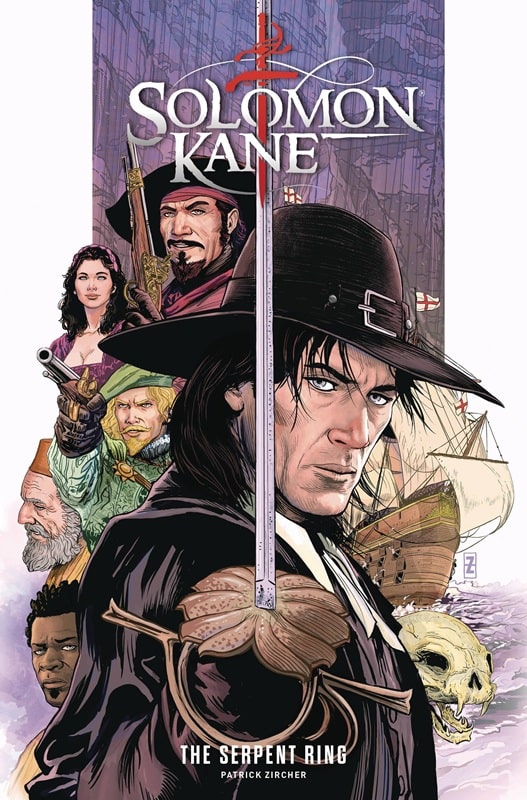
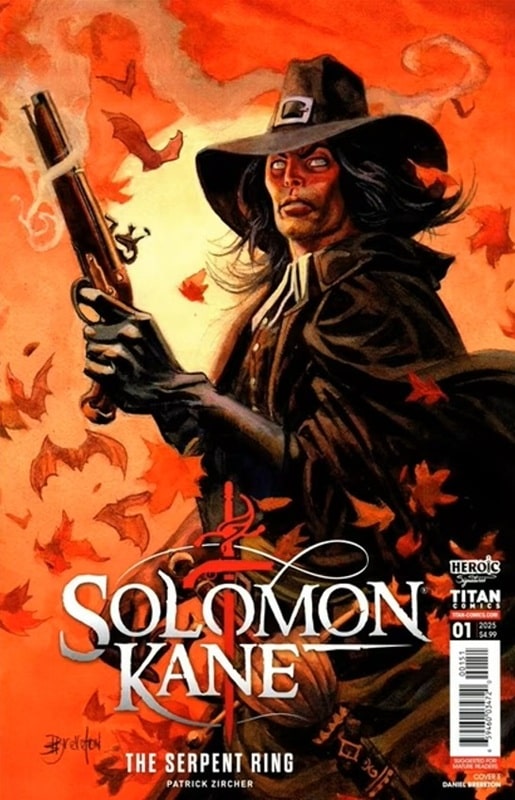
Solomon Kane: The Serpent Ring #1, and variant cover by Daniel Brereton (Titan Comics, March 26, 2025)
Sometimes a project and a creator are brought together in the right place at the right time. Titan Comics’ Solomon Kane mini series The Serpent Ring is one of those times. Writer/Artist Patrick Zircher is working at the very top of his game. The project is dear to his heart, and it shows.
The first issue begins, fittingly enough, in Africa. This would have pleased Kane’s creator Robert E. Howard, because some of REH’s best Kane tales, “The Footfalls Within,” “The Hills of the Dead,” “Wings in the Night,” etc, take place on that continent.
[Click the images to ring in bigger versions.]

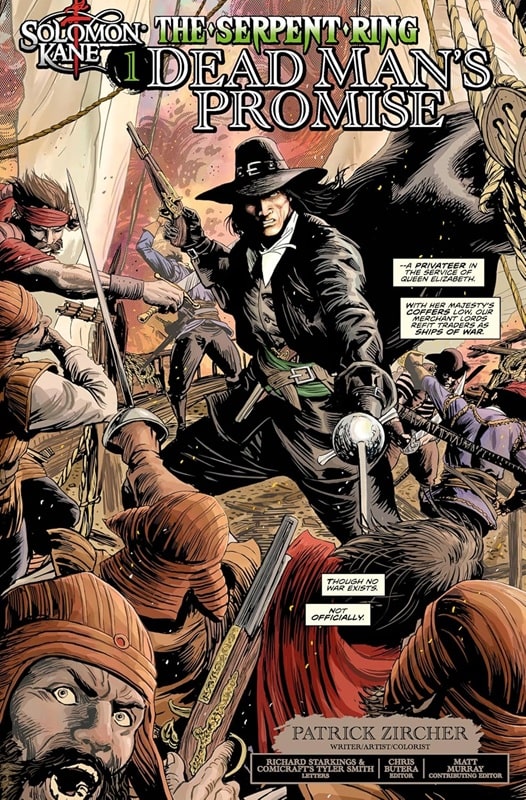
Interior art for Solomon Kane: The Serpent Ring #1 by Patrick Zircher
The first few pages of the comic are a prologue introducing some mysterious characters and incidents. We pick up with Solomon Kane three pages later, serving with a band of Queen Elizabeth’s privateers. Kane and his companions are in a pitched battle with the crew of a Spanish ship.
In an unfortunate occurrence Kane kills a passenger, ‘an innocent man,’ and makes a promise to the dying man to atone for his mistake. This sets the main plot in motion and Kane’s quest will take him from the Barbary Coast to Italy. On the way there will be swordfights, pistol battles, mysteries added to mysteries, and intimations of dark sorcery.
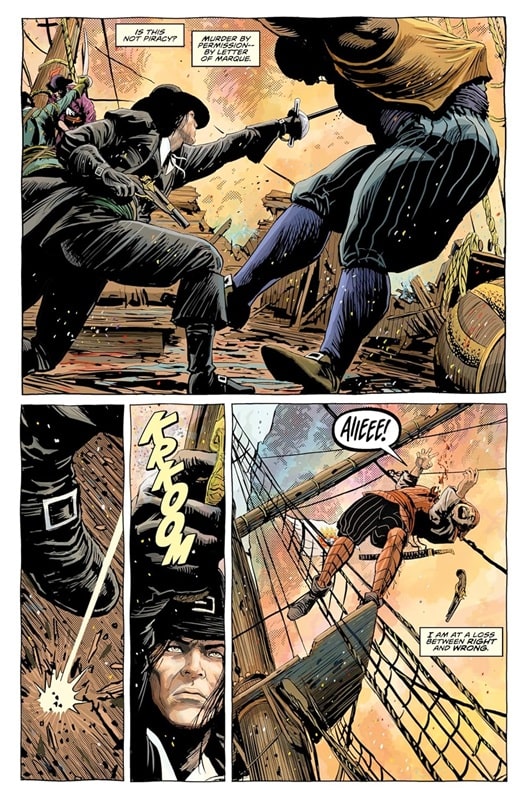
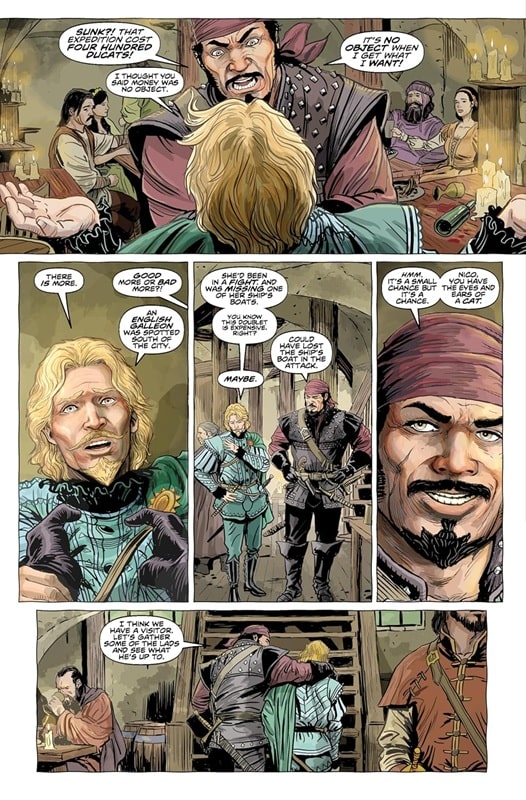
More interior art for Solomon Kane: The Serpent Ring #1 by Patrick Zircher
That’s all the plot I’ll give away, because you should read it for yourself, so let me talk a bit instead about Patrick Zircher’s work on the comic. Having spoken to Patrick online a good bit, I know this is one of his favorite comics he’s ever worked on. He’s a huge fan of Solomon Kane and it really comes through on the pages.
The story has an epic feel as it ranges around Europe, and a large cast of characters. All of that is well researched and beautifully illustrated, be it sailing ships or the streets of Napoli and Venice. Period costumes, weapons, and people are all extremely well done.

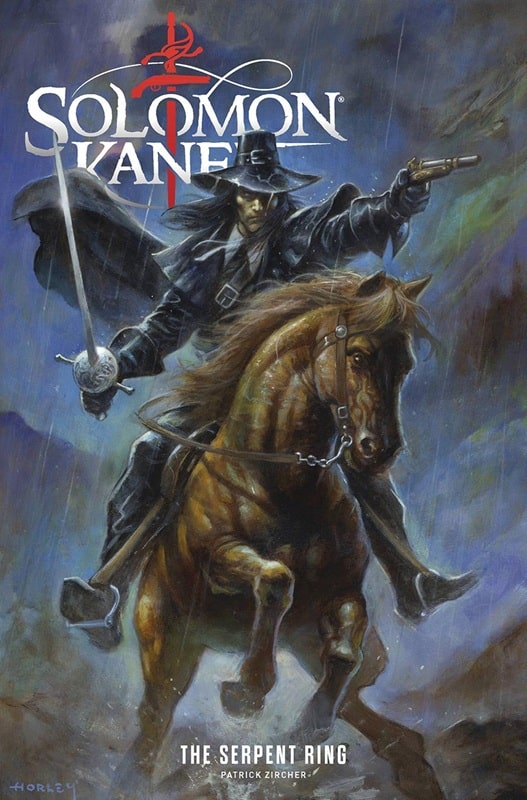
Issues #2 and #3 of Solomon Kane: The Serpent Ring. Covers by Rafael Kayanan and Alex Horley
For the Robert E. Howard fan this is prime stuff, Solomon Kane drawn and written by someone who loves the character and the world. It’s very much in the spirit of Howard’s work. I asked Patrick for a quote about his feelings working on the book and he said:
Solomon Kane embodies, in one character, what I love in stories. Action, adventure, suspense, horror, heroism, and wrestling with the ‘big questions’ of life.
Can’t ask for more than that.
Charles R. Rutledge lives in Atlanta, Georgia. This is his first article for Black Gate.
Women in SF&F Month: International Giveaway
I’m giving away one book of the winner’s choice for Women in SF&F Month today! Since there were some US-only giveaways earlier this month, this giveaway is for everyone else (though there are a few caveats given international shipping). Here’s how it works: You can choose your own adventure from the books/authors featured this month available on Kennys Bookshop, and I will ship the winner the book of their choice. This giveaway is open to anyone on the list of […]
The post Women in SF&F Month: International Giveaway first appeared on Fantasy Cafe.Oaths & Vengeance cover reveal
Teaser Tuesdays - A World Alone
Zombies! Very excited about diving into this one.
 THERE'S ONE IN THE HOUSE. The dragging thump of footsteps, somewhere downstairs, is what tips me off.
THERE'S ONE IN THE HOUSE. The dragging thump of footsteps, somewhere downstairs, is what tips me off.(page 1, A World Alone by R.K. Weir)
---------
Teaser Tuesdays is a weekly bookish meme, previously hosted by MizB of Should Be Reading. Anyone can play along! Just do the following: - Grab your current read - Open to a random page - Share two (2) “teaser” sentences from somewhere on that page BE CAREFUL NOT TO INCLUDE SPOILERS! (make sure that what you share doesn’t give too much away! You don’t want to ruin the book for others!) - Share the title & author, too, so that other TT participants can add the book to their TBR Lists if they like your teasers!
GUEST POST: What Fantasy Monsters Reveal about Our Deepest Fears by Caroline R.
 (Hyperion Japanese cover art)
(Hyperion Japanese cover art)Despite the genre’s escapist premise, fantasy literature often hosts cutting commentary on real-world issues. The monsters that terrorize these tales—from mythical beasts like the Kraken to the eerie walkers of today’s The Walking Dead—can symbolize humanity’s deepest fears and our most naked vulnerabilities. Through these creatures, fantasy stories have always held a mirror to the shifting anxieties of their eras. As an avid fantasy reader who worries constantly about our collective future, I’m interested in how fantasy monsters represent universal alarm—and how the stories that harbor these monsters continue to fulfill our ever-increasing need for escapist media.
The earliest mythical monsters in human history stemmed from the need to explain mysterious natural phenomena. The creatures of ancient myths often embody our most basic, physical fears: the violence other species, the destruction wrought by severe weather, humanity’s defenselessness against unthinking and uncontrollable natural forces. In ancient Greece, for instance, all meteorological occurrences—from prosperous harvests to devastating floods—were thought to be the direct result of godly intervention. The Greek gods were alternately merciless monsters and generous benefactors; they both caused and exacerbated humans’ powerlessness.
Some of the beings that populated classical myths were more straightforwardly monstrous, and these too represented fears inherent to human existence: the Minotaur, trapped in a labyrinth alone, represents the violent parts of human nature that emerge with isolation. The serpent-like hydra, with its multiple heads, could be said to embody chaos—the uncontrollable force of natural disasters, perhaps, or the seeming inevitability of war.
Many of these monsters can also be linked to moral and religious narratives. The Minotaur’s defeat by the hero Theseus could be said to symbolize the triumph of virtue over vice, a theme that appeared in ancient mythology and remains popular in fantasy literature today. The hydra, which is often associated with Ares, the god of war, sometimes represented punishment for moral failings, reminding us that ignoring religious or ethical obligations could trigger disastrous punishments. Thus, these early myths used monsters not only to explain the natural world, but also to prop up a moral framework.
 (THESEUS AND THE MINOTAUR by Barret Chapman)
(THESEUS AND THE MINOTAUR by Barret Chapman)As exploration and colonialism brought unfamiliar cultures into contact with each other for the first time, new fantasy monsters emerged to account for explorers’ fear of the unknown. Fantasy monsters developed during this era often symbolized the threats posed by unfamiliar territories, cultures, and species, embodying anxieties about difference. The Kraken of Nordic folklore offers an excellent example. A colossal, squid-like creature, the Kraken could pull down ships with its powerful tentacles. For European sailors during the Age of Exploration, the mythological Kraken symbolized the very real danger of the open sea.
Other fabled monsters were developed during this era to represent the indigenous peoples of colonized lands Ogres, cannibalistic giants, and other “savage” human-like creatures populated stories like The Travels of Sir John Mandeville, a fictional 14th-century travelogue that describes various monstrous beings believed to inhibit the New World. These "monstrous races”, which include “dog-headed Cynocephales” and “one-legged Sciapods”, mirrored appearance-based prejudices against native peoples.
Unlike the religious mythology of classical societies, stories that emerged during this era were more explicitly fictional. The fictional form gave writers license to exaggerate stereotypes that portrayed indigenous people as grotesque barbarians, reinforcing the fear and misunderstanding that often accompanied encounters between European explorers and native populations. This fear was not only of physical harm, but also of contamination wrought by cultural difference. Narratives of the time often portrayed European explorers or settlers as the heroic figures who, by defeating these monsters, demonstrated the superiority of their culture and values.
As we’ve seen, the development of fantastical monsters has always been rooted in real fears. This continues today, with fantastical monsters in literature reflecting the complex existential woes of modern people. As technology has advanced, social structures and global concerns have shifted, and so too have the monsters that embody these concerns. Now, many fantasy monsters represent common fears of environmental degradation, political collapse, and social injustice.

One compelling example of this is Blood Over Bright Haven by M.L. Wang. The story’s villain—who I won’t reveal, since you should read the book yourself—causes the protagonist to wonder whether she can trust anyone. The villain’s conniving manipulation, and the unjust magical system of the setting, both parallel modern distrust in authority and misuse of power.
In many modern fantasy narratives, the villains represent worst-case scenarios that humanity dreads: unchecked corruption (represented by the Darkling from Shadow and Bone), fear of being forgotten (represented by the veil in The Invisible Life of Addie LaRue) and the devastation wrought by modern warfare (represented by the tyrants in The Poppy War). These creatures mirror real-world fears and anxieties, but the narratives where they appear often provide a kind of hope—usually, despite the worst, the protagonists of these stories emerge victorious and some form of justice is served.
Those happy endings are what allow modern fantasy to maintain its escapist allure, even when it contains allusions to very real social ills. Generally, fantasy books and series end with something of a happy conclusion: the protagonist tends to vanquish the monster; the world tends to return to some semblance of order; the villains tend to end up dead or exiled. In a world where these just endings are so rare, reading fantasy allows us to indulge in satisfying depictions of the justice we don’t see in real life.
Thus, fantasy’s use of realistic monsters does not betray its escapist properties, but bolsters them. It wouldn’t be interesting to read about a world in which everything is perfect all the time, but it can be exciting and validating to read about a world in which grit and determination can lead to meaningful social change.
The journey from ancient myth to modern fantasy reflects a shift in our relationship to reality. In early mythologies, monsters were believed to be real, physical embodiment of the unknown and unexplainable forces of nature. They were creatures to be respected and feared, forcing humans to recognize the limits of their knowledge and physical ability. As our understanding of the world expanded, these monsters were gradually relegated to the realm of fiction, appearing in explicitly fictional narratives that allowed us to confront our fears from a safer distance. While most people no longer believe in dragons or sea monster, their symbolic power hasn’t been diminished.
The monsters that populate fantasy literature have always been imaginative and otherworldly, but their significance goes far beyond simple escapism or entertainment. Through these creatures, and the characters’ reactions to their violence, fantasy can often elucidate something insightful about the real world. From the ancient monsters that represented natural threats to the modern creatures that reflect existential dread, fantastical villains can all teach us something about the most profound aspect of the human condition. They give voice to the darkness within and without, reflecting both evolving external threats and timeless internal struggles.
But, despite the terrifying nature of these creatures, the genre itself remains fundamentally optimistic, offering visions of triumph against every kind of evil. While the real world often feals messy and unjust, these stories offer a reassuring sense of order. Many of us feel powerless to confront the monsters we encounter every day—the dangers of unchecked authority, the collapse of social systems, and the degradation of the environment, to name a few—but fantasy provides a safe space to confront these fears.
At their core, fantasy monsters aren’t just symbols of our fears—they’re also reflections of the human condition. They show us the darkness we often try to ignore, but also offer hope that, despite our vulnerabilities and flaws, we can overcome existential challenges. By confronting these monsters in stories led by fearless protagonists, we learn more about our own fears—and how we can rise above them.

Author bio: Caroline is a writer for Reedsy and NowNovel who covers everything from the nitty-gritty of the writing process to the business of finding ghostwriting jobs. When she isn’t writing, Caroline loves reading indie books and spending time outdoors.
Book review: When the Moon Hits Your Eye by John Scalzi

Book links:
ABOUT THE AUTHOR:
Publisher: Length: Formats:
The moon turns into cheese. Not metaphorically. Not in a dream. Like, literally. One day it’s the regular rock-ball we all know and ignore, and the next, it’s dairy. That’s the book. That’s the premise. I rolled my eyes too. But then I started reading, and - well, I ended up liking it more than I thought I would. More than I probably should’ve, honestly.
This is John Scalzi doing what he does best - taking a totally absurd idea and running with it. The moon becomes cheese (type undetermined). People react. Some panic, some scheme, some try to monetize it, some go to church. And through it all, Scalzi’s trademark mix of snark, satire, and sneaky emotional depth holds the whole gooey mess together.
There’s not really a central protagonist here-unless you count humanity in general, or maybe capitalism. Instead, we bounce around between a rotating cast of scientists, astronauts, cheese mongers, billionaire tech bros, diner regulars, and one very cursed Saturday Night Live episode. It's like a disaster movie crossed with a sociology paper, but funnier and with more dairy puns.
The plot meander a a bit and I admit I did I lose track of a few characters. But the short chapters kept things moving, and there’s something irresistible about how this book doesn’t try to be anything other than what it is: a ridiculous thought experiment with a surprising amount of insights into human behavior.
If you’ve read Kaiju Preservation Society or Starter Villain and enjoyed the vibes, you’ll probably enjoy this one too. If you haven’t, but the idea of “slice-of-life apocalypse, but make it cheese” sounds appealing, you might be in for a good time. Just don’t come in expecting hard sci-fi. This is soft cheese fiction. And that’s kind of the point.
THE GHOST WOODS by C.J. Cooke
Book Review: The Ghost Woods by C.J. Cooke
I received a review copy from the publisher. This does not affect the contents of my review and all opinions are my own.
Mogsy’s Rating: 4 of 5 stars
Genre: Historical Fiction, Horror
Series: Stand Alone
Publisher: Berkley (April 29, 2025)
Length: 384 pages
Author Information: Website
This is the fifth book I’ve read by C.J. Cooke, and I think her writing and storytelling just keep getting better and better. The Ghost Woods has quickly become one of my new favorites by the author, second only to A Haunting in the Arctic. Once more, readers are transported to a historical setting where the atmosphere is thick with tension and mystery—with just a touch of the supernatural—and the emotional depth of the characters takes center stage.
In The Ghost Woods, Cooke returns to Scotland’s misty and isolated countryside to spin a tale exploring themes of motherhood and life altering decisions. Set in 1959 and in 1965, the novel follows two women who finds themselves at Lichen Hall, a home for unwed pregnant girls. Mabel is first to arrive in the earlier timeline, frightened and confused because she has no idea how she got pregnant, and no one believes her even though she swears she has never been with a man. Several years later, Pearl makes the same journey to the old mansion in preparation for the birth of her baby, the result of a careless one-night stand following a split from her long-term boyfriend. After losing her nursing job because of it, Pearl’s family thought it would be best for her to lay low until she gives birth.
While Mabel and Pearl come from very different backgrounds, both women come to similar conclusions about Lichen Hall. It is a strange and eerie place, hidden in the woods far from the nearest town and hospital. Many parts of the house are in disrepair, with mold permeating the walls. The property belongs to the Whitlock family, but it is Mrs. Whitlock who clearly runs the show, as old Mr. Whitlock is ill and mostly bedridden, kept out of sight. Also living with them is their grandson, a trouble young man who makes some of the girls staying at the home uncomfortable. As hosts, the Whitlocks are cagey and seemingly hiding some secret knowledge about their huge crumbling mansion, in which Mable, Pearl, and the other women shut away there find themselves trapped.
Like all of Cooke’s other novels, The Ghost Woods excels in atmosphere. Lichen Hall is a character unto itself—distinct with its own unique personality, and that personality to malevolent and threatening. The women, already feeling alone and vulnerable because of their conditions, are made even more anxious knowing Mrs. Whitlock does not believe in outside help. The lady of the house is a mysterious character, kind and comforting one moment, cold and cruel the next. Whatever her motives though, she is adamant that no doctor will ever be called, so the young expectant mothers can only rely on each other. This gives the story a claustrophobic and oppressive vibe, where among the vivid descriptions of the encroaching forest, nothing feels entirely safe.
The plot also employs dual timelines, which I felt was mostly effective. Being relatively close in time, however, sometimes the two threads blurred, especially once Mabel and Pearl’s perspectives came together and intertwined later in the book. The slow build at the beginning also made those early chapter the most challenging, but pacing improves once the story introduces more characters and gives the chance for the horrors at Lichen Hall to develop.
There’s also the slight issue of too many things happening at once, to the point where I feel some of the more minor story threads were not satisfactorily resolved. However, the answer to the most important mystery as well as the twist at the end of the book helped make up for it and made me more forgiving of any loose ends. In fact, the abundance of ideas and themes added overall to the novel’s rich layered feel, even if I would have welcomed a bit more tightening.
All in all, C.J. Cooke delivers another chilling and atmospheric tale in The Ghost Woods, and I think both fans of her previous work as well as new readers will find plenty to love here. This is gothic horror at its finest. Also highly recommended if you enjoy broody historical fiction with a touch of the fantastical, such as influence from fairytales and folklore, or simply unearthly ways of looking at the natural world.
![]()
![]()

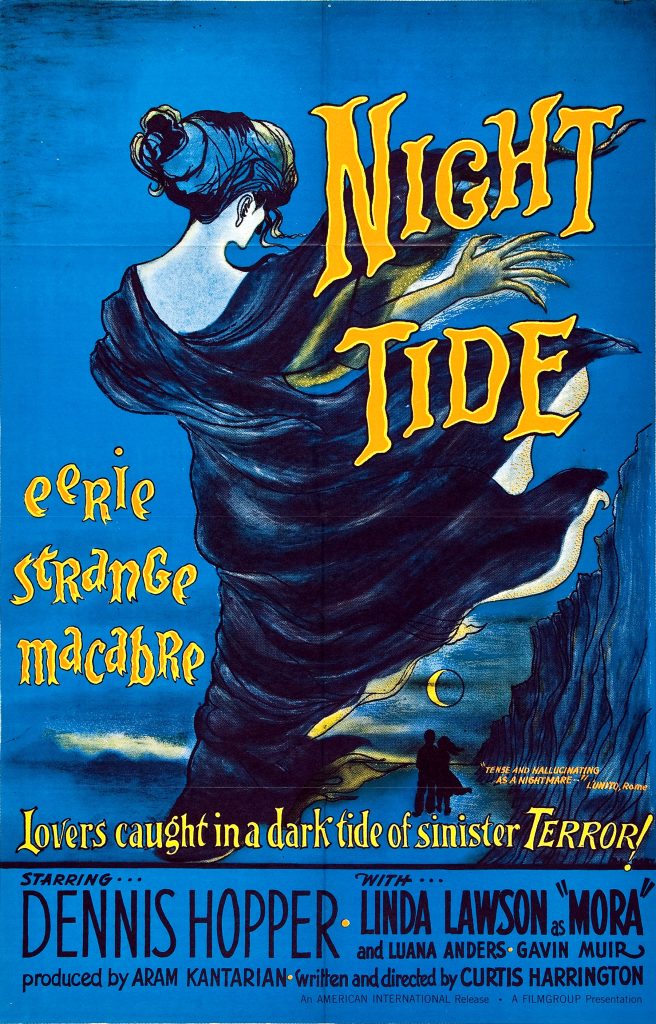

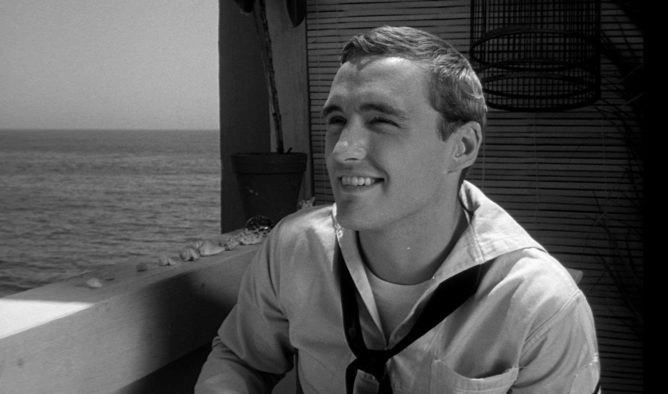
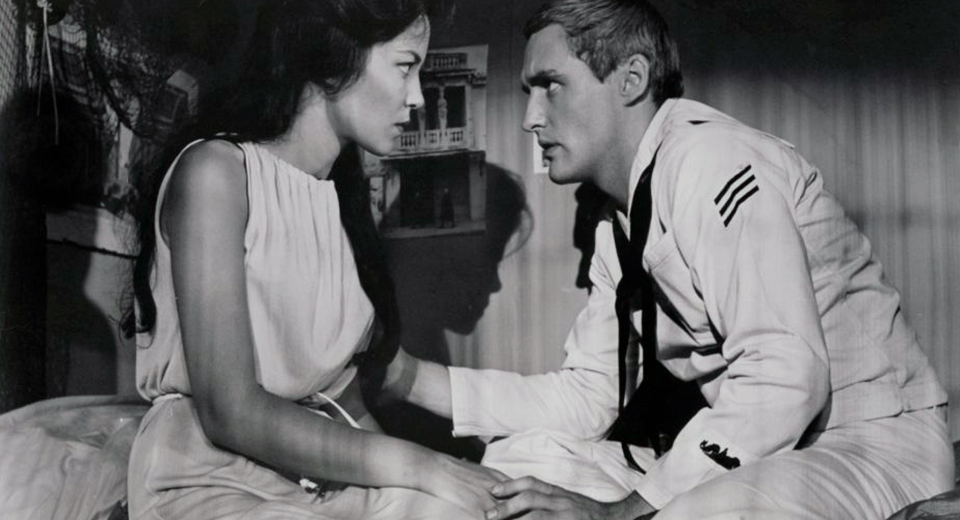
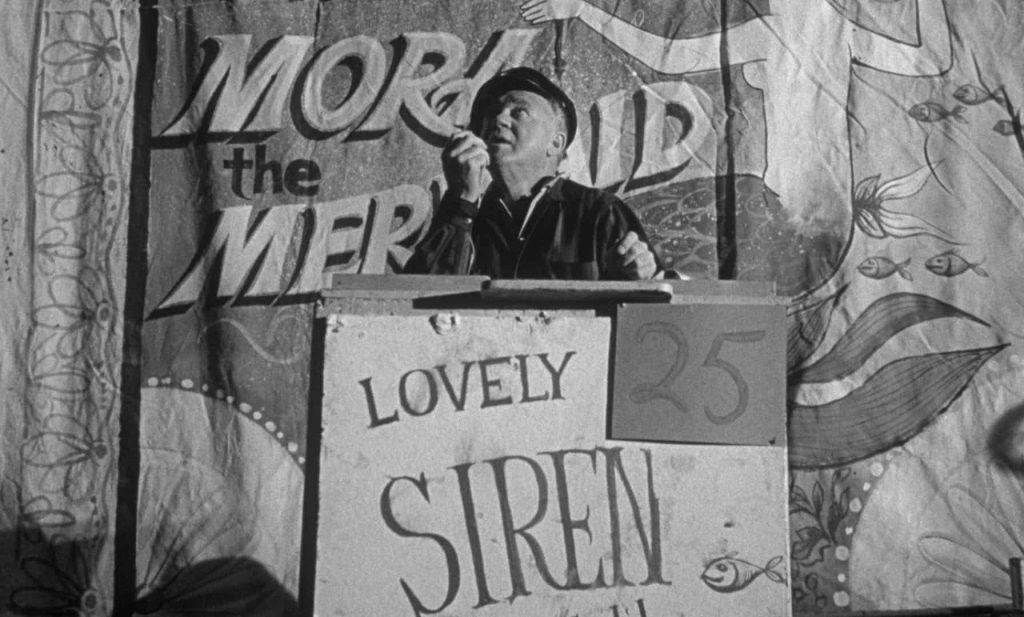

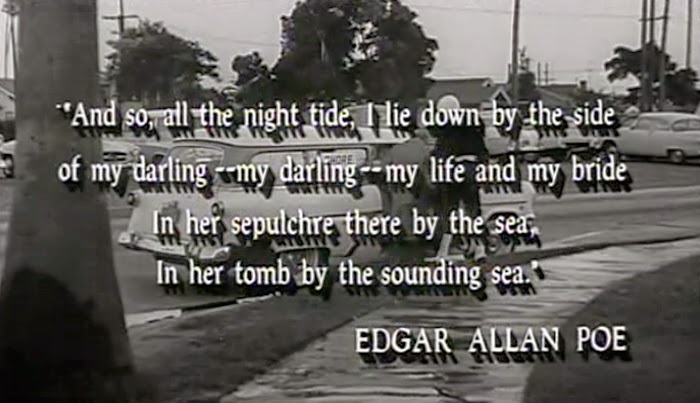

Recent comments